inbox and environment news: Issue 593
August 6 - 12, 2023: Issue 593
Time Of Wiritjiribin
August
Female Lyre bird - Elanora Heights
Photo by Selena Griffith, May 29 2023
Selena says ''this one followed me along the path. Never been so close.''
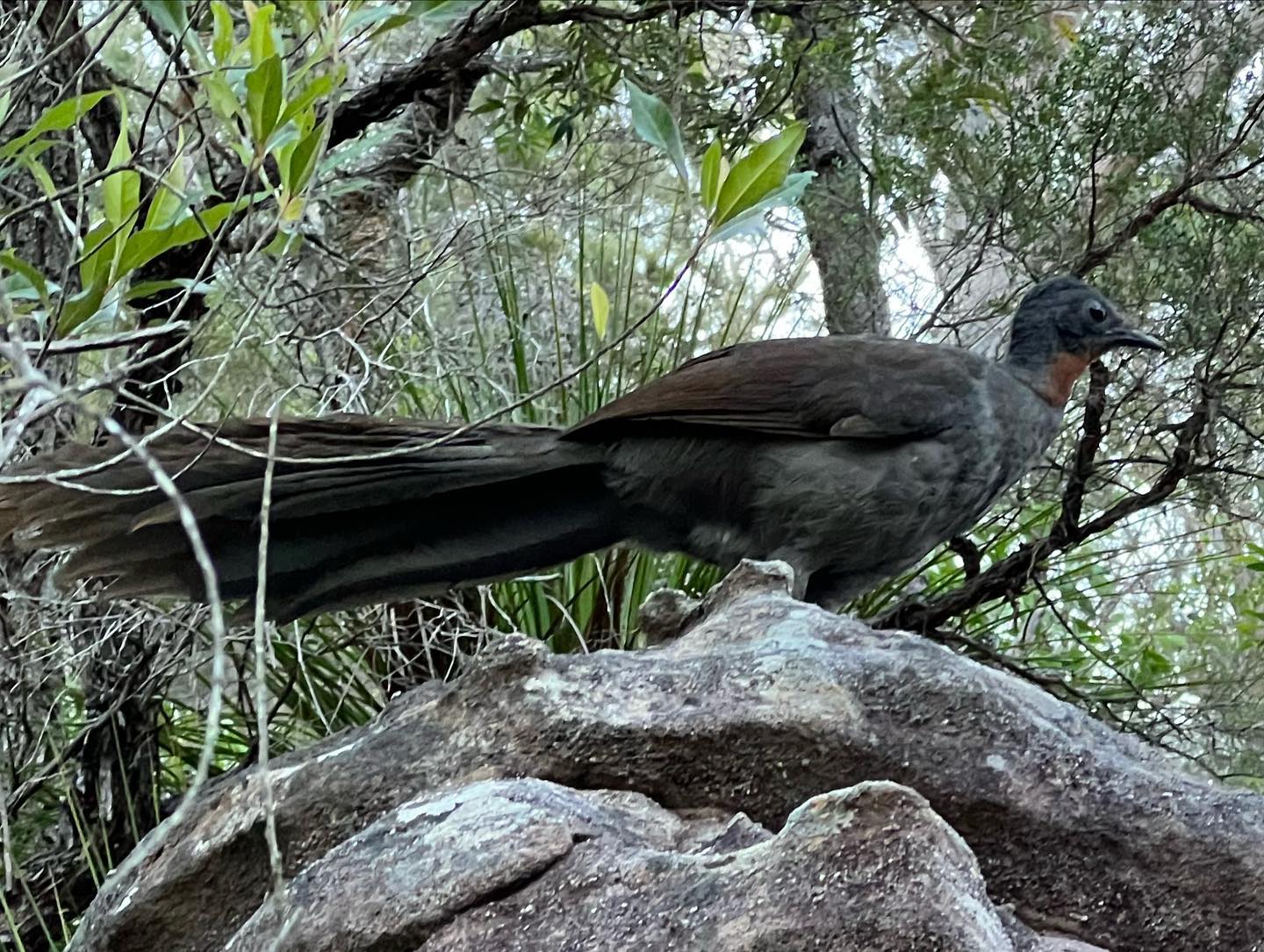
Bushcare Training Day At North Narrabeen
- Weed identification and best practice removal techniques
- Native plant identification and weed species including lookalikes
- Hands-on weed removal
- Bring along your unknown plant species for identification
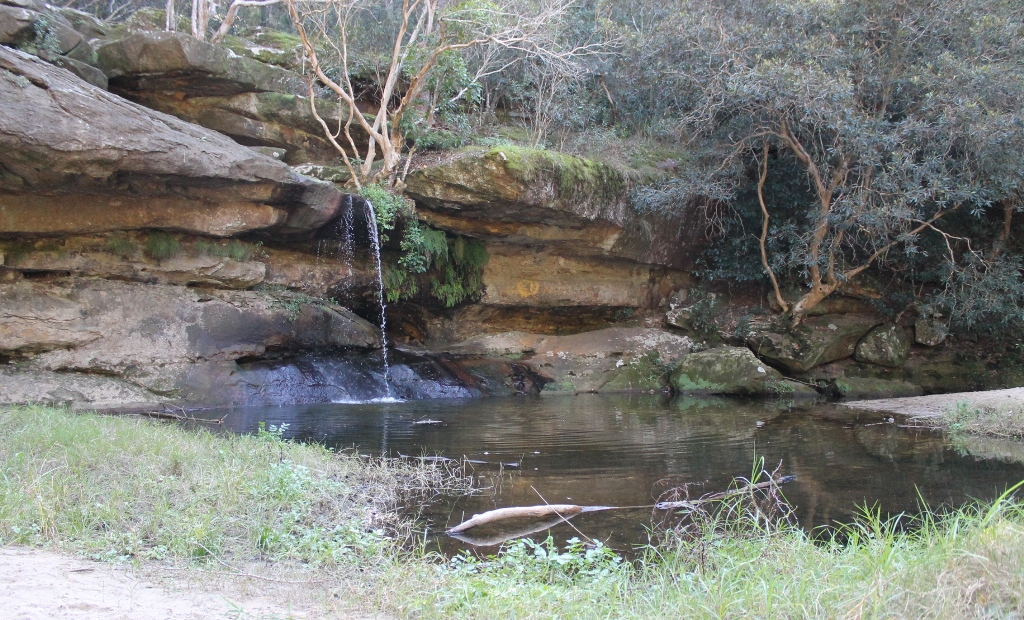
Palmgrove Park Avalon: New Bushcare Group Begins
 Palmgrove Park Avalon is a remnant of the Spotted Gum forest that was once widespread on the lower slopes of the Pittwater peninsula. This bushland’s official name and forest type is Pittwater and Wagstaffe Endangered Ecological Community, endangered because so much has been cleared for suburban development. Canopy trees, smaller trees and shrubs, and ground layer plants make up this community. Though scattered remnant Spotted Gums remain on private land, there is little chance of seedlings surviving in gardens and lawns. More information HERE
Palmgrove Park Avalon is a remnant of the Spotted Gum forest that was once widespread on the lower slopes of the Pittwater peninsula. This bushland’s official name and forest type is Pittwater and Wagstaffe Endangered Ecological Community, endangered because so much has been cleared for suburban development. Canopy trees, smaller trees and shrubs, and ground layer plants make up this community. Though scattered remnant Spotted Gums remain on private land, there is little chance of seedlings surviving in gardens and lawns. More information HERE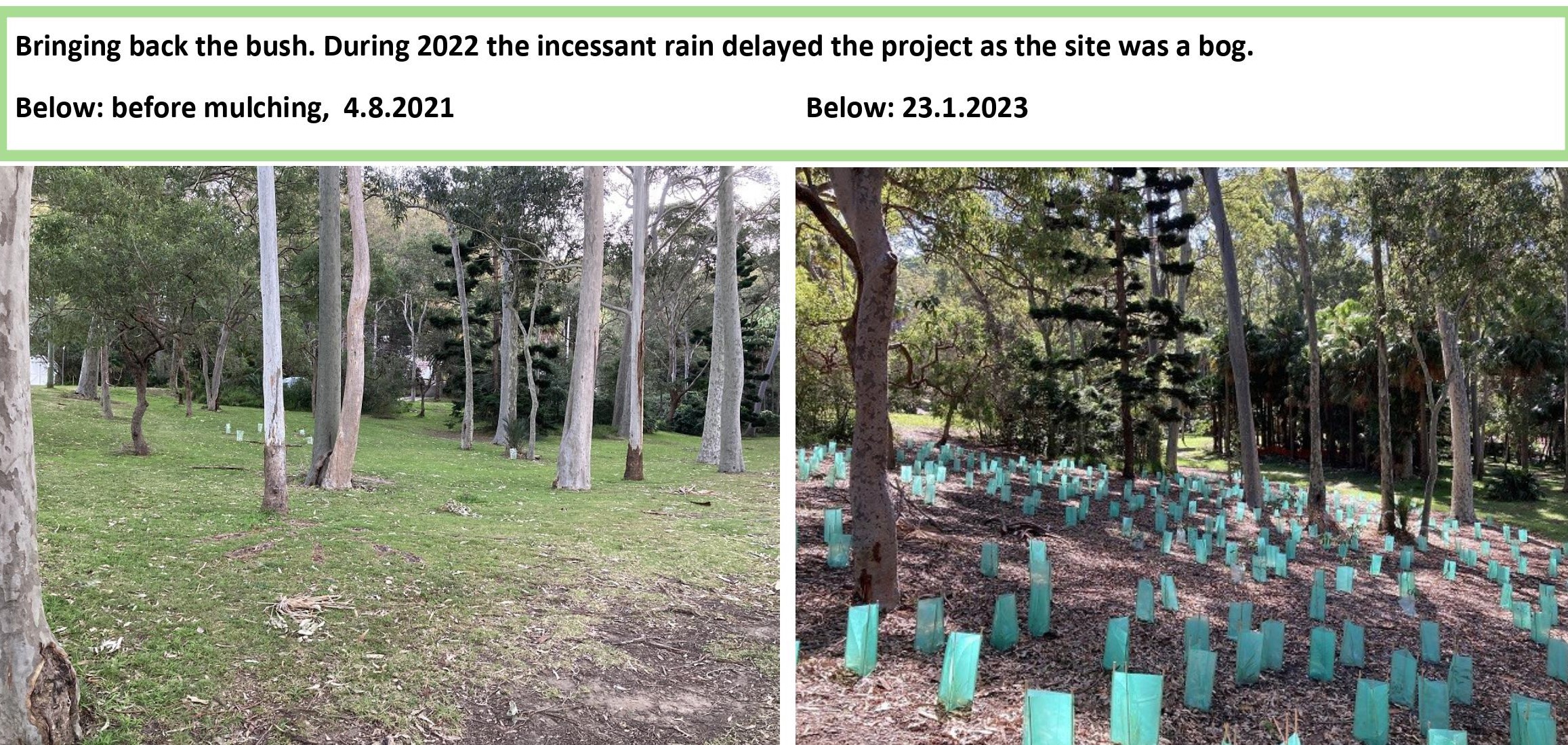
2023 Banksia Foundation NSW Sustainability Awards Open For Nominations
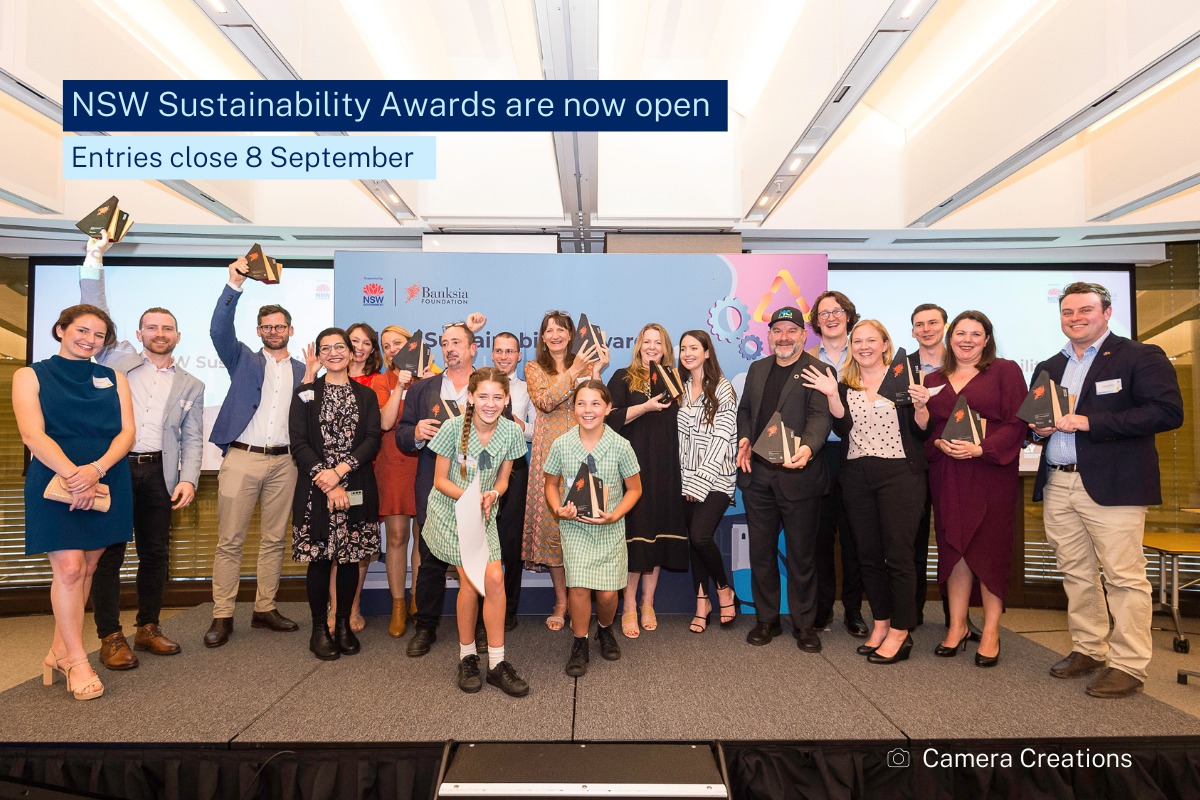
Pittwater Garage Sale Trail Returns: Repurpose Your Items

Northern Beaches Clean Up Crew: Sunday August 27 2023 From 10:00-12:15 - Turimetta Beach Clean Up
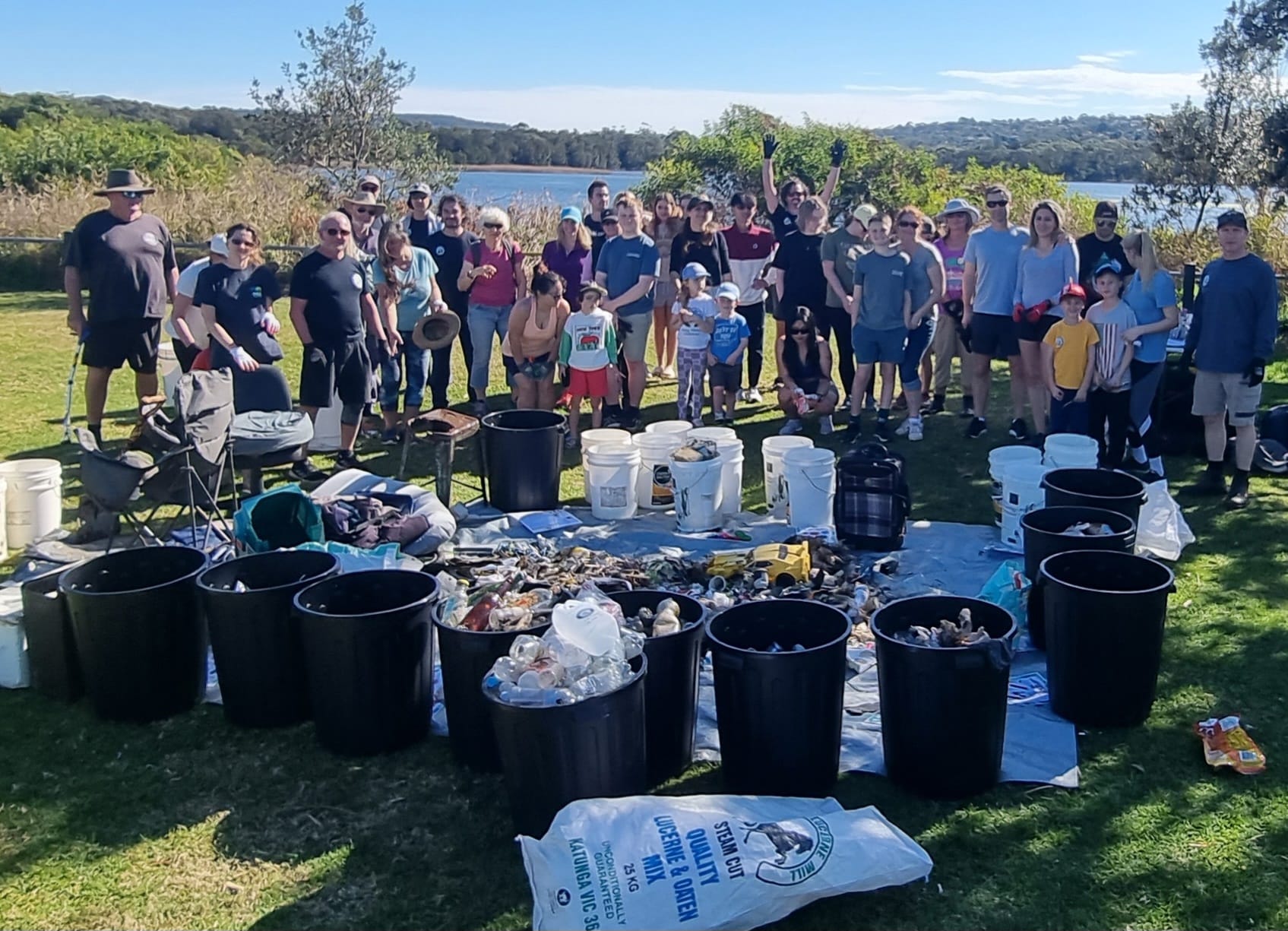
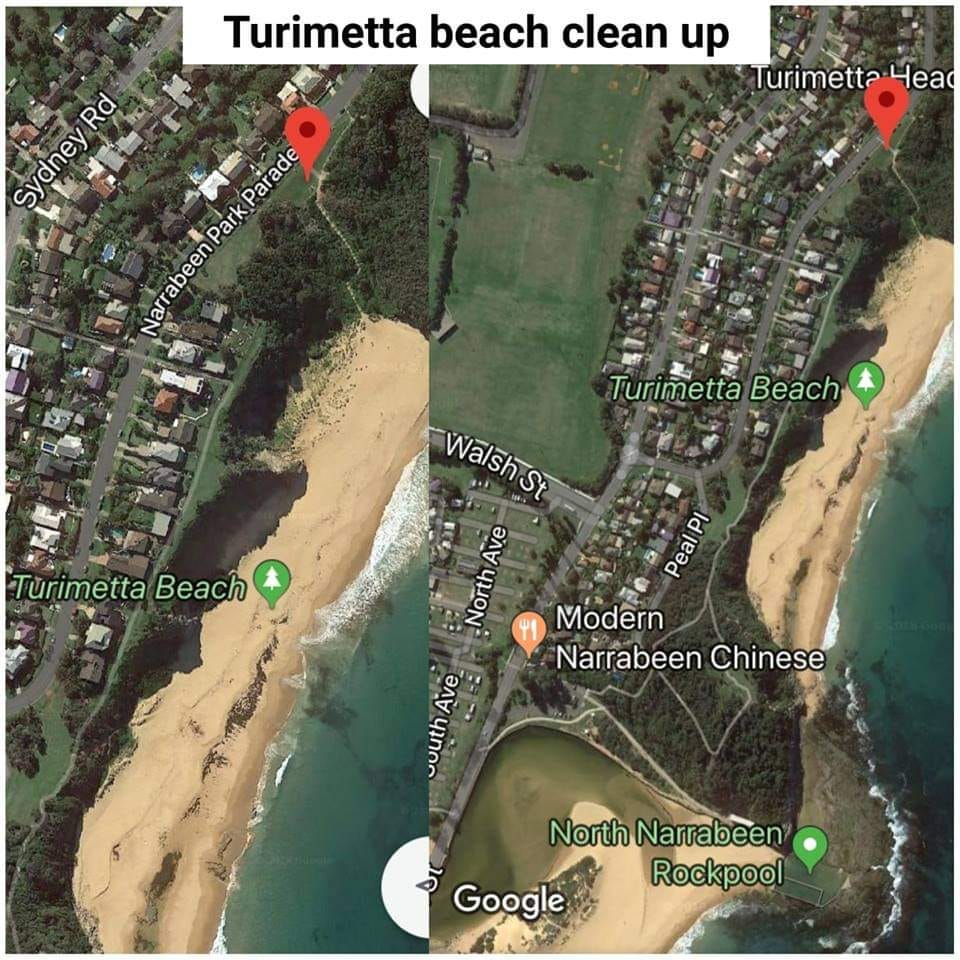
Waste And Sustainability In Schools NR37040: At Kimbriki
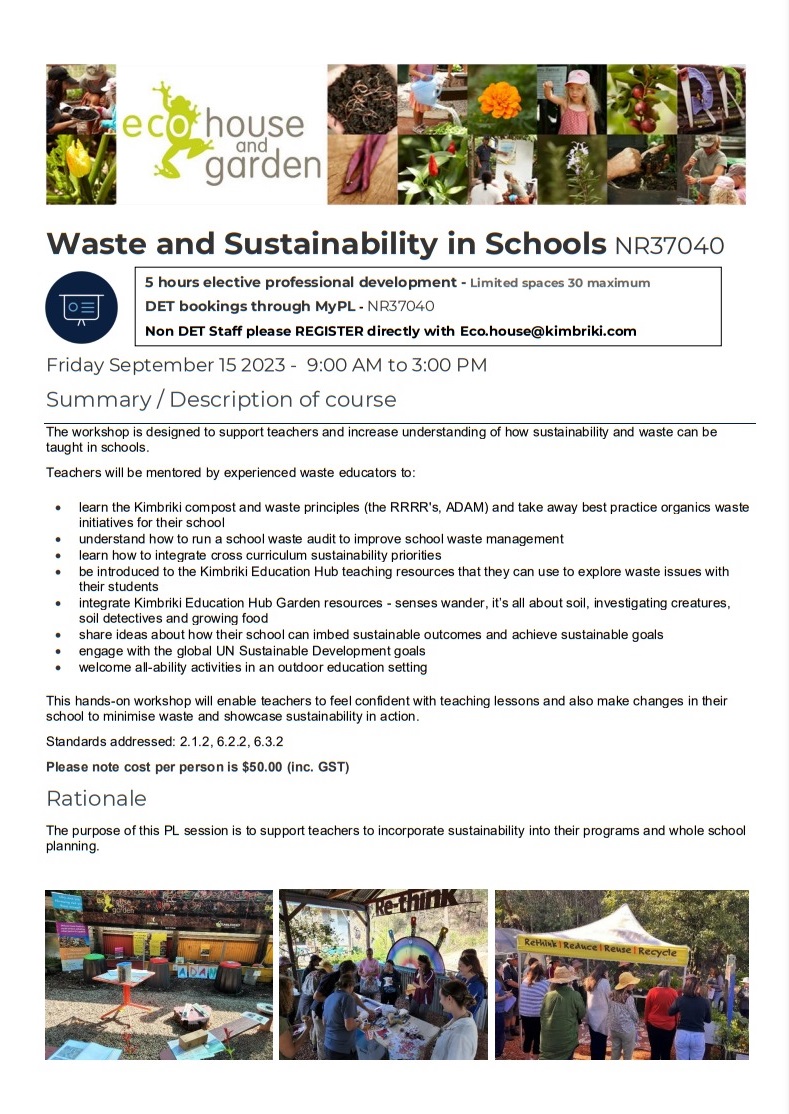
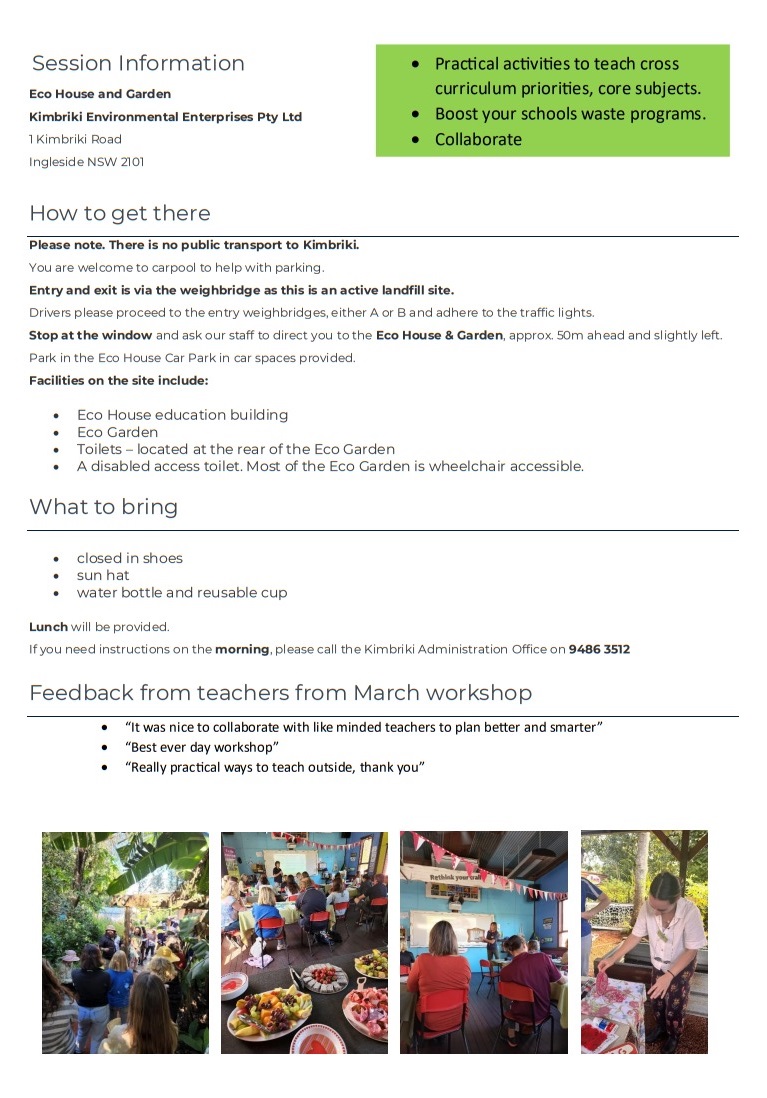
Seen Any Glossies Drinking Around Nambucca, Bellingen, Coffs Or Clarence? Want To Help?: Join The Glossy Squad
- a female bird (identifiable by yellow on her head) begging and/or being fed by a male (with plain black/brown head and body and unbarred red tail feathers)
- a lone adult male, or a male with a begging female, flying purposefully after drinking at the end of the day.

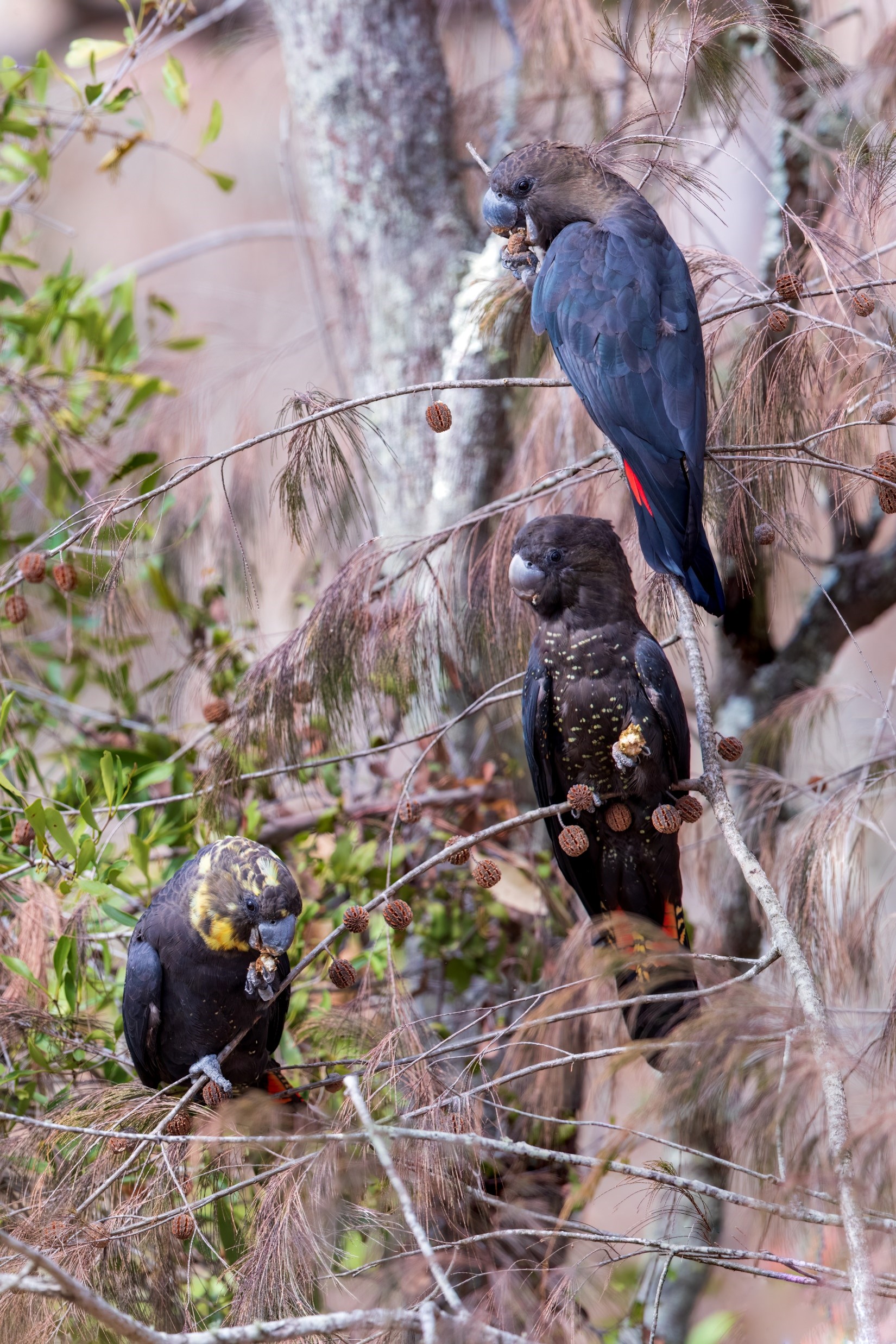
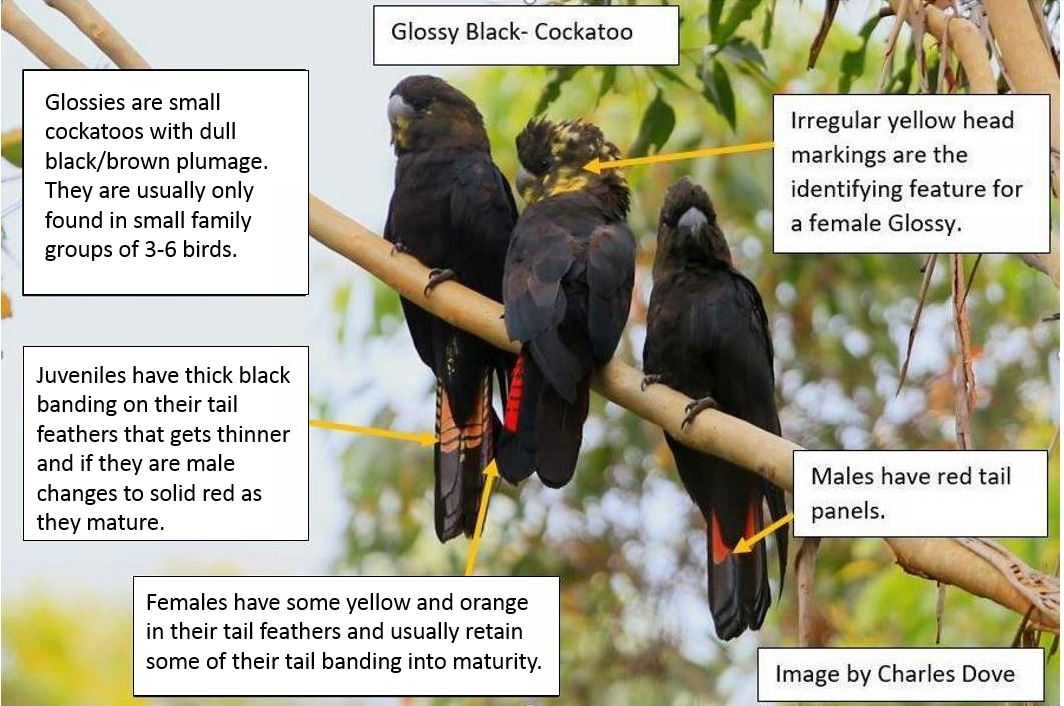
NSW Clearing 640 Football Fields Of Land Per Day: The Majority Unexplained
NSW Land Clearing Data Released
- 15% increase for agricultural
- 35% decrease for native forestry harvesting
- 21% decrease in clearing for infrastructure.
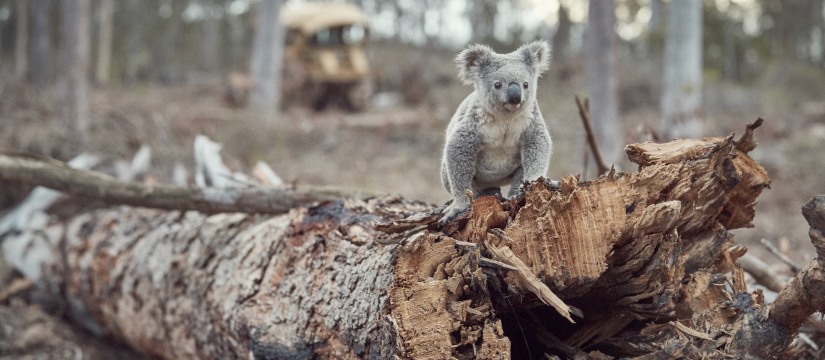
Forestry Corp Taking A Wrecking Ball To Gumbaynggirr Culture And The Great Koala National Park
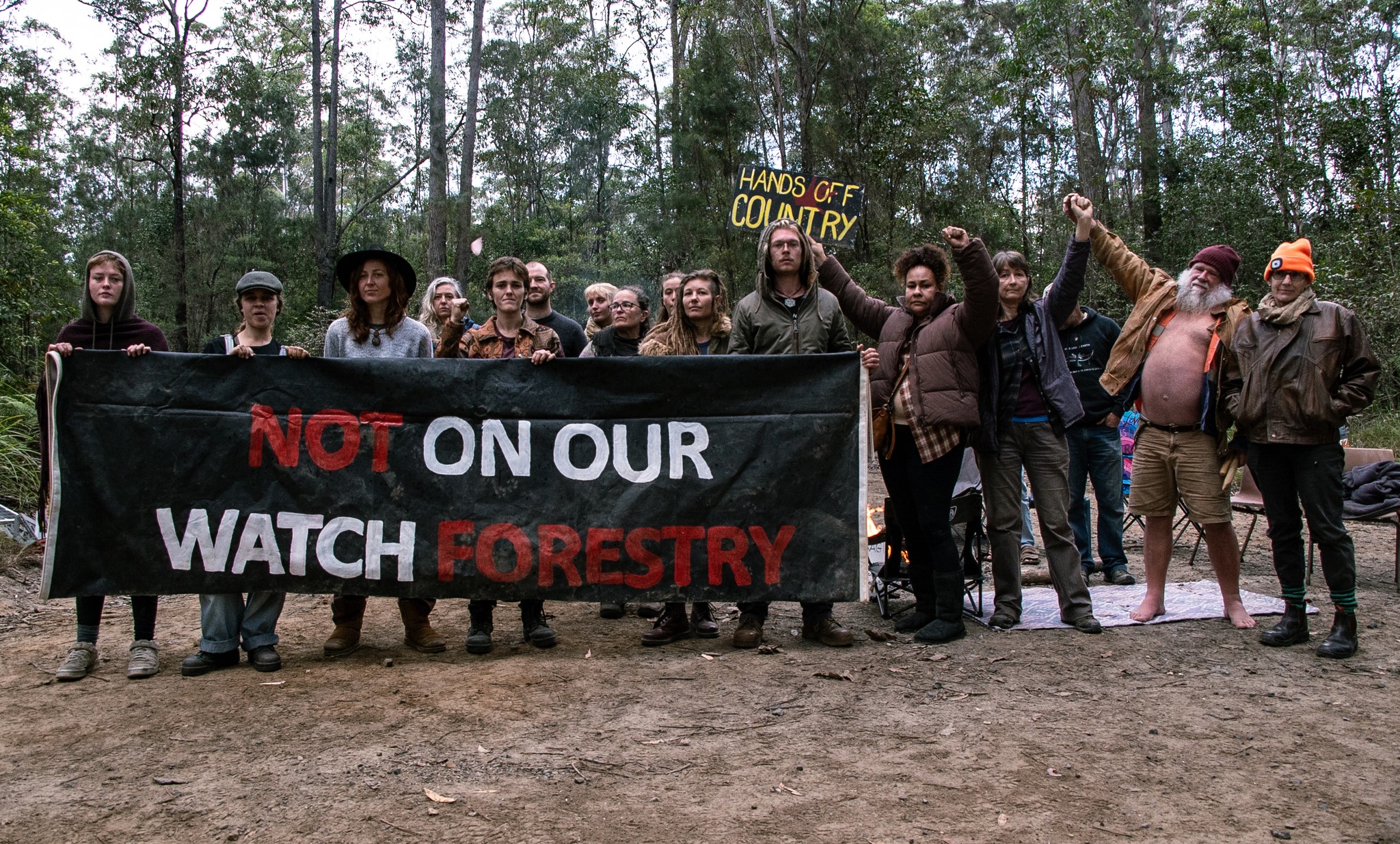
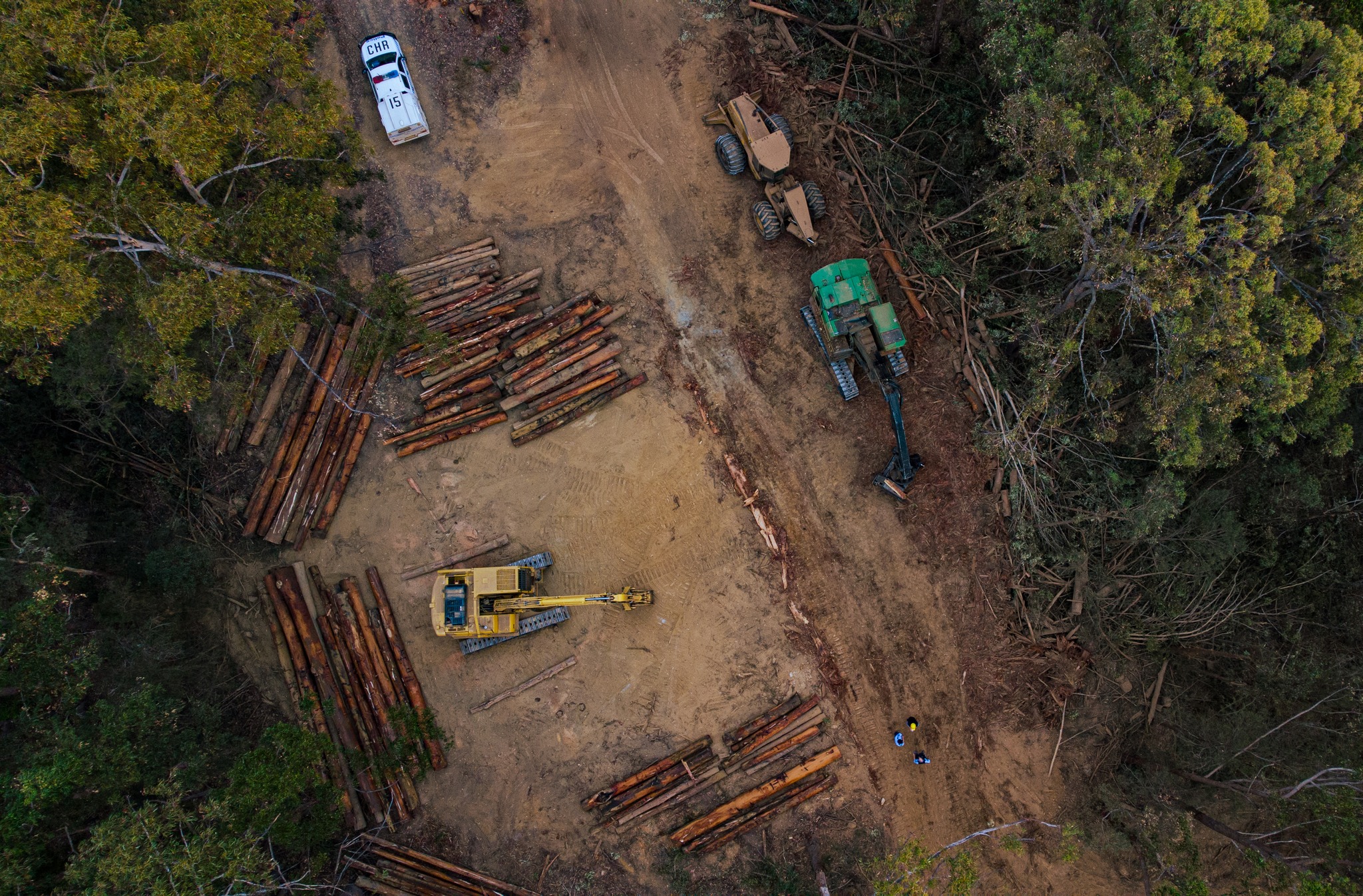
80-Plus Groups Worldwide Demand End To Greenwashing Maugean Skate Extinction With Farmed Salmon Accreditations
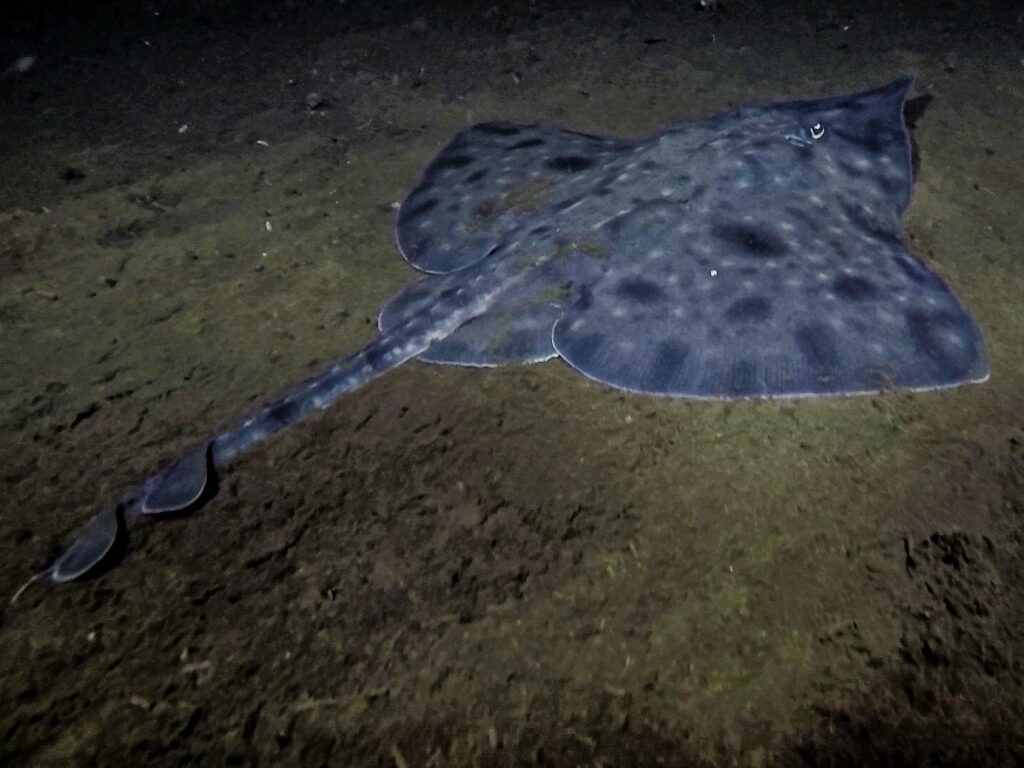
Critically Endangered Fledgling Hooded Plover Takes Long Haul Flight To North Coast
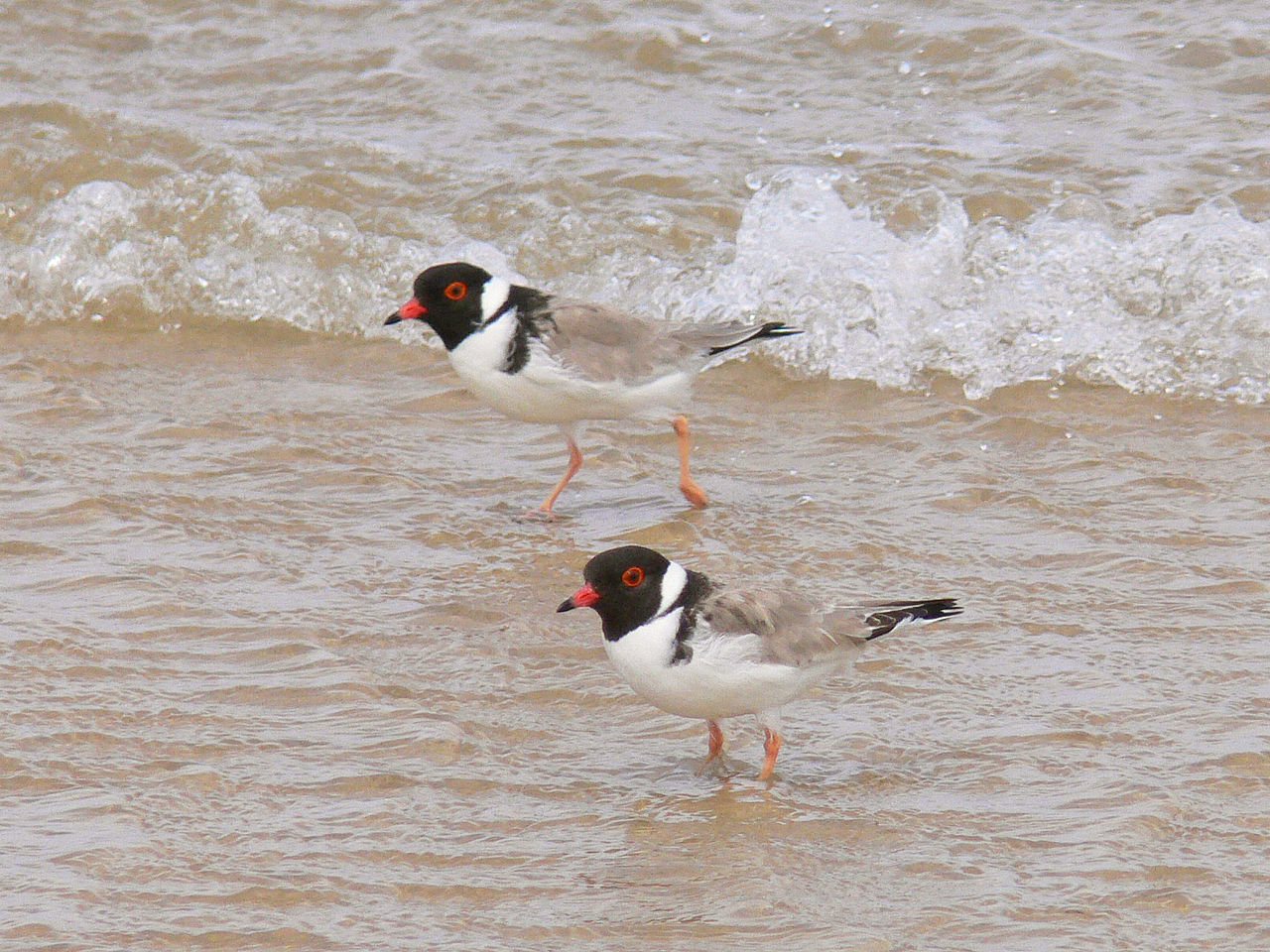
New Outback Park In NSW Protects Important Wetlands
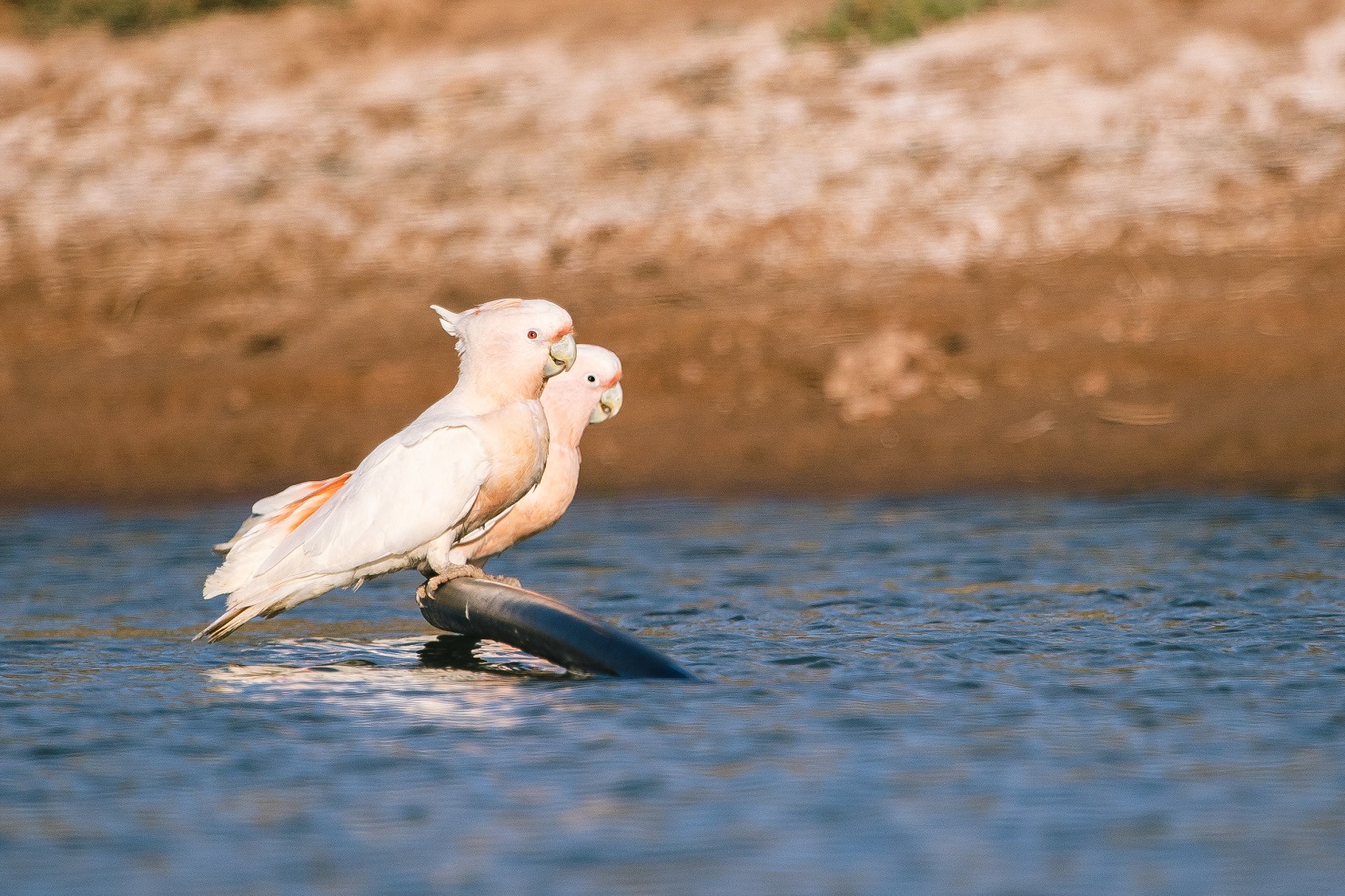
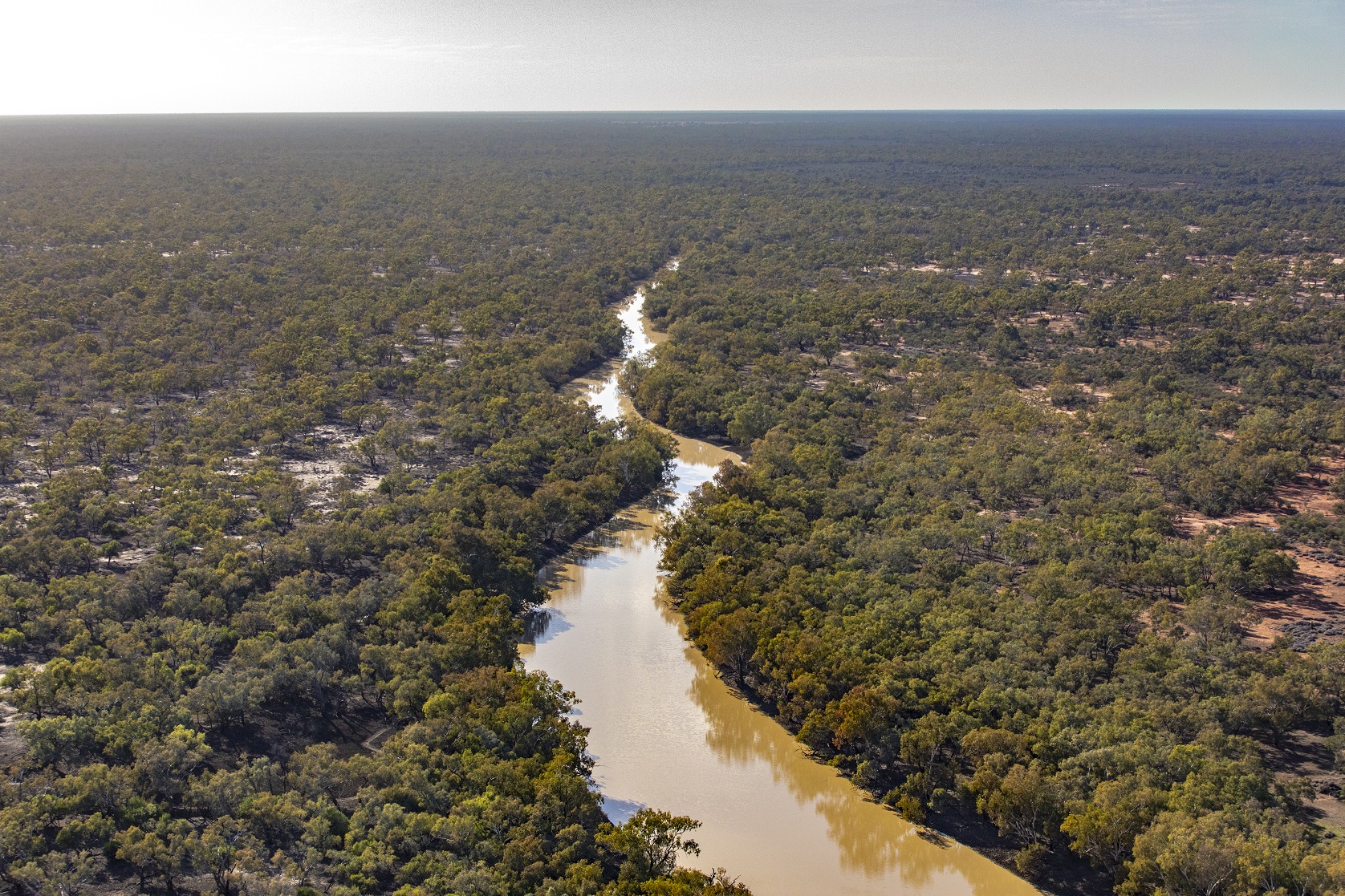
Blue Mountains National Park And Kanangra-Boyd National Park Draft Plan Of Management: Public Consultation
- improving recognition of the parks significant values, including World and National Heritage values, and providing for adaptive management to protect the values
- recognising and supporting the continuation of partnerships with Aboriginal communities
- providing outstanding nature-based experiences for visitors through improvements to visitor facilities - including:
- Opportunities for supported or serviced camping, where tents and services are provided by commercial tour operators, may be offered at some camping areas in the parks
- Jamison Creek, Jamison Valley Walk-in camping Potential new camping
- Leura Amphitheatre Jamison Valley Walk-in camping Potential new camping
- Mount Solitary Jamison Valley Walk-in camping Potential new camping
- Maxwell’s HuC Kedumba Valley Cabin/hut Potential new accommodation
- Kedumba Valley Maxwell’s Hut (historic slab hut) - Building restoration in progress; potential new Accommodation for bushwalkers
- Government Town Police station; courthouse - Potential new Visitor accommodation
- write clearly and be specific about the issues that are of concern to you
- note which part or section of the document your comments relate to
- give reasoning in support of your points - this makes it easier for us to consider your ideas and will help avoid misinterpretation
- tell us specifically what you agree/disagree with and why you agree or disagree
- suggest solutions or alternatives to managing the issue if you can.
Plans For New Wind Energy Project At Spicers Creek On Public Exhibition
Green Light For Two New Batteries To Help Secure Power For 100,000 Homes
NSW Landholders To Be Rewarded For Private Land Conservation

Areas Closed For West Head Lookout Upgrades
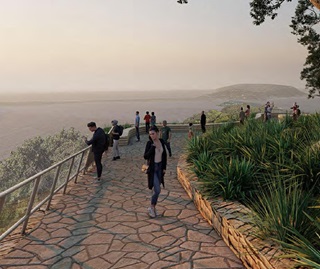 NPWS advise that the following areas are closed from Monday 22 May to Thursday 30 November 2023 while West Head lookout upgrades are underway:
NPWS advise that the following areas are closed from Monday 22 May to Thursday 30 November 2023 while West Head lookout upgrades are underway:
- West Head lookout
- The loop section of West Head Road
- West Head Army track.
Vehicles, cyclists and pedestrians will have access to the Resolute picnic area and public toilets. Access is restricted past this point.
The following walking tracks remain open:
- Red Hands track
- Aboriginal Heritage track
- Resolute track, including access to Resolute Beach and West Head Beach
- Mackeral Beach track
- Koolewong track.
The West Head lookout cannot be accessed from any of these tracks.
Image: Visualisation of upcoming works, looking east from the ramp towards Barrenjoey Head Credit: DPE
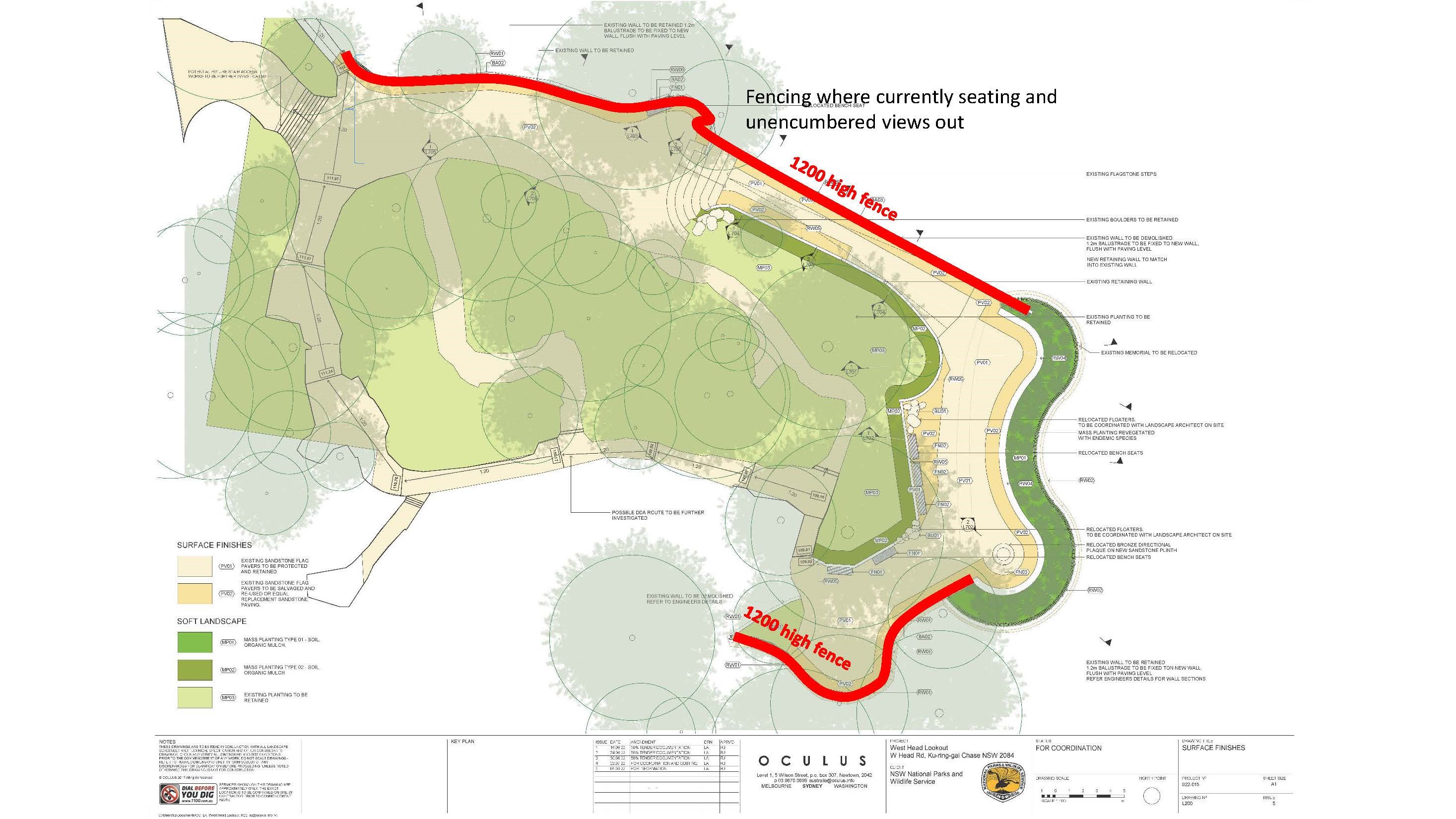
Bush Turkeys: Backyard Buddies Breeding Time Commences In August - BIG Tick Eaters - Ringtail Posse Insights
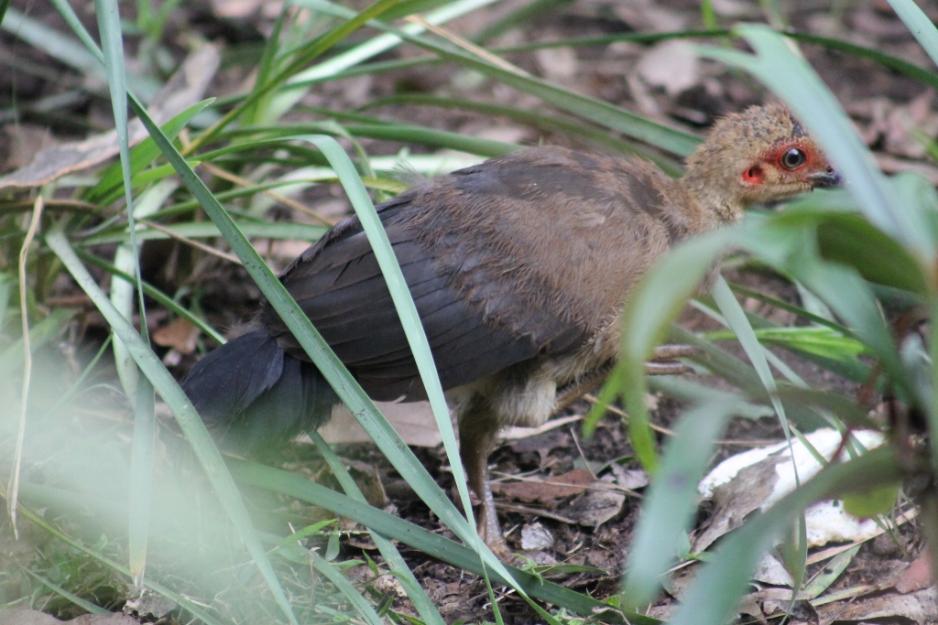
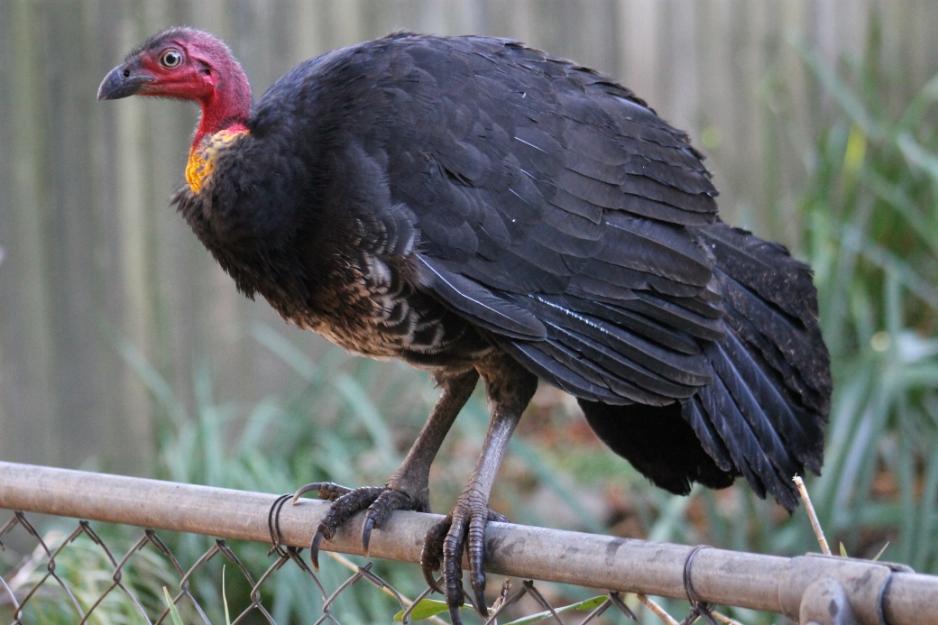
PNHA Guided Nature Walks 2023
Our walks are gentle strolls, enjoying and learning about the bush rather than aiming for destinations. Wear enclosed shoes. We welcome interested children over about 8 years old with carers. All Welcome.
So we know you’re coming please book by emailing: pnhainfo@gmail.com and include your phone number so we can contact you if weather is doubtful.
The whole PNHA 2023 Guided Nature Walks Program is available at: http://pnha.org.au/test-walks-and-talks/
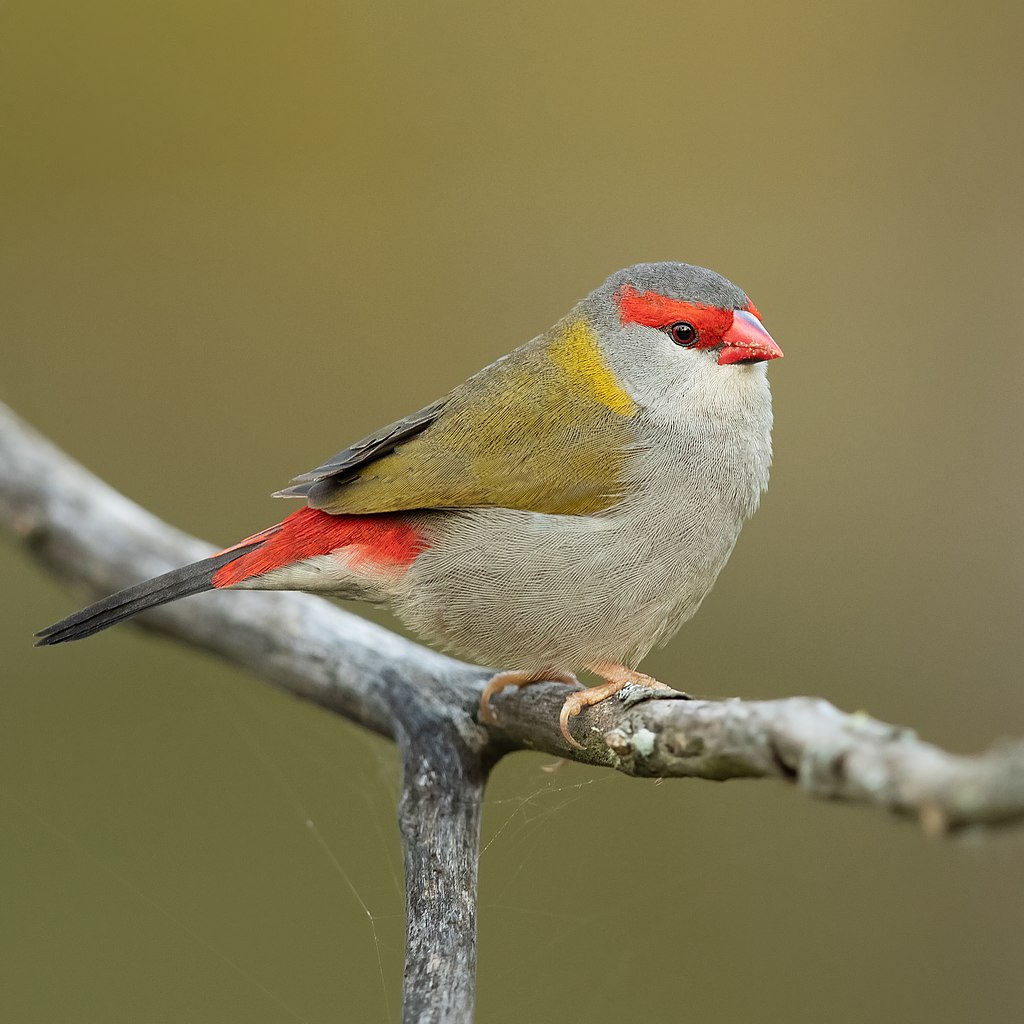
Red-browed finch (Neochmia temporalis). Photo: J J Harrison
Bushcare In Pittwater
Where we work Which day What time
Avalon
Angophora Reserve 3rd Sunday 8:30 - 11:30am
Avalon Dunes 1st Sunday 8:30 - 11:30am
Avalon Golf Course 2nd Wednesday 3 - 5:30pm
Careel Creek 4th Saturday 8:30 - 11:30am
Toongari Reserve 3rd Saturday 9 - 12noon (8 - 11am in summer)
Bangalley Headland 2nd Sunday 9 to 12noon
Bayview
Winnererremy Bay 4th Sunday 9 to 12noon
Bilgola
North Bilgola Beach 3rd Monday 9 - 12noon
Algona Reserve 1st Saturday 9 - 12noon
Plateau Park 1st Friday 8:30 - 11:30am
Church Point
Browns Bay Reserve 1st Tuesday 9 - 12noon
McCarrs Creek Reserve Contact Bushcare Officer To be confirmed
Clareville
Old Wharf Reserve 3rd Saturday 8 - 11am
Elanora
Kundibah Reserve 4th Sunday 8:30 - 11:30am
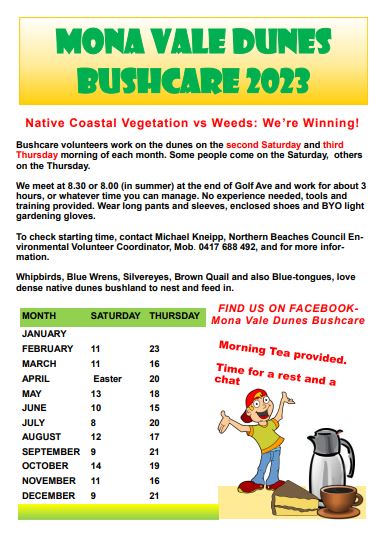 Mona Vale
Mona Vale Mona Vale Beach Basin 1st Saturday 8 - 11am
Mona Vale Dunes 2nd Saturday +3rd Thursday 8:30 - 11:30am
Newport
Bungan Beach 4th Sunday 9 - 12noon
Crescent Reserve 3rd Sunday 9 - 12noon
North Newport Beach 4th Saturday 8:30 - 11:30am
Porter Reserve 2nd Saturday 8 - 11am
North Narrabeen
Irrawong Reserve 2nd Saturday 2 - 5pm
Palm Beach
North Palm Beach Dunes 3rd Saturday 9 - 12noon
Scotland Island
Catherine Park 2nd Sunday 10 - 12:30pm
Elizabeth Park 1st Saturday 9 - 12noon
Pathilda Reserve 3rd Saturday 9 - 12noon
Warriewood
Warriewood Wetlands 1st Sunday 8:30 - 11:30am
Whale Beach
Norma Park 1st Friday 9 - 12noon
Western Foreshores
Coopers Point, Elvina Bay 2nd Sunday 10 - 1pm
Rocky Point, Elvina Bay 1st Monday 9 - 12noon
Friends Of Narrabeen Lagoon Catchment Activities

Gardens And Environment Groups And Organisations In Pittwater
Report Fox Sightings
%20(1).jpg?timestamp=1675893929686)
Marine Wildlife Rescue Group On The Central Coast
A new wildlife group was launched on the Central Coast on Saturday, December 10, 2022.
Marine Wildlife Rescue Central Coast (MWRCC) had its official launch at The Entrance Boat Shed at 10am.
The group comprises current and former members of ASTR, ORRCA, Sea Shepherd, Greenpeace, WIRES and Wildlife ARC, as well as vets, academics, and people from all walks of life.
Well known marine wildlife advocate and activist Cathy Gilmore is spearheading the organisation.
“We believe that it is time the Central Coast looked after its own marine wildlife, and not be under the control or directed by groups that aren’t based locally,” Gilmore said.
“We have the local knowledge and are set up to respond and help injured animals more quickly.
“This also means that donations and money fundraised will go directly into helping our local marine creatures, and not get tied up elsewhere in the state.”
The organisation plans to have rehabilitation facilities and rescue kits placed in strategic locations around the region.
MWRCC will also be in touch with Indigenous groups to learn the traditional importance of the local marine environment and its inhabitants.
“We want to work with these groups and share knowledge between us,” Gilmore said.
“This is an opportunity to help save and protect our local marine wildlife, so if you have passion and commitment, then you are more than welcome to join us.”
Marine Wildlife Rescue Central Coast has a Facebook page where you may contact members. Visit: https://www.facebook.com/profile.php?id=100076317431064
- Ph: 0478 439 965
- Email: marinewildlifecc@gmail.com
- Instagram: marinewildliferescuecc

Watch Out - Shorebirds About
.JPG.opt1460x973o0,0s1460x973.jpg?timestamp=1663629195339)
Possums In Your Roof?: Do The Right Thing

Aviaries + Possum Release Sites Needed

Leaving dog and cat poo lying around isn’t just gross. It’s a problem for native plants and animals, too
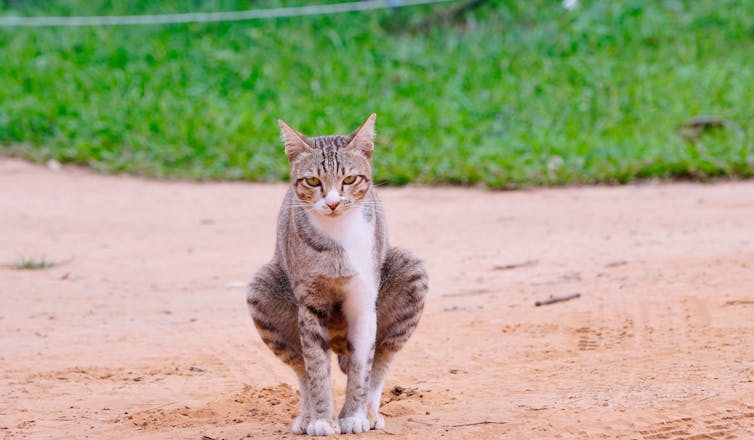
Dodging dog poo along the local path has become something of an Olympic sport of late. I thought I’d count path-side dog poo on my bike ride the other day and gave up after counting 30 piles in the first kilometre. It really does feel a bit out of control at the moment.
We know leaving dog poo lying around is bad for human health. But have you ever wondered what all this mess means for native wildlife?
It turns out pet poo – including both dog and cat poo – can have a number of negative effects on native plants and animals. And some of these might surprise you.
1. Unwelcome Fertiliser
Just like adding manure to the garden, pet poo left on the ground is a fertiliser. But not all plants thrive on excess.
Australian soils are naturally nutrient-poor and native plants and fungi are incredibly well-adapted to these conditions.
Yes, wildlife go to the toilet in nature too. But the difference is they also eat in nature – they’re part of the system.
Our pets, on the other hand, are fed nutrient-rich meals in our backyards and kitchens and then deliver these outside nutrients into the ecosystem. Pet poo can quickly find its way into waterways, which can drive algal blooms.
Researchers in Berlin estimated that if nobody picked up after their dogs, more than 11kg of nitrogen and 4kg of phosphorous per hectare would be added to urban nature reserves each year – levels that would be illegal for most farms.
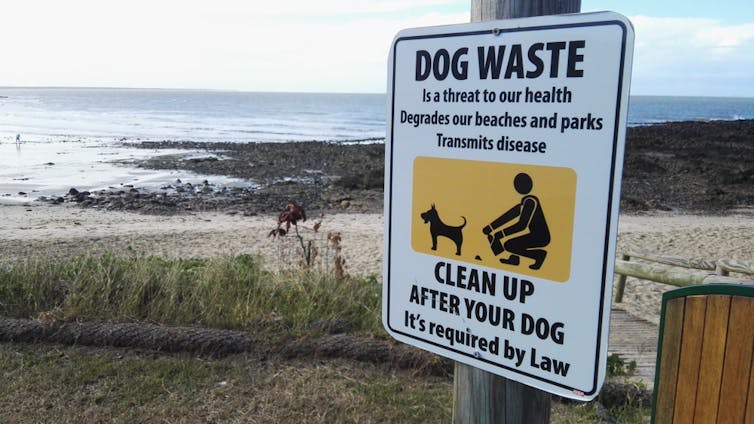
2. Lurking Disease
Pet cats aren’t off the hook. If you have a roaming kitty, they could be spreading toxoplasmosis – a disease that can cause serious illness and even death in native mammals.
Symptoms include blindness and seizures, and have been observed in kangaroos, wallabies, possums, wombats, bandicoots and bilbies. The disease even increases “risky” behaviours, with infected animals more prone to wandering around the open or being unafraid of predators.
It’s morbidly fascinating. The parasite causing the disease, Toxoplasma gondii, has two phases to its lifecycle. In the first phase, it’s happy hanging out inside pretty much any warm-blooded animal. But to complete the second phase, it has to jump to a cat. The easiest way to do this is to make your current host easy prey, hence the symptoms that debilitate native wildlife or make them prone to dangerous decisions.
Infected cats shed the parasite in their poo. So whenever native animals can come into contact with cat poo, they’re at risk. Researchers from the University of British Columbia found “wildlife living near dense urban areas were more likely to be infected”, citing domestic cats as the most likely culprit.
Worse, the parasite can lay dormant in poo for as long as 18 months, waiting for a host to jump into.
3. Eau De Predator
Finally, and probably the most obvious: dog poo might signal to wildlife that predators are about and they should stay away.
Even though dogs are a new predator to Australian wildlife, our native species have had enough experience existing alongside dingoes to consider your pooch a threat.
Recent research shows that in 83% of tests, Australian native mammals recognised dogs as a threat – with dog poo being a common trigger.
This means the signs and smells your dog leaves out and about can affect the behaviour of native wildlife.
For example, bandicoots in Sydney were less likely to visit backyards that had a resident dog, even if it was kept inside at night.
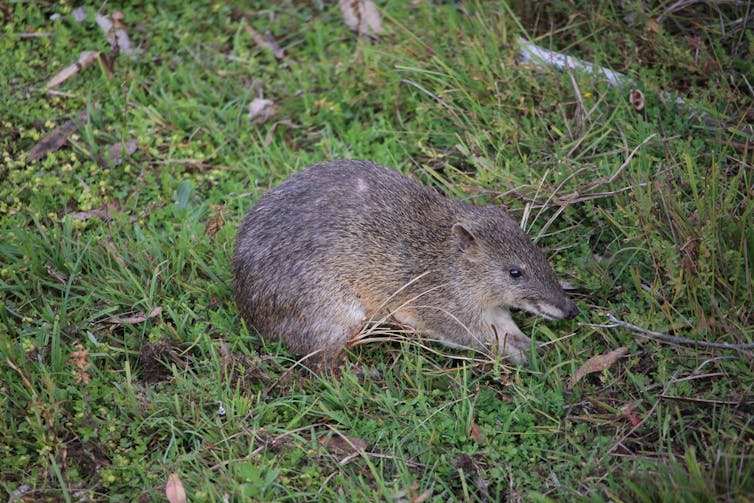
‘What Wildlife? What Nature? We Live In The City!’
It might surprise you to know we share our cities and towns with a huge range of native animals – even rare and endangered ones.
And as people have paid more attention to the nature in their local neighbourhood in recent years, we’re becoming more aware of the wildlife living right beneath our noses.
These species often depend on a seemingly rag-tag collection of urban green patches such as nature strips, utility easements, sports ovals and public gardens.
If these are all littered with smelly signs for wildlife to stay away, places safe for wildlife become even rarer in our cities. Reining in the pet poo problem is an easy way to reduce our impact.
The old adage “take only photographs, leave only footprints” is a good rule of thumb. Pick up after your pet and, importantly, take it with you to the nearest bin – don’t leave plastic bags dangling from fences like ornaments on the world’s worst Christmas tree. ![]()
Kylie Soanes, Postdoctoral Fellow, School of Ecosystem and Forest Sciences, The University of Melbourne
This article is republished from The Conversation under a Creative Commons license. Read the original article.
Unique study shows we can train wild predators to hunt alien species they’ve never seen before
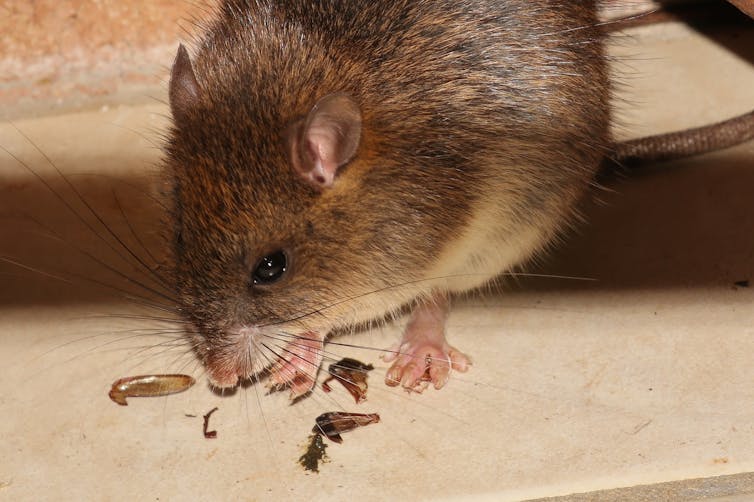
Humans have trained domestic animals for thousands of years, to help with farming, transport, or hunting.
But can we train wild animals to help us in conservation work? Wild animals can be taught to recognise dangerous predators, avoid toxic food, and stay away from people.
However, there are few examples of using classical learning techniques to train free-living animals to act in a way that benefits their ecosystem. In our newly published study in Biological Conservation, we trained wild Australian native predatory rats to recognise an unfamiliar species of cockroach prey. It worked – in a simulated cockroach invasion, this training increased predation rates by the rats.
Growing Number Of Aliens
As humans have engaged in global trade, various species have moved across otherwise impossible-to-cross geographical barriers and into new environments. These species are known as alien species, and their number continues to grow.
Some alien species are relatively harmless in their new environment, and can even positively affect the ecosystem. However, many others have costly and devastating impacts on biodiversity and agriculture.
Not all species that arrive in new environments become established or spread. Even fewer of these species become invasive. Yet we don’t really know why some species are successful and others aren’t, and there are many different theories. One reason some species fail to thrive in new environments is when native species resist, either by eating or simply outcompeting the arrivals.
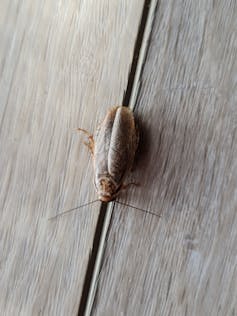
However, native species can only resist against alien species if they can respond appropriately, which they may not do if they’ve never encountered the invaders before (biologists call this being “naive”).
Naivete can occur when two species with no recent evolutionary or ecological history come into contact with one another. Prey naivete is well documented, and the effect of alien predators on native prey that can’t recognise or escape them is significant.
But the role of native predator naivete in biological invasions is less clear. Native predators may not recognise an alien prey species or lack the ability to hunt them effectively. Sometimes predators may simply prefer to hunt their natural prey. When predators are naive, alien prey can establish and spread unchecked.
Speeding Up A Natural Process
Native predators do eventually learn to hunt alien prey, but this process can take a long time when prey aren’t encountered often.
We wanted to know if we could speed up learning by exposing a free-living native predator to the scent of a novel prey species paired with a reward.
We conducted our study on bushland in the outskirts of Sydney, New South Wales, using native bush rats (Rattus fuscipes) as our model predator. Our chosen alien prey species, speckled cockroaches (Nauphoeta cinerea), don’t live in Sydney and surrounds, so rats have no experience with them.
We housed cockroaches in small boxes for days at a time with absorbent paper on the floor to collect odour. When using them as prey, we froze and tethered the cockroaches to tent pegs, to avoid accidental introduction of cockroaches in the area.
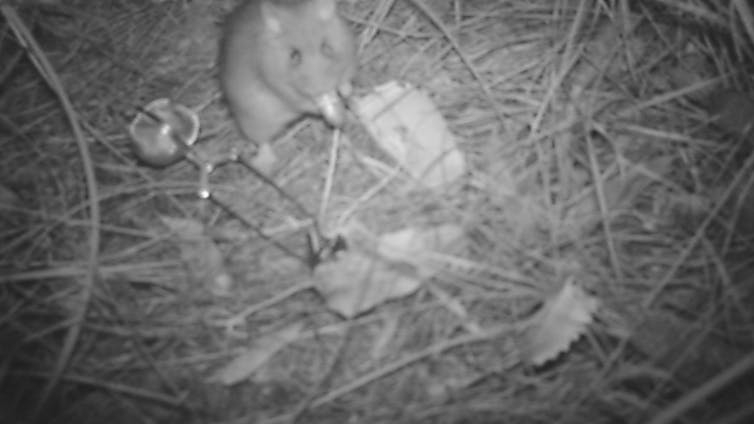
We confirmed the presence of bush rats at 24 locations, and randomly allocated 12 as training sites and 12 as non-training (control) sites. At the training sites, we placed a metal tea strainer with the cockroach smell, and three dead cockroaches as a reward. The tea strainer and cockroaches were tethered to a tent peg in the ground so rats couldn’t carry them away.
We used cameras to observe the rat behaviour, and checked the training stations every one to two days. We also moved the stations so the rats wouldn’t just learn to associate the reward with the location.
Trained For An Invasion
Immediately after training, we conducted a simulated invasion at all sites. The invasion involved ten dead and tethered cockroach “invaders”. The number of “surviving” (that is, uneaten) cockroaches was recorded each day for five days.
We compared prey survival rates in sites with trained and untrained rats, and found cockroach prey in training sites were 46% more likely to be eaten than prey in non-training sites.
We also found the number of cockroaches eaten during training was a significant predictor for how many were eaten on the first night of the “invasion”.
We also wanted to ensure we had not just attracted more rats to training sites during the training process. To do this, immediately after the invasion we used cameras to compare rat visits to all sites using a peanut oil attractant. There was no difference between training and non-training sites.
Our study is the first to train free-living predators to hunt species they’ve never seen before. It shows the potential for training our native species to fight biological invasions. More broadly, we think our study adds to the growing evidence that training animals can help to address a variety of problems, such as birds picking up litter and rats sniffing out landmines.![]()
Finn Cameron Gillies Parker, PhD candidate, University of Sydney and Peter Banks, Professor of Conservation Biology, School of Life and Environmental Sciences, University of Sydney
This article is republished from The Conversation under a Creative Commons license. Read the original article.
Wild bird feeding surged worldwide during lockdowns. That’s good for people, but not necessarily for the birds
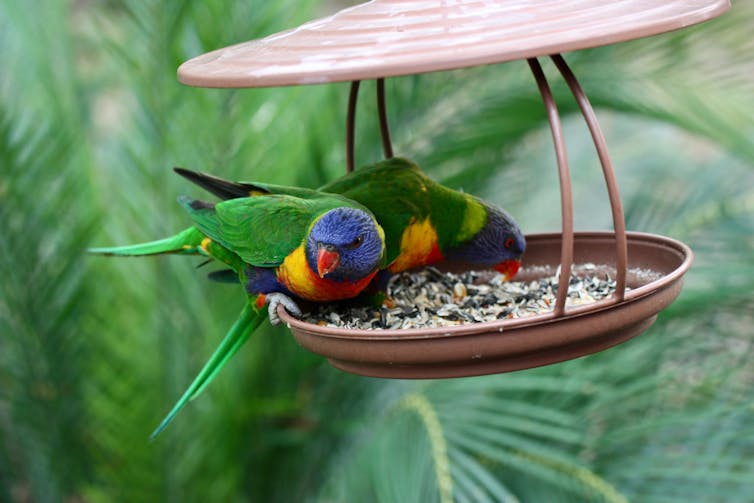
Feeding wild birds in backyards was already known to be extremely popular in many parts of the northern hemisphere and in Australia, despite being strongly discouraged. But the COVID-19 pandemic lockdowns led to a dramatic increase in wild bird feeding around the world, our research published today shows. There was a surge in interest beyond traditional bird-feeding countries in North America, Europe and Australia: 115 countries in total, including many where feeding was assumed not to occur.
Those opposed to feeding wild birds cite a plethora of reasons:
- the spread of diseases (well-documented in the US and UK)
- poor nutrition as a result of an unbalanced diet
- advantaging already abundant species
- changing community structure (birds that visit feeders prosper at the cost of those that don’t)
- even altering migration patterns.
These impacts occur everywhere wild birds are fed and are potentially serious.
On the other hand, engaging with wild birds in this way is now recognised as one of the most effective ways people can connect with nature. There is strong evidence that spending time in natural settings is good for people’s wellbeing and mental health. This becomes increasingly important as more and more of the world’s people live in large cities.
These trends mean the simple, common practice of attracting birds to your garden by feeding them is taking on much greater significance for the welfare of both birds and people.
What Did The Study Look At?
Previous studies documented a global increase in birdwatching during lockdowns. We wondered whether interest in feeding birds might have increased similarly as well. That usually means buying seed mixes and providing a feeder. To be included in our study, some cost was required; discarded food scraps were not counted as feeding.
It was important to go beyond the countries where we already knew feeding was common. We wanted to compare the interest levels for more than 100 countries during and after lockdowns. We also examined whether the level of interest in bird feeding was related to the diversity of birds in each country, a measure known as “species richness”.
We assessed the weekly frequency of search terms, including “bird feeder”, “bird food” and “bird bath”, using Google Trends for all countries with sufficient search volumes from January 1 2019 to May 31 2020. We wanted to see if these searches increased during each country’s specific lockdown period (generally around February-April 2020). We drew on bird species richness data for each nation from the BirdLife International database.
Comparing the interest volume for 52 weeks leading up to the lockdown with the week immediately before, we found no discernible change. Within only two weeks, however, the frequency of searches showed a surge in bird feeding interest during the general lockdown period across 115 of the countries surveyed. This happened in both the northern and southern hemispheres.
What Explains The Change?
There are several possible reasons for this change. People throughout the world were forced to remain close to home. The backyard or nearby park became the focus of attention, perhaps for the first time.
Lockdowns were a time of high anxiety and stress. Aspects of life that seemed to be carrying on regardless, such as birds arriving each day to be fed, may have been a course of comfort and reassurance.
Feeding birds has been found to enhance feelings of personal worth and peace. Presumably, it’s because of the relative intimacy associated with being able to attract wild, unrestrained creatures to visit by simply providing some food.
Bird feeding is also cheap, simple and available to virtually everyone. Birds will visit a feeder in a private garden, a public park or even a balcony on a residential tower.
And What Difference Does Bird Diversity Make?
We found a clear association between the level of interest in feeding and species diversity. Countries that lacked bird-related search interest had an average of 294 bird species. In contrast, those countries with clear interest had an average of 511 species.
This clear difference suggests that having a greater variety of species prompts more bird feeding. It may also mean places with more species have a larger number of bird types living in their cities (where most feeders live). This remains to be be investigated. We do know that feeding birds leads to more birds overall, but not more species.
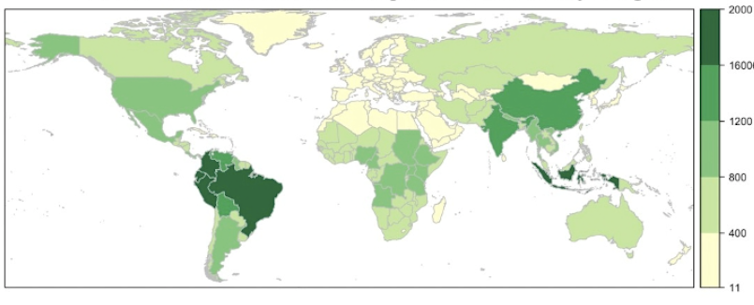
Because we used Google searches as the proxy measurement for bird-feeding interest, bird-feeding practices in countries with lower income or less internet access may not have been adequately captured. Nonetheless, our method was able to detect a surge of interest in bird feeding in countries such as Pakistan and Kenya.
The COVID-19 lockdowns seemed to encourage people all over the world to seek connection and interaction with their local birds. We hope future studies can further analyse the global extent of bird feeding and capture more data in previously understudied countries.
Feeding birds is obviously very popular. For people. But it can lead to problems for the birds. To minimise the risks, keep in mind some simple rules: ![]()
- keep the feeder extremely clean (disease is always a concern)
- don’t put out too much food (they don’t need it)
- provide food that is appropriate for the species (never human food – buy wild bird food from pet food companies).
Darryl Jones, Deputy Director of Environmental Futures Research Institute, Griffith University
This article is republished from The Conversation under a Creative Commons license. Read the original article.
Antarctica is missing a chunk of sea ice bigger than Greenland – what’s going on?
Ella Gilbert, British Antarctic Survey and Caroline Holmes, The Open UniversityDeadly heatwaves, raging wildfires and record global temperatures are upon us. But far from the flames, at the southernmost tip of the planet, something just as shocking is unfolding.
It’s Antarctic winter, a time when the area of floating sea ice around the continent should be rapidly expanding. This year though, the freeze-up has been happening in slow motion.
After reaching a record low minimum extent this summer there is now an area of open ocean bigger than Greenland. If the “missing” sea ice were a country, it’d be the tenth largest in the world.
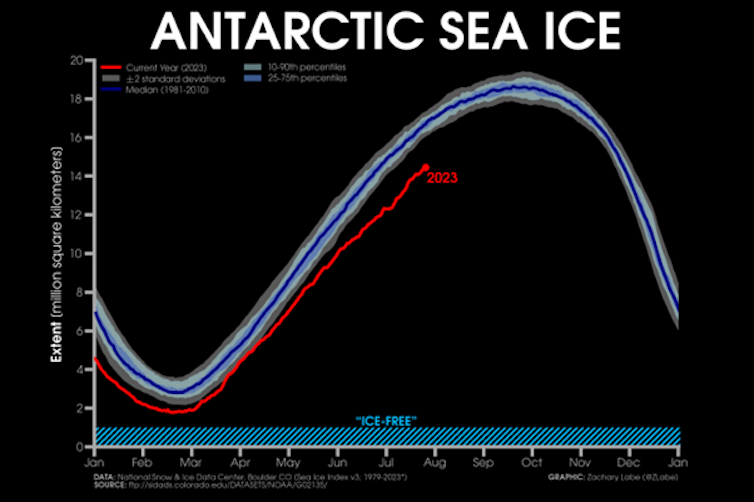
Who Cares About Antarctic Sea Ice?
In the face of more immediate climate concerns, why does Antarctic sea ice matter?
Floating sea ice is a pivotal climate puzzle piece. Without it, global temperatures would be warmer because its bright, white surface acts like a mirror, reflecting the sun’s energy back to space. This keeps the Antarctic – and by extension, the planet – cool.
Antarctic sea ice also plays a particularly important role in controlling ocean currents and may act as a buffer that protects floating ice shelves and glaciers from collapsing and adding to global sea levels.
In short, the loss of Antarctic sea ice matters for the whole planet.
Southern Sea Ice: A Short History
Every year Antarctic sea ice undergoes a transformation: from its summer minimum in February, its area increases more than sixfold during the winter freeze-up which reaches its height in September. A clear way to monitor the health of Antarctic sea ice is to track these peaks and troughs.
Records began in 1979 and until 2015, the yearly average extent of frozen sea around Antarctica was increasing ever so slightly. Yet in the past seven years, Antarctic sea ice has changed dramatically.
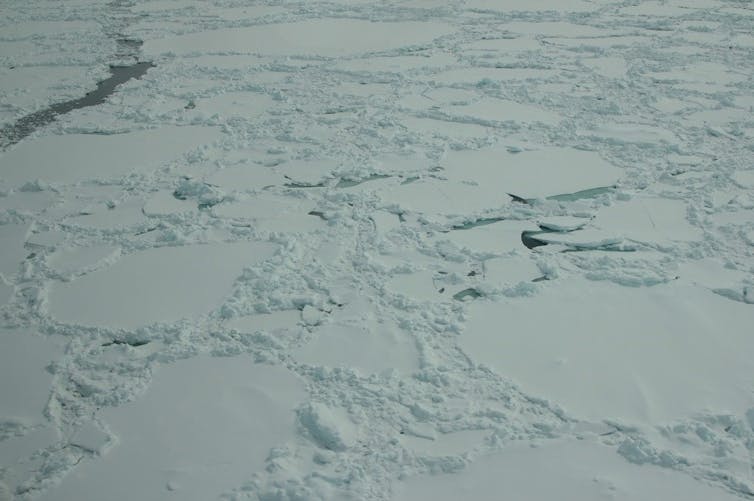
After a record high two years prior, the amount of sea ice fell dramatically at the end of 2016 to a record minimum in February 2017. This was followed by successive low years with the southern hemisphere summer record again being broken in February 2022 and most recently, a new lowest extent of 1.79 million square kilometres being recorded in 2023, a fall of nearly 10% from last year’s summer record.
Since February 2023, slow regrowth has meant sea ice has fallen further and further behind where it should be for the time of year.
And now, in July, what we’re seeing is truly remarkable.
A Complex Picture
Antarctic sea ice, and how it’s affected by climate change, has been so hard to understand because there are so many factors at play.
Wind patterns, storms, ocean currents and air and ocean temperatures all affect how much of the sea around Antarctica is covered by ice and they often push and pull in different directions. This means it can be hard to link the behaviour of Antarctic sea ice in any particular year, or over several years, to just one factor.
This complexity is behind the perplexing increase in Antarctic sea ice extent observed between 1979 and 2015, and what makes it so hard to understand current conditions.
Before 2015, contrasting trends in sea ice growth in different regions of the vast continent mostly counterbalanced each other. What’s remarkable about 2023 is that these regional differences are largely absent.
How Rare Is It?
This year’s record low summer minimum and record slow freeze-up are astonishing because they fall so far outside the range we have come to expect.
Antarctic sea ice varies a lot year-to-year, but even by Antarctic standards this is well outside the bounds of normality. Some experts have attempted to put a number on just how rare this would be without climate change and arrived at “a once in 7.5-million-year event”.
However, while the current situation is certainly off the charts, those charts don’t go back very far, and so it’s hard to make these sorts of statements with any real certainty.
Given how complex a system it is, we can’t say conclusively whether the past 40 years (the period for which we have satellite observations) are an accurate reflection of the “natural” behaviour of Antarctic sea ice. In fact, there’s good reason to think they aren’t. Which makes it difficult to say exactly how unusual this year’s values are.
However, while we may not be able to put an exact number on it, we know that this is a rare event.
Is It Climate Change?
Compared with Arctic sea ice, the precipitous decline of which can be robustly linked to rising temperatures, Antarctic sea ice has proved more enigmatic.
In response to greenhouse gas emissions, models have long predicted a drop in Antarctic sea ice: a prediction that previously appeared at odds with the data.
As the ocean and atmosphere warm, we might expect sea ice sandwiched between the two to shrink. But as scientists have come to learn, Antarctic sea ice is more complicated than that.
Models seem unreliable on this topic, which means we still don’t know what Antarctic sea ice decline will look like. And while seven days may be a long time in politics, seven years is a short time when it comes to the climate. It is too early to say conclusively whether the recent dramatic fall in Antarctic sea ice extent is simply a blip in the record or, as now seems more likely, the first sign of a longer-lasting reduction induced by climate change.
What Happens In Antarctica Doesn’t Stay In Antarctica
Regardless of the vagaries of Antarctic sea ice behaviour, the polar regions play a vital role in the climate system. And they are changing before our very eyes.
Antarctica isn’t just for the penguins: it matters for all of us.

Don’t have time to read about climate change as much as you’d like?
Get a weekly roundup in your inbox instead. Every Wednesday, The Conversation’s environment editor writes Imagine, a short email that goes a little deeper into just one climate issue. Join the 20,000+ readers who’ve subscribed so far.![]()
Ella Gilbert, Climate Scientist, British Antarctic Survey and Caroline Holmes, Polar Climate Scientist, British Antarctic Survey, Associate Lecturer, The Open University
This article is republished from The Conversation under a Creative Commons license. Read the original article.
A carbon tax can have economic, not just environmental benefits for Australia

A new study has found that a carbon tax, accompanied by “revenue recycling”, can produce both environmental and economic benefits for Australia.
Revenue recycling means money reaped from a carbon tax would be redirected back into the economy. This means the money accumulated from the tax would be redistributed between different stakeholders in the economy without increasing the government’s revenue.
To be more specific, the tax income should be used to support consumption, invest in new research and development projects, and subsidise energy saving and pollution reducing programs. Using this approach makes the tax more politically appealing to companies and other opponents.
Australia’s Experience With A Carbon Tax
Debate about a carbon tax has always been heated in Australia. The Gillard government introduced a carbon pricing scheme in 2012 which involved an initial rate of $23 per tonne on about 500 big carbon emitters, including the electricity industry.
The scheme contained compensation measures including increases in money to government payment recipients and a program to help emissions-intensive, trade-exposed industries reduce carbon emissions, which were themselves a form of recycling.
Despite reducing emissions, the tax only lasted two years before it was terminated by the Abbott government, which argued the tax was costing big companies and causing electricity prices to rise.
I examined how such a scheme could work again, basing the design on the models used in Norway, Ireland and Switzerland. I simulated Australia’s economy from 2020 to 2035 to examine the impact of a carbon tax policy with the associated revenue recycling approach on prices, total emissions and economic growth.

The first step in the design is identifying a tax rate and the reach of the policy. Research shows that a uniform rate covering the whole industry sector generates the greatest environmental benefits.
As well as suggesting a uniform tax rate on all sectors including the electricity sector (which is excluded from the current emissions safeguard mechanism), my study recommends starting the tax rate at $23 (the same rate applied in Gillard’s scheme) in 2023 and increasing it gradually to $70 in 2030.
The rate would stay at this level until 2035.
A carbon tax increases the cost of production and leads to an increase in the inflation rate. The inflation impact of this policy is estimated to be 0.5% in 2023, increasing substantially to 1.52% in 2035.
Rising inflation reduces the spending power of families and reduces consumption and economic growth. Considering consumption has a fundamental role in a growing economy, the accumulated tax revenue would be used to keep consumption unchanged after implementing a carbon tax.
How A New Version Of The Tax Would Work
My study recommends using the accumulated carbon tax revenue to lower income taxes. This would leave more money for families, thereby reducing the impact of inflation, caused by the tax, on the economy.
As well as strengthening families’ spending power, a share of the tax revenue would be invested in research and development projects. This would create new jobs and provide a baseline for a prosperous economy.
My study recommends that in the first year, all the tax revenue would be used to support consumption. However, the amount of money allotted to investment would rise from the second year as the carbon tax rate increases. It is estimated that about $57 billion would be available for new technologies over 13 years under this carbon tax.
Imposing a carbon tax would also provide a financial incentive for industry to reduce its fossil fuel use. It would motivate the sector to shift to low-carbon technologies as they would bear a smaller tax bill and reap larger profits.
My study concludes Australia could reduce carbon emissions by 35% while GDP would increase by 0.286% by 2035 and new jobs would be created in research and development. Following the recommended carbon tax design, Australia’s transition to a low-carbon economy would be accelerated, which would benefit both the economy and the environment.![]()
Mona Mashhadi Rajabi, Postdoctoral Research Fellow, University of Technology Sydney
This article is republished from The Conversation under a Creative Commons license. Read the original article.
Out of danger because the UN said so? Hardly – the Barrier Reef is still in hot water
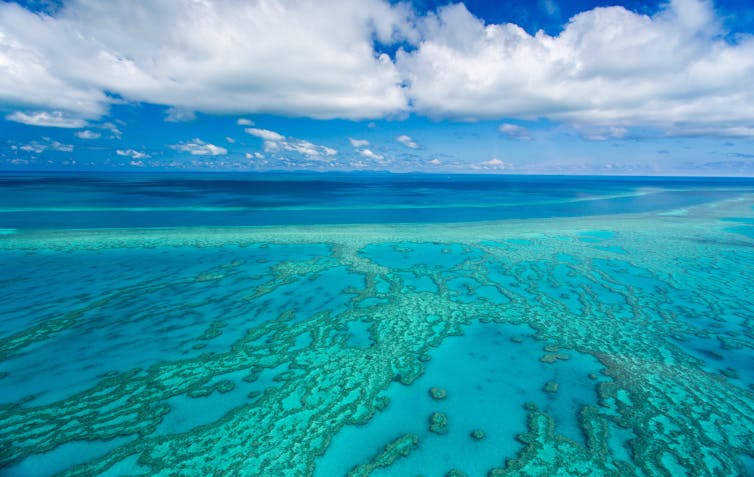
Today is a good day to be Environment Minister Tanya Plibersek. UNESCO, the United Nations body expected to vote on whether to list the Great Barrier Reef as “in danger”, instead deferred the decision for another year. This, an insider told French newspaper Le Monde, was largely due to the change in approach between the former Coalition government and Labor.
“It’s a bit like night and day,” the insider said – which was promptly included in Plibersek’s media release.
So, it’s a good day for the government. But is it a good day for the reef? No. The longstanding threats to the world’s largest coral ecosystem are still there, from agricultural runoff, to shipping pollution, to fisheries, although we have seen improvement in areas such as water quality.
But any incremental improvement will be for naught if we don’t respond to the big one – climate change – with the necessary urgency. This year has seen record-breaking heat and extreme weather, with intense heating of the oceans during the northern summer. These intense marine heatwaves have devastated efforts to regrow or protect coral in places like Florida. And our own summer is just around the corner.
It is not hyperbole to say the next two years are likely to be very bad for the Great Barrier Reef. It’s already enduring a winter marine heatwave. Background warming primes the reef for mass coral bleaching and death. We’ve already experienced this in 2016-17, which brought back-to-back global mass coral bleaching and mortality events including on the Great Barrier Reef. We can expect more as global temperatures continue to soar.
While the government may congratulate itself on not being the previous one, it’s nowhere near enough. We’re facing D-Day for the reef, as for many other ecosystems. Incrementalism and politics as usual are simply not going to be enough.
What Has The Government Done For The Reef To Date?
To its credit, Labor has made some marginal improvements to the Great Barrier Reef’s prospects. The list includes: legislating net zero greenhouse emissions, with a 43% cut within seven years; improving water quality with revegetation projects and work to reduce soil erosion; and ending gillnet use in the Great Barrier Reef Marine Park by 2027.
For at least a century, cattle, sugarcane and other farmers have relied on rivers to take animal waste and fertiliser runoff away from their properties. In much of Queensland, that means the runoff heads for the Great Barrier Reef instead. We did see some improvement under the Coalition government, which put A$443 million into trying to solve the issue. Labor has put in a further $150 million. But the water quality problem is still not solved.
Ending gillnet use in the marine park is also welcome, given these nets can and do catch and kill sharks, dugongs and turtles. But challenging though these issues are, they pale in comparison to climate change.
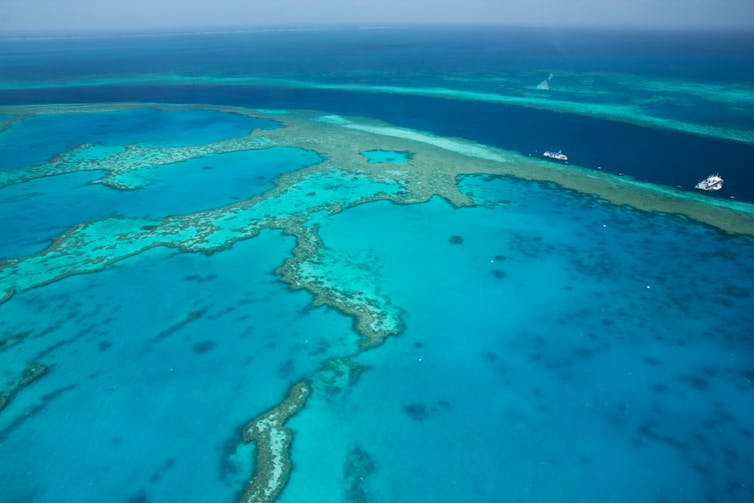
Tinkering While The Reef Burns
When coral is exposed to warmer water than it has evolved to tolerate, it turns white (bleaches) – expelling its symbiotic algae. If the water stays too hot for too long, the corals simply die en masse.
You might have seen the positive reports on coral regrowth during the three recent cooler La Niña years and wonder what the issue is. Isn’t the reef resilient?
Yes – to a point. But after that point, the coral communities collapse. The world is having its hottest days on record. Coupled with a likely El Niño, the reef will likely face the hottest waters yet.
That’s because we still haven’t tackled the root cause. Greenhouse gas emissions are still going up. Year on year, we’re trapping more heat, of which 90% goes into the oceans. Antarctic sea ice is not reforming as it should after last summer. Coral restoration efforts in the United States had to literally pull their baby corals out of the sea to try to keep them alive, as the water was too hot to live in.
The North Atlantic Ocean is far warmer than it should be, amid a record-breaking northern summer. After the equinox next month, it will be our turn to face the summer sun once more.
Is the Great Barrier Reef in danger? Of course it is. We should not pretend things are normal and can be handled routinely. This year, we’re beginning to see the full force of what the climate crisis will bring. We have clearly underestimated the climate’s sensitivity to rising carbon dioxide levels, and the gloomy predictions I made more than 20 years ago are looking positively optimistic.
And still we fail to face up to the fact that the Great Barrier Reef is dying. We thought we might have had decades but it may be just years. Before 1980, no mass bleaching had ever been recorded. Since then it has only become more common.
Incremental efforts to save the reef, such as looking for heat-tolerant “supercorals”, or replanting baby coral, now look unlikely to work. We don’t have decades or the capacity to find and cultivate resilient corals at scale. And we certainly do not have the massive funding required to replant even a small coral reef.
For people like us who work in the field, it is a devastating time. I now know the feeling of having a broken heart. The pace and intensity of climate change risks rendering all our efforts over the years null and void. It’s almost impossible to look directly at what this will mean for this immense living assemblage, which first began growing more than 600,000 years ago along the Australian east coast.
Giving the government more time to show the reef is improving seems like a fool’s errand. Time is precisely what we don’t have. ![]()
Ove Hoegh-Guldberg, Professor, The University of Queensland
This article is republished from The Conversation under a Creative Commons license. Read the original article.
Why is Australia having such a warm winter? A climate expert explains
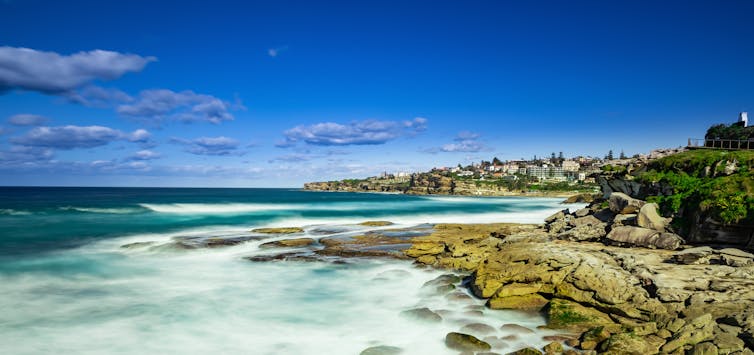
If you’ve been out and about the past few days, you may have noticed Australia is experiencing an unseasonably warm winter. It’s been t-shirt weather across many parts of the country’s east, including Sydney where temperatures topped 25℃ on Sunday.
Meanwhile, at high altitudes, the cover at some snowfields remains lacklustre, even after warm conditions forced a delay to the start of the traditional ski season.
All this comes after the world experienced its hottest month since reliable records began. July brought an incredible 21 of the warmest 30 days ever recorded – prompting the United Nations to declare a new era of “global boiling”.
So what’s going on with the weather in Australia? Should we just enjoy the pleasant conditions, or is it a troubling sign of what’s to come under climate change?
The Nice Weather, Explained
Australia’s unseasonably warm conditions are the result of both natural drivers of our weather and continued global warming.
Since early July, warmer and drier conditions have dominated, due to a high pressure system sitting stubbornly over Australia at the moment. The clear conditions are leading to warmer daytime conditions.
For example, daytime temperatures in Canberra in July – historically known for its cold winters – were the warmest on record, despite frequent frosty mornings. Sydney has just experienced its warmest July on record, too.
The high pressure has caused the air over the continent’s interior to warm. When cold fronts move across the south of Australia they push this warm air ahead of them, bringing warm and windy conditions to southern coastal areas. This is similar to the weather pattern we see in summer when cities such as Adelaide and Melbourne experience their hottest days.
On Thursday, an approaching cold front is forecast to lift temperatures ahead of it to about 23℃ in Adelaide, 20℃ in Melbourne and 18℃ in Hobart. These are very warm temperatures in these locations for early August.
And what about the oceans? Around Australia, oceans are a bit cooler than average in some places including to the northwest of the continent.
But as the image below shows, ocean temperatures are currently above normal in many places around the world, including the west Indian Ocean and the central and eastern tropical Pacific. This indicates a developing El Niño and positive Indian Ocean Dipole – two natural climate drivers that affect Australia’s weather patterns.

This difference in ocean temperatures reduces the amount of atmospheric moisture over southern and eastern Australia. It also makes low pressure systems weaker and less frequent, reducing rainfall over the region.
Over the coming months, warm and dry weather is expected to continue. For the rest of winter and spring, it’s expected to be drier than normal in the southwest of Western Australia and much of the east of the continent. And the whole of Australia is predicted to be warmer than normal during this period. Of course, this doesn’t rule out occasional cool, wet spells.
So is climate change a factor here? Yes. Australia’s land areas have already warmed by 1.4℃ since pre-industrial times. This is the result of humans burning fossil fuels and releasing greenhouse gases.
The record winter warmth is part of a long-term upward trend in Australian winter temperatures.
As I’ve written previously, there has been at least a 60-fold increase in the likelihood of a very warm winter that can be attributed to human-caused climate change.
And we’re likely to see more record warm winters as the planet continues to warm.
Looking North
Of course, Australia’s spell of warm weather seems harmless compared to the Northern Hemisphere’s weird and wild summer.
There, simultaneous extreme heatwaves have struck all four continents in recent weeks. Ocean temperatures are well above previous record highs for this time of year. Last week, 1,000 wildfires burned in Canada alone.
The planet’s warmest average temperatures typically happen in July. That’s because the Northern Hemisphere’s large land masses heat up more quickly than the oceans, in response to the high amounts of radiation from the sun. Still, the heat of the last few weeks has been unprecedented.
The heatwaves are linked to high-pressure weather systems that are “blocking” or deflecting oncoming low-pressure systems (and associated clouds and rain). On top of this, human-caused global warming is greatly increasing the chance of record-breaking extreme heat events and concurrent heatwaves across many regions.
Worryingly, a rapid analysis by international experts suggests the extreme heat should not be viewed as unusual, given the effects of climate change. For example, it says China’s recent record-breaking heatwave should now be expected about once in every five years, on average.
Not all extreme weather events can be attributed to human-caused climate change. But the study found climate change significantly contributed to the recent heatwaves in China, North America and Europe.
A Sign Of What’s To Come
The Northern Hemisphere’s heatwaves are very alarming. But Australia’s temperatures are also unusually high for winter – and this is also cause for concern.
Warm winters in Australia can negatively affect some parts of the economy, including the ski industry. It also disrupts flora and fauna and increases the chance of “flash droughts” – where drier-than-normal conditions turn into severe drought in the space of weeks.
The warm, dry conditions may also lead to an earlier start to the fire season in Australia’s southeast.
So while we may appreciate warm winter weather, we mustn’t forget what’s driving it – and how urgently we need to stabilise Earth’s climate by slashing greenhouse gas emissions.![]()
Andrew King, Senior Lecturer in Climate Science, The University of Melbourne
This article is republished from The Conversation under a Creative Commons license. Read the original article.
Here’s how wastewater facilities could tackle food waste, generate energy and slash emissions
Melita Jazbec, University of Technology Sydney; Andrea Turner, University of Technology Sydney, and Ben Madden, University of Technology SydneyMost Australian food waste ends up in landfill. Rotting in the absence of oxygen produces methane, a potent greenhouse gas. While some facilities capture this “landfill gas” to produce energy, or burn it off to release carbon dioxide instead, it’s a major contributor to climate change. Valuable resources such as water and nutrients are also wasted.
Composting food waste is the most common alternative. In the presence of oxygen, microbes break down food and garden organics without producing methane. The product returns nutrients to farms and gardens. But composting facilities are limited and struggling to cope with contamination from plastic.
We analysed the capacity of three wastewater facilities in Sydney to process organic wastes from surrounding households and businesses.
We found processing at the wastewater treatment plants could cut 33,000 tonnes of emissions and capture 9,600 tonnes of nutrients. All 14 wastewater facilities in Sydney could be modified to accept food waste, reducing emissions and producing renewable energy.
Why Process Food Waste At Wastewater Facilities?
Most wastewater facilities in Sydney use “anaerobic digestors” to treat sewage. Along with producing energy, this type of processing produces nutrient-rich biosolids that can be used for soil conditioning and as fertiliser.
Wastewater facilities are normally built with excess capacity to meet future demand and so could be used to handle food waste.
When the New South Wales government recently assessed the infrastructure needs to process food waste for the Greater Sydney Area by 2030, it identified an additional 260,000 tonnes per year of anaerobic digestion capacity is needed, on top of additional new composting infrastructure.
Currently, there is only one commercial anaerobic digestion plant in Sydney with a processing capacity of 52,000 tonnes per year.
Our study estimated just three wastewater facilities could fill 20% of the identified anaerobic digestion capacity gap required for Sydney by 2030.
Overseas, it is common for wastewater facilities to handle food waste, and in some cases generate more electricity than needed for their operation. These facilities give the excess electricity to the communities from which the food waste is collected and the nutrients back to local farms, creating a circular economy.
While industrial-scale composting facilities are normally located on the outskirts of Sydney, wastewater facilities are distributed throughout the city. This provides an additional benefit as food waste can be processed closer to where it is made, saving on significant transfer infrastructure and transport costs.
Although some changes are required to enable wastewater facilities to accept and process food waste, there are great returns on investment. As a recent economic study for Western Parkland City has shown, upgrading facilities brings wider economic benefits and creates jobs, along with the environmental benefits.
Separate Food Waste At The Source
To maximise anaerobic digestion at wastewater facilities, food waste needs to be separated from other wastes. This is because contamination and non-compatible materials in the waste stream can hinder the microbal processes driving anaerobic digestion.
NSW targets require all businesses making large amounts of food waste to separate it from other waste by 2025. Similarly, all households will need to separate food waste by 2030.
Currently most councils in Sydney offer a garden waste collection service. Only a few provide food waste collection and mostly in FOGO bins (combined Food Organics and Garden Organics waste service). However, the garden organics component of FOGO cannot be easily digested with sewage and would need significant additional pre-treatment before it can be processed.
Urban food organics are normally collected by trucks. This waste stream could potentially be piped to the wastewater treatment plant, with or without sewage. But piped networks were not considered for food waste collection in this study. It’s an interesting area for future research, especially in dense urban areas.
Achieving Net Zero Targets While Reducing Waste
The three wastewater facilities we studied could generate an estimated total of 38 billion litres of methane a year. This could replace the natural gas used by 30,000 households.
The bioenergy potential of the organic wastes from the study areas was estimated to be 126,000MWh. That is four and a half times more than the energy generated from solar panels installed in the area.
This study shows methane generated by anaerobic digestion can play an important role in the renewable energy mix. It can be used to generate electricity, as transport fuel, or as a natural gas replacement.
The wastewater facility at Malabar in Sydney is the first project in Australia injecting biogas into the gas network, demonstrating its feasibility.
The waste, energy and water sectors are all expected to achieve net zero targets. Reducing food waste and redirecting to more beneficial use works towards these targets.
Harnessing the full potential of anaerobic digestion of food waste at wastewater facilities will require collaboration between these sectors. But as we have shown, it will be worth it. ![]()
Melita Jazbec, Research Principal at the Institute for Sustainable Futures, University of Technology, Sydney, University of Technology Sydney; Andrea Turner, Research Director, Institute for Sustainable Futures, University of Technology Sydney, and Ben Madden, Senior Research Consultant at the Institute for Sustainable Futures, University of Technology Sydney
This article is republished from The Conversation under a Creative Commons license. Read the original article.
Cooking (and heating) without gas: what are the impacts of shifting to all-electric homes?
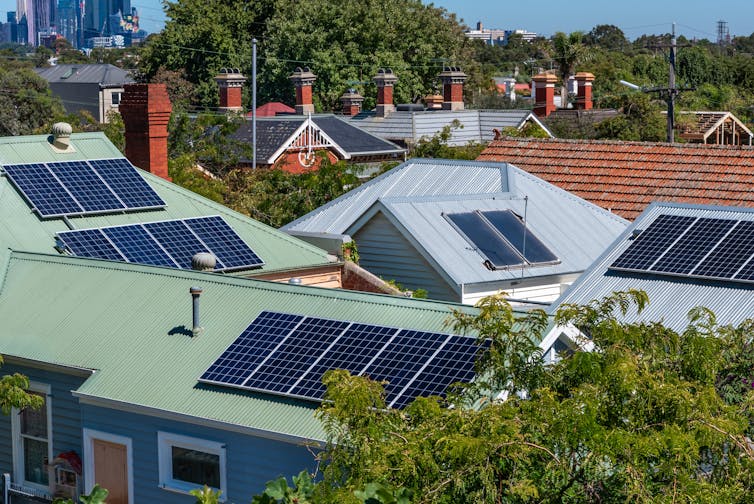
Gas connections for all new housing and sub-divisions will be banned in Victoria from January 1 next year. The long-term result of the state government’s significant change to planning approvals will be all-electric housing. The ACT made similar changes early this year, in line with a shift away from gas across Europe and other locations, although the NSW Premier Chris Minns has baulked at doing the same.
Around 80% of homes in Victoria are connected to gas. This high uptake was driven by gas being seen as more affordable and sustainable than electricity over past decades. The situation has changed dramatically as renewable electricity generation increases and costs fall.
Research has suggested for more than a decade that the benefits of all-electric homes stack up in many locations. New homes built under mandatory building energy performance standards (increasing from 6 to 7 stars in Victoria in May 2024) need smaller, cheaper heating and cooling systems. Installing reverse-cycle air conditioning for cooling provides a cost-effective heater as a bonus.
Savings from not requiring gas pipes, appliances and gas supply infrastructure help to offset the costs of highly efficient electric appliances. Mandating fully electric homes means economies of scale will further reduce costs.
How Does This Ban Help?
To achieve environmentally sustainable development, reforms of planning policy and regulation are essential to convert innovation and best practice to mainstream practice. Planning policy is particularly important for apartment buildings and other housing that may be rented or have an owners’ corporation. Retrofits to improve energy efficiency can be difficult in these situations.
Banning gas in new and renovated housing will cut greenhouse gas emissions. It’s also healthier for households and reduces healthcare costs as well as energy bills and infrastructure costs. The Victorian government suggests the change will save all-electric households about $1,000 a year. Houses with solar will be even better off.
The government appears to be offering wide support to ensure these changes happen, but this will need to be monitored closely.
Some households will face extra costs for electric appliances and solar panels. The government’s announcement of $10 million for Residential Electrification Grants should help with some of these costs while the industry adjusts.
There will be impacts and benefits for the local economy. Some jobs may be lost, particularly in the gas appliance and plumbing industry. The government has announced financial support to retrain people and they will still have essential roles in the existing housing sector.
Many gas appliances are imported, including ovens, cooktops and instantaneous gas water heaters. Some components of efficient electric products, such as hot water storage tanks, are made locally. Local activities, including distribution, sales, design, installation and maintenance, comprise much of the overall cost.

Challenges Of Change Must Be Managed
Sustainability benefits will depend on what happens with the energy network. We need more renewable energy, energy storage and smarter management of electricity demand.
The shift to all-electric homes may mean winter peak demand for heating increases. Energy market operators and governments will have to monitor demand changes carefully to avoid the reliability issues we already see in summer. However, improving energy efficiency, energy storage and demand management will help reduce this load (and household costs).
While the benefits are clear for new homes, the changes may increase gas costs and energy poverty for residents of existing housing who don’t shift to efficient electric solutions. The government has reconfirmed financial rebates to help households switch from gas.
In addition, existing housing may face building quality and performance issues. Some may require electrical wiring upgrades as part of the transition.
Social acceptance of some electric appliances may also be an issue. For example, our research has found some households dislike the way heating from reverse cycle air conditioners feels. Others do not like cooking on induction cooktops.
Consumer education and modifications to appliances and buildings may be needed to increase acceptance and avoid backlash.

Some electric appliances are available overseas but not in Australia. Higher demand may increase the range of imports. For example, floor-mounted heat pumps can make heating feel similar to gas heating while still providing effective cooling.
We should not assume electric appliances are all equal. To improve consumer protection, action is needed on weak standards and limited and inconsistent public information. For example, information on noise levels and efficiency under a range of weather conditions must be standardised.
Moving housing away from gas is an important step in the transition to a zero-carbon economy and energy system. Careful management is needed to ensure this transition is effective, accepted and fair.
Continued planning reforms are also essential to ensure environmentally sustainable development of housing and communities. Other urgent priorities include urban cooling and greening, and circular economy approaches to reduce the material and waste impacts of housing and thus the carbon that goes into building and running homes.![]()
Trivess Moore, Senior Lecturer, School of Property, Construction and Project Management, RMIT University; Alan Pears, Senior Industry Fellow, RMIT University, and Joe Hurley, Associate Professor, Sustainability and Urban Planning, RMIT University
This article is republished from The Conversation under a Creative Commons license. Read the original article.
The ‘Gulf Stream’ will not collapse in 2025: What the alarmist headlines got wrong
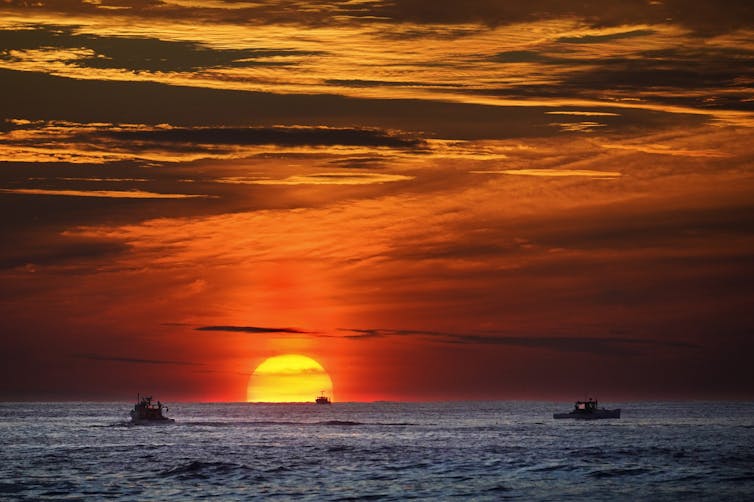
Those following the latest developments in climate science would have been stunned by the jaw-dropping headlines last week proclaiming the “Gulf Stream could collapse as early as 2025, study suggests” — which responded to a recent publication in Nature Communications.
“Be very worried: Gulf Stream collapse could spark global chaos by 2025” announced the New York Post. “A crucial system of ocean currents is heading for a collapse that ‘would affect every person on the planet” noted CNN in the U.S. and repeated CTV News here in Canada.
One can only imagine how those already stricken with climate anxiety internalized this seemingly apocalyptic news as temperature records were being shattered across the globe.
This latest alarmist rhetoric provides a textbook example of how not to communicate climate science. These headlines do nothing to raise public awareness, let alone influence public policy to support climate solutions.
We See The World We Describe
It is well known that climate anxiety is fuelled by media messaging about the looming climate crisis. This is causing many to simply shut down and give up — believing we are all doomed and there is nothing anyone can do about it.
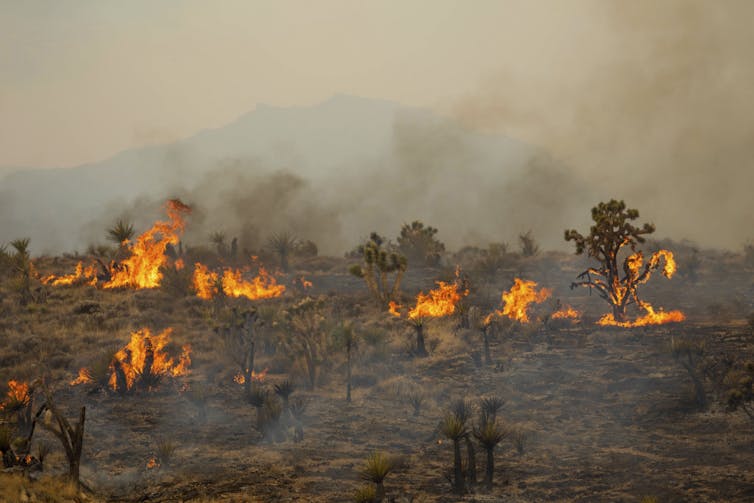
Alarmist media framing of impending doom has become quintessential fuel for personal climate anxiety, and when amplified by sensational media messaging, it is quickly emerging as a dominant factor in the collective zeitgeist of our age, the Anthropocene.
This is also not the first time such headlines have emerged. Back in 1998, the Atlantic Monthly published an article raising the alarm that global “warming could lead, paradoxically, to drastic cooling — a catastrophe that could threaten the survival of civilization.”
In 2002, editorials in the New York Times and Discover magazine offered the prediction of a forthcoming collapse of deep water formation in the North Atlantic, which would lead to the next ice age.
Building on the unfounded assertions in these earlier stories, BBC Horizon televised a 2003 documentary entitled The Big Chill, and in 2004 Fortune magazine published “The Pentagon’s Weather Nightmare,” piling on where previous articles left off.
Seeing the opportunity for an exciting disaster movie, Hollywood stepped up to created The Day After Tomorrow in which every known law of thermodynamics was ever so creatively violated.
The Currents Are Not Collapsing (Anytime Soon)
While it was relatively easy to show that it is not possible for global warming to cause an ice age, this still hasn’t stopped some from promoting this false narrative.
The latest series of alarmist headlines may not have fixated on an impending ice age, but they still suggest the Atlantic meridional overturning circulation could collapse by 2025. This is an outrageous claim at best and a completely irresponsible pronouncement at worst.
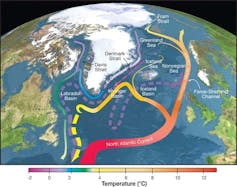
The Intergovernmental Panel on Climate Change has been assessing the likelihood of a cessation of deep-water formation in the North Atlantic for decades. In fact, I was on the writing team of the 2007 4th Assessment Report where we concluded that:
“It is very likely that the Atlantic Ocean Meridional Overturning Circulation (MOC) will slow down during the course of the 21st century. It is very unlikely that the MOC will undergo a large abrupt transition during the course of the 21st century.”
Almost identical statements were included in the 5th Assessment Report in 2013 and the 6th Assessment Report in 2021. Other assessments, including the National Academy of Sciences Abrupt Impacts of Climate Change: Anticipating Surprises, published in 2013, also reached similar conclusions.
The 6th assessment report went further to conclude that:
“There is no observational evidence of a trend in the Atlantic Meridional Overturning Circulation (AMOC), based on the decade-long record of the complete AMOC and longer records of individual AMOC components.”
Understanding Climate Optimism
Hannah Ritchie, the deputy editor and lead researcher at Our World in Data and a senior researcher at the Oxford Martin School, recently penned an article for Vox where she proposed an elegant framework for how people see the world and their ability to facilitate change.
Ritchie’s framework lumped people into four general categories based on combinations of those who are optimistic and those who are pessimistic about the future, as well as those who believe and those who don’t believe that we have agency to shape the future based on today’s decisions and actions.
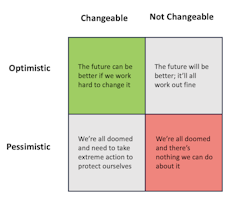
Ritchie persuasively argued that more people located in the green “optimistic and changeable” box are what is needed to advance climate solutions. Those positioned elsewhere are not effective in advancing such solutions.
More importantly, rather than instilling a sense of optimism that global warming is a solvable problem, the extreme behaviour (fear mongering or civil disobedience) of the “pessimistic changeable” group (such as many within the Extinction Rebellion movement), often does nothing more than drive the public towards the “pessimistic not changeable” group.
A Responsibility To Communicate, Responsibly
Unfortunately, extremely low probability, and often poorly understood tipping point scenarios, often end up being misinterpreted as likely and imminent climate events.
In many cases, the nuances of scientific uncertainty, particularly around the differences between hypothesis posing and hypothesis testing, are lost on the lay reader when a study goes viral across social media. This is only amplified in situations where scientists make statements where creative licence is taken with speculative possibilities. Possibilities that reader-starved journalists are only too happy to play up in clickbait headlines.

Through independent research and the writing of IPCC reports, the climate science community operates from a position of privilege in the public discourse of climate change science, its impacts and solutions.
Climate scientists have agency in the advancement of climate solutions, and with that agency comes a responsibility to avoid sensationalism. By not tempering their speech, they risk further ratcheting up the rhetoric with nothing to offer in terms of overall solutions or risk reduction.![]()
Andrew Weaver, Professor, School of Earth and Ocean Sciences, University of Victoria
This article is republished from The Conversation under a Creative Commons license. Read the original article.
Olympic swimming in the Seine highlights efforts to clean up city rivers worldwide
Gary Osmond, The University of Queensland and Rebecca Olive, RMIT UniversityOne year out from the 2024 Summer Olympic and Paralympic games, Paris has announced it will reopen the River Seine for swimming competition and then allow public swimming, ending a century-long ban. This ban was in place to stop people immersing themselves in river waters polluted by stormwater, sewage and chemicals.
But after many years of stormwater management work, three Olympic and Paralympic events will be held in the Seine in 2024 – the swimming marathon and the swimming legs of the Olympic triathlon and Para-triathlon. The Seine will also feature in the opening ceremony when, instead of the traditional athletes’ parade in a stadium, a parade of boats will carry the teams along the river.
The clean waters of the swimmable Seine are being promoted as a positive legacy of these games. But it’s not the first time Olympic swimming events have been held in the famous river. And with growing commitments to swimmable cities around the world, it is unlikely to be the last.
A Brief History Of River Swimming

At the 1900 Paris Olympics, Australia’s Freddie Lane won two swimming events in the Seine. These were the 200 metres freestyle and a 200m obstacle race. This unusual event required the 12 athletes from four countries to climb over a pole, scramble over a row of boats and then swim under another row of boats.
Historians Reet and Max Howell quoted Lane describing his winning strategy: “[Knowing] a bit about boats [I] went over the sterns […] unlike the majority of competitors who fought their way over the sides.”
Following the tradition of linking to classical history that was common in the Games at the time, this event referenced Sequana, the Gallo-Roman goddess of the Seine. She is typically represented standing on a boat: clambering over and swimming under the river’s vessels was clearly for mere mortals.
That was the first and only time the Olympics included an obstacle race. But swimming competitions at the time were often held in rivers, harbours, lakes and other natural water bodies. The swimming races at the first modern Olympics, in Athens in 1896, were held in the Bay of Zea on the Piraeus peninsula. It wasn’t until 1908 in London that swimming moved to landlocked pools.
Swimming in rivers has a very long history related to pleasure and politics. Competitive river swimming remained common in the late 19th and early 20th centuries.
Freddie Lane won the New South Wales mile championship in the Murrumbidgee River at Wagga Wagga in January 1899.
“Professor of swimming” Fred Cavill helped pioneer swimming lessons for the masses in Sydney – including girls and women. He gave promotional swims in the Murray River on his arrival from the United Kingdom in 1880. Later that year he had to abandon a much-touted river swim from Parramatta to Sydney due to strong tides. One of Cavill’s sons, Arthur “Tums” Cavill, emigrated from Sydney to the United States where he introduced an annual winter swim in the Willamette River in Portland, Oregon, in 1909.
And while it wasn’t an Olympic feat, in 1918 Alick Wickham made a world record high dive of 205 feet 9 inches (62.7 metres) into the Yarra River in Melbourne.

Even Chinese leader Mao Zedong used river swimming to promote his health and political image.
More recently, the swim leg of the triathlon for the 2000 Olympic Games was held in Sydney Harbour, where divers were on shark patrol.
However, like the 1900 obstacle race, organised and informal river swimming in cities became uncommon. In rivers such as the Seine in Paris and parts of the Yarra in Melbourne, it was even illegal.
The rise of built pools contributed to this shift, and for good reason. The novelty and modern design of concrete pools might have been part of the reason people abandoned city rivers and natural waterways. However, these new facilities also offered safety from sharks and stormwater, bacteria, chemicals and pollutants. Admittedly, questions of hygiene have also swirled around pools, especially before chlorine was added.
Ocean baths and pools served a similar purpose. As regulated spaces managed by local governments, pools meant swimmers were safer: lifeguards could watch over them and swimmers had access to more discreet changing facilities.
The Quest For Swimmable Cities
Pools have remained popular, but river swimming never disappeared. In recent years, a resurgence in interest has been buoyed by the environmental movement’s efforts to rehabilitate waterways and growing research supporting the health benefits of outdoor swimming.
The Seine will reopen for swimming thanks to a €1.4 billion (A$2.3 billion) regeneration project to “reinvent the Seine”. It began in 2017 and includes floating hotels, walkways and other social spaces as well as swimming and diving areas.
The revival of swimming in the Seine is just one example of how outdoor and “wild” swimming is contributing to better caring for rivers. In England, there’s pressure to improve the water of the River Thames in London as well as broader movements to stop sewage outfalls on rivers. In Denmark, Copenhagen harbour has summer swimming sites. In Beijing there is a somewhat subversive outdoor swimming subculture.
In Australia, too, a number of new swimming sites have opened. In Sydney, sites along the Parramatta River and in the harbour – one spot at Barangaroo opened this year – complement established river and harbour swimming areas, including the famous Dawn Fraser Baths. In Melbourne, there are calls for a chain of city swimming spots along the Birrarung/Yarra.
The growth in awareness of the important role that blue spaces – oceans, rivers, lakes, canals and other waterways – play in human health and wellbeing comes alongside a revival of the popularity of outdoor swimming and immersion. While we know this is good for people, public interest in clean, swimmable waterways for our own health, wellbeing and pleasure can also have great benefits for these environments.![]()
Gary Osmond, Associate Professor of Sport History, The University of Queensland and Rebecca Olive, Vice Chancellor's Senior Research Fellow, Social and Global Studies Centre, RMIT University
This article is republished from The Conversation under a Creative Commons license. Read the original article.
Do phrases like ‘global boiling’ help or hinder climate action?

Last week, United Nations General Secretary António Guterres coined an arresting new term. The era of global warming has ended, he declared dramatically, and the era of “global boiling” has arrived.
You can see why he said it. July was the hottest month on record globally. Searing temperatures and intense wildfires have raged across the Northern Hemisphere. Marine heatwaves are devastating the world’s third-largest coral reef, off Florida. And as greenhouse emissions keep rising, it means many even hotter summers await us.
But critics and climate sceptics have heaped scorn on the phrase. Taken literally, they’re correct – nowhere on Earth is near the boiling point of water.
Is Guterres’ phrase hyperbolic or an accurate warning? Do phrases like this actually help drive us towards faster and more effective climate action? Or do they risk making us prone to climate doomism, and risk prompting a backlash?
Rhetoric And Reality
Guterres is rhetorically adept. He uses the moral authority of his position to vividly depict the climate crisis. For instance, he told attendees at last year’s COP27 climate summit in Egypt we are on “a highway to climate hell with our foot on the accelerator”. In many ways, it’s one of the only tools he has, given the UN has global influence but limited real power.
“Global boiling” ups the verbal ante. It’s designed to sound the alarm and trigger more radical action to stave off the worst of climate change.
Guterres chooses his words carefully. But does he choose them wisely?
At one level, “global boiling” is clearly an exaggeration, despite the extreme summer heat and fire during the northern summer.
But then again, “global warming” is now far too tame a descriptor. Prominent climate scientists have pushed for the term “global heating” to be used in preference.
Similarly, phrases such as “the climate crisis” haven’t gained traction with either elites or the ordinary public. That’s because many of us still feel we haven’t seen this crisis with our own eyes.
But that is changing. In the past few years, extreme weather and related events have struck many countries – even those who may have thought themselves immune. Australia’s Black Summer brought bushfires that burned an area the size of the United Kingdom. Germany suffered lethal flooding in 2021. The unprecedented 2022 deluge in Pakistan flooded large tracts of the country. China has seen both drought and floods. Savage multi-year droughts have hit the Horn of Africa. India has banned rice exports due to damage from heavy rain.
Once-abstract phrases are now having real-world purchase – in developed and developing nations alike.
Climate scepticism has also dropped away. Fewer doubters are trying to discredit the fundamental science than during the long period of manufactured scepticism in Western nations.
In this context, we can see “global boiling” as an expression of humanitarian concern backed by rigorous science showing the situation continues to worsen.
The Hazards Of Theatrical Language
There are risks in warning of catastrophe. People who don’t pay close attention to the news may switch off if the predicted disaster doesn’t eventuate. Or the warnings can add to climate anxiety and make people feel there’s no hope and therefore no point in acting.
There’s another risk, too. Catastrophic language often has moral overtones – and, as we all know, we don’t like being told what to do. When we hear a phrase like “global boiling” in the context of a prominent official exhorting us to do more, faster, it can raise the hackles.
You can see this in the emerging greenlash, whereby populist-right figures scorn solar and wind farms. Even struggling mainstream leaders like UK Prime Minister Rishi Sunak can pivot this way, as evidenced by his recent positioning as pro-car and pro-oil extraction.
Opponents of climate action – who tend to be on the right of politics – often complain about what they see as the overuse of “crisis talk”. If everything is a crisis, nothing is a crisis. This view has some merit.
But even critics such as Danish controversialist Bjørn Lomborg, author of False Alarm, may have more in common with Guterres than one might think. In admittedly different ways, they pursue similar ends: a world where people can live free from harm, with dignity, and with reasonable prospects of a fulfilling life pursued sustainably. The question, as always, is how to get there.
Hot language can motivate us, just as quieter, process-heavy, technocratic language can. It can be folded into a discourse of hope and aspiration for the future, rather than of fear and trembling.
Rethinking Calamity
Climate writer David Wallace-Wells has written that the future will be “contested and combative, combining suffering and flourishing — though not in equal measure for every group”.
As the critics Frederick Buell and Rob Nixon remind us, a hotter Earth will worsen existing human vulnerabilities as well as creating new ones. The poor and marginalised, both authors observe, are already living through crises, year-in and year-out. They suffer what Nixon dubs “slow violence”, punctuated by dramatic environmental events such as landslides and failed harvests.
Are there better phrases to capture this? Possibly. Take the challenge yourself: can you think up a pithy, accurate phrase to cover intensifying local and regional-scale droughts, fires, typhoons and floods; damage to crops and food insecurity; water shortages; existential threats to coral reefs and low-lying communities? You can see how hard it is.
When Guterres uses highly charged phrases, he’s not inviting to us to imagine a Hollywood-style apocalypse. What he’s hoping is to make people listen – and act – now we can see what climate change looks like.
What happens if we write off his comments as overblown rhetoric? The risk is it becomes another form of denial. Climate change, global warming, global heating, the climate crisis, global boiling – whatever the phrase, it is now undeniable that it’s upon us. ![]()
Noel Castree, Professor of Society & Environment, University of Technology Sydney
This article is republished from The Conversation under a Creative Commons license. Read the original article.
‘Limitless’ energy: how floating solar panels near the equator could power future population hotspots
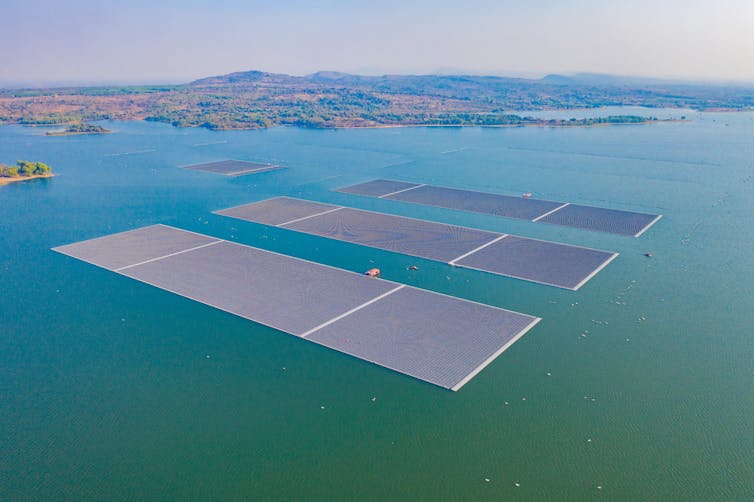
Vast arrays of solar panels floating on calm seas near the Equator could provide effectively unlimited solar energy to densely populated countries in Southeast Asia and West Africa.
Our new research shows offshore solar in Indonesia alone could generate about 35,000 terawatt-hours (TWh) of solar energy a year, which is similar to current global electricity production (30,000TWh per year).
And while most of the world’s oceans experience storms, some regions at the Equator are relatively still and peaceful. So relatively inexpensive engineering structures could suffice to protect offshore floating solar panels.
Our high-resolution global heat maps show the Indonesian archipelago and equatorial West Africa near Nigeria have the greatest potential for offshore floating solar arrays.

Solar Power Rules By Mid-Century
On current trends, the global economy will be largely decarbonised and electrified by 2050, supported by vast amounts of solar and wind energy.
About 70 square kilometres of solar panels can provide all the energy requirements of a million affluent people in a zero-carbon economy. The panels can be placed on rooftops, in arid areas, colocated with agriculture, or floated on water bodies.
But countries with high population densities, such as Nigeria and Indonesia, will have limited space for solar energy harvesting.
Their tropical location in the so-called “doldrum” latitudes also means wind resources are poor. Fortunately, these countries – and their neighbours – can harvest effectively unlimited energy from solar panels floating on calm equatorial seas.
Floating solar panels can also be placed on inland lakes and reservoirs. Inland floating solar has large potential and is already growing rapidly.
Our recently released paper surveys the global oceans to find regions that didn’t experience large waves or strong winds over the past 40 years. Floating solar panels in such regions do not require strong and expensive engineering defences.
Regions that don’t experience waves larger than 6 metres nor winds stronger than 15m per second could generate up to one million TWh per year. That’s about five times more annual energy than is needed for a fully decarbonised global economy supporting 10 billion affluent people.
Most of the good sites are close to the Equator, in and around Indonesia and equatorial west Africa. These are regions of high population growth and high environmental values. Marine floating solar panels could help resolve land use conflict.
Indonesia Has Vast Solar Energy Potential
Indonesia is a densely populated country, particularly on the islands of Java, Bali and Sumatra. By mid-century, Indonesia’s population may exceed 315 million people.
Fortunately, Indonesia has vast solar energy potential and also vast pumped hydro energy storage potential to store the solar energy overnight.
About 25,000 square km of solar panels would be required to support an affluent Indonesia after full decarbonisation of the economy using solar power.
Indonesia has the option of floating vast numbers of solar panels on its calm inland seas. The region has about 140,000 square km of seascape that has not experienced waves larger than 4m – nor winds stronger than 10m per second – in the past 40 years.
Indonesia’s maritime area of 6.4 million square km is 200 times larger than required if Indonesia’s entire future energy needs were met from offshore floating solar panels.
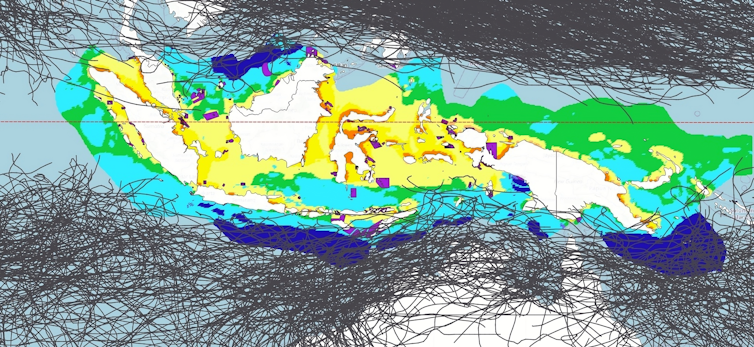
The Future For Offshore Floating Solar
Most of the global seascape experiences waves larger than 10m and winds stronger than 20m per second. Several companies are working to develop engineering defences so offshore floating panels can tolerate storms. In contrast, benign maritime environments along the equator require much less robust and expensive defences.
We have found the most suitable regions cluster within 5–12 degrees of latitude of the Equator, principally in and around the Indonesian archipelago and in the Gulf of Guinea near Nigeria. These regions have low potential for wind generation, high population density, rapid growth (in both population and energy consumption) and substantial intact ecosystems that should not be cleared for solar farms. Tropical storms rarely impact equatorial regions.
The offshore floating solar industry is in its infancy. Offshore solar panels do have downsides compared with onshore panels, including salt corrosion and marine fouling. Shallow seas are preferred for anchoring the panels to the seabed. And careful attention must be paid to minimising damage to the marine environment and fishing. Global warming may also alter wind and wave patterns. Despite these challenges, we believe offshore floating panels will provide a large component of the energy mix for countries with access to calm equatorial seas. By mid-century, about a billion people in these countries will rely mostly on solar energy, which is causing the fastest energy change in history. ![]()
Andrew Blakers, Professor of Engineering, Australian National University and David Firnando Silalahi, Phd Candidate, School of Engineering, Australian National University
This article is republished from The Conversation under a Creative Commons license. Read the original article.
Call of the huia: how NZ’s bird of the century contest helps us express ‘ecological grief’
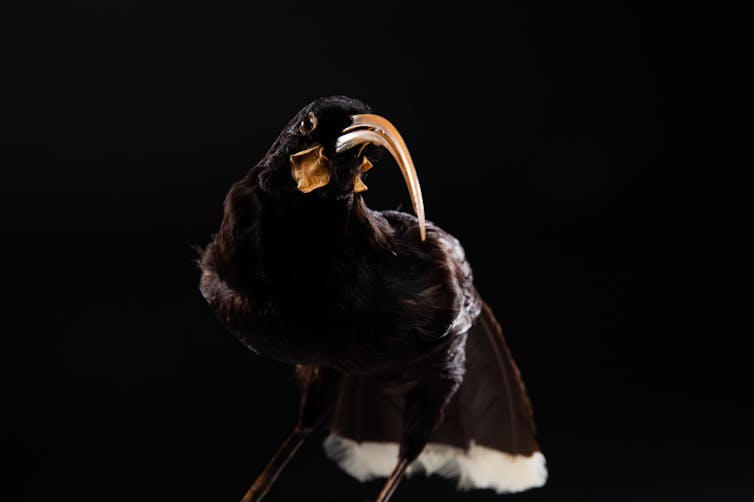
Humans typically reserve their practices of mourning for loved ones. But extending these rituals of grief and loss to non-human animals (and our shared habitats) can also help us appreciate being part of the natural world, not separate from it.
So the recent decision to include extinct species in New Zealand’s Bird of the Year – now Bird of the Century – competition offers an opportunity to grieve in another way. In turn, this may help foster an ethic of care for the environment and greater appreciation of what may yet be saved.
The competition began 18 years ago as a modest campaign by environmental group Forest & Bird to draw attention to native birds, many of which are endangered. It has since grown into a national phenomenon.
Various bird species have their own “campaign managers”, celebrities and politicians publicly endorse their favourite feathered creature, and tens of thousands of votes are cast every year.
The hotly contested election has not been without controversy, either. In 2019, for example, the discovery of hundreds of votes being registered from Russia led to claims of election meddling. In 2021, it made headlines for allowing a native bat to enter – to the dismay of many, the bat won.
Last year, the organisers were even threatened with a lawsuit over their refusal to include the extinct huia – a bird last seen in the wild in 1907. A concerned environmentalist wrote to Forest & Bird to say: “We need to be urgently reminded of what we have already lost, if we are to minimise further loss.”
This year’s competition – which opens for voting on October 30 and also marks Forest & Bird’s centenary – answers that call.
Ecological Grief
There are five contenders that have died out: the huia, mātuhituhi (bush wren), tutukiwi (South Island snipe), piopio (turnagras) and whēkau (laughing owl). Explaining their rationale, the competition organisers say:
Eighty-two percent of our living native bird species are threatened or at risk of extinction. We cannot let any more end up with the tragic fate of the laughing owl or the huia.
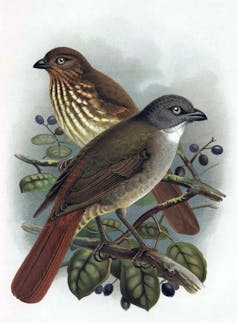
Those five birds represent only a small proportion of the total birdlife lost since first human settlement in Aotearoa around 750 years ago. Fossil record research has concluded that, of the 174 endemic bird species present then, 72 have become extinct.
Adding extinct birds to the Bird of the Year ballot – even if only five – echoes other, similar efforts around the world by people finding new ways to express grief over the loss of nature.
As the global climate crisis rapidly transforms the environment, there have been commemorative practices and rituals more often associated with human loss: funerals and memorial plaques for extinct animal species and vanished glaciers, and monuments to lost landscapes.
Because ecological grief differs from human-centred grief in important ways, it can have an upside. For one, it not only addresses an absence in the present, but it can also encourage pre-emptive action to stop losses yet to come.
Furthermore, ecological grief is often accompanied by feelings of guilt over the harm humans have done to the environment, which can create a strong sense of responsibility for nature, as survey research has shown.

Entanglement With Nature
Beyond helping prevent further loss of birdlife, commemorating extinct species through the Bird of the Year competition encourages an understanding of the connections that bind all lifeforms together.
Of course, such ideas only seem new from a Western perspective. Despite the violent disruptions of colonisation, Māori and other Indigenous peoples around the world have continued to hold worldviews where biological beings are interlinked in a complex web of life.
Expressions of ecological grieving, such as whakataukī (proverbs) mourning the loss of the moa, play an important role in maintaining these worldviews.
The decision to include extinct species in the Bird of the Year competition will likely cause controversy. But saving the planet means moving away from our usual perspectives and ways of thinking.![]()
Olli Hellmann, Associate Professor of Political Science, University of Waikato
This article is republished from The Conversation under a Creative Commons license. Read the original article.
A 140-year-old Tassie tiger brain sample survived two world wars and made it to our lab. Here’s what we found

Researchers often think how and when their results will be published. However, many research projects don’t see the light until decades (or even centuries) later, if at all.
This is the case of a high-resolution atlas of the Tasmanian tiger or thylacine brain. Carefully processed over 140 years ago, it is finally published today in the journal PNAS.
Similar, But Not Wolves
Thylacines were dingo-sized carnivorous marsupials that roamed through Australia and New Guinea prior to human occupation. They became confined to Tasmania around 3,000 years ago.
The arrival of European colonists and the introduction of farming, diseases and hunting bounties quickly led to their extinction. The last known individual died on September 7 1936 at Hobart’s Beaumaris Zoo. As a commemoration, September 7 became the National Threatened Species Day to raise conservation awareness in Australia.
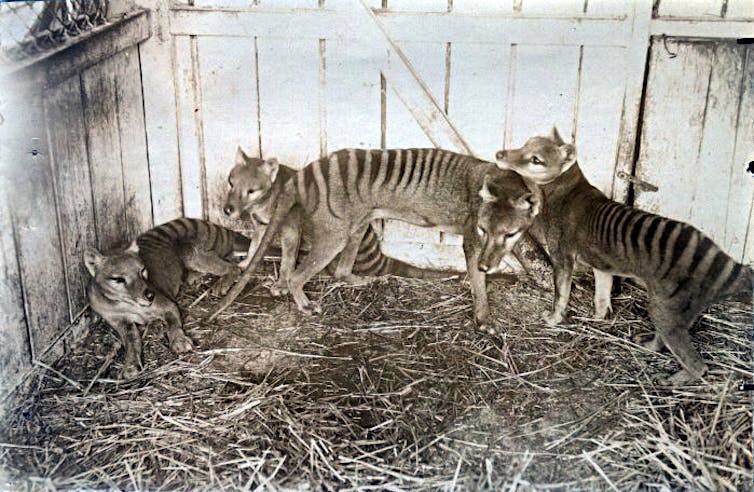
Thylacines looked remarkably similar to wolves and dogs (that is, canids). This is a textbook example of a process known as evolutionary convergence: when the body shapes of animals are really similar, despite them coming from different lineages.
However, whether thylacine brains are also similar to wolves has been very hard to find out, due to a lack of material available for microscopic studies. In the newly published study, my colleagues and I uploaded high-resolution images to a public repository, and studied brain sections prepared for microscopy from a thylacine that died in the Berlin Zoo in 1880.
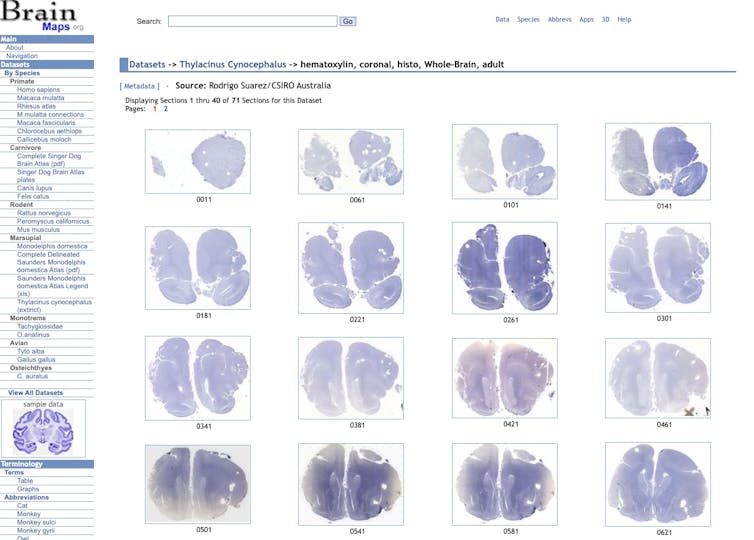
Kept Safe By Researchers
Unfortunately, very little information about this specimen was available (for example, its sex and body weight was missing). Details were likely lost during both world wars. But the samples were kept safe by researchers who understood their biological relevance.
Initial custodians likely included German scientists Oskar and Cecile Vogt, whose large privately owned brain sample collection was incorporated into the Kaiser Wilhelm Institute for Brain Research in 1914. Vogt – who also studied Lenin’s brain – was the founding director of the institute, prior to the couple escaping the Nazis in 1937.
The institute later became the Max Planck Institute for Brain Research and moved to Frankfurt in 1962. There, late neurobiologist Heinz Stephan handed the thylacine material to John Nelson from Monash University (co-author of this study) in 1973, to be returned to Australia.
The original samples are currently held by CSIRO’s Australian National Wildlife Collection in Canberra.

Brain Features Reveal A Family
So, what did we discover after analysing the samples? Overall, the thylacine brain resembles that of its carnivorous marsupial relatives (dasyurids, like dunnarts, quolls and Tasmanian devils) more than that of wolves or other canids.

The brain region known as the cerebral cortex, which is responsible for planning actions and sensing the environment, is larger than in other dasyurids. Brain regions involved in processing smells also suggest that scavenging and hunting behaviours were important in this species.
These findings show that despite body resemblance, brain features better show the evolutionary relatedness between species.
Making this material openly available allows for anyone to study the thylacine brain and gain a clearer picture of this long-gone species. Our ongoing research using dunnarts is also providing new insights about the development and evolution of the mammalian brain.![]()
Rodrigo Suarez, Senior Lecturer- School of Biomedical Sciences and Queensland Brain Institute, The University of Queensland
This article is republished from The Conversation under a Creative Commons license. Read the original article.
Many global corporations will soon have to police up and down their supply chains as EU human rights ‘due diligence’ law nears enactment

The European Union will soon require thousands of large companies to actively look for and reduce human rights abuses and environmental damage in their supply chains. And although it’s an EU law, it will also cover foreign businesses – including American ones – that have operations in the region.
The European Parliament approved a draft of the new rules in June 2023, and now EU member states and the European Commission will negotiate to finalize the law, which is expected to begin rolling out in phases a few years from now.
We study the impacts of human rights disclosure and due diligence laws on businesses. In the past, governments have generally asked only that companies voluntarily comply with efforts to advance human rights. The EU law would be the biggest attempt yet to legally mandate compliance – with major implications for human rights and businesses around the world.
Human Rights And Big Business
Human rights are those fundamental rights that all individuals hold simply by virtue of being human, such as rights to life and freedom of thought.
Human rights usually inform laws that limit what governments can do – for example, by obliging them to refrain from torturing people. Increasingly, however, they are also informing business regulations, because powerful companies can have serious impacts on individuals’ human rights.
Businesses have a long history of human rights abuses, from the British East India Co.’s pivotal role in the slave trade and IBM’s complicity in the Holocaust to more recent deadly environmental disasters involving oil and mining companies.
More contemporary examples of this are children in the Democratic Republic of Congo mining cobalt destined for cellphones or forced labor being used in the production of cotton in China’s heavily Muslim Xinjiang region.
In 2011, the United Nations Human Rights Council took a step toward policing these abuses by unanimously adopting “guiding principles” on business and human rights. These principles urge governments to compel companies in their jurisdictions to respect human rights wherever they operate. Such an approach stands in contrast to more common voluntary standards, such as supplier codes of conduct, which some observers have suggested have been ineffective.
In 2017, France became the first country to actually mandate that companies police their supply chains for human rights abuses.
The EU’s human rights due diligence law, first drafted in 2022, builds on the French version – but goes a few steps further.

Doing Your Due Diligence
Human rights due diligence is a process by which companies are meant to map out, understand and address all potential human rights abuses that occur throughout their operations.
The term “due diligence” is borrowed from the common business practice of financial due diligence, wherein financial risks are investigated before any large investment. So just as businesses evaluate financial risks, human rights advocates argue companies should put similar effort into investigating the risk that an activity might violate someone’s human rights.
The EU law would mandate that all large companies that operate in the bloc conduct human rights due diligence among their suppliers – by, for example, making sure child or forced labor wasn’t involved – but also on how their products are used by consumers – such as when a piece of technology is used to surveil citizens.
The law would cover most human rights, including labor rights and environmental rights, past or present. In practice, that would mean companies would have to map any harmful impacts that have occurred or could occur and take action to remedy or prevent them.
The rules would also include provisions for enforcement and penalties for noncompliance through fines and other sanctions. And victims of abuse would be able to seek damages.
In its current form, the law would cover EU companies with at least 500 workers and 150 million euros US$162 million) in net revenue, but those thresholds fall to 250 workers and 40 million euros ($44.5 million) in sectors with a higher risk of abuse, such as clothing, footwear and agriculture. Non-European companies must comply if they have EU revenues that meet those thresholds. An estimated 13,000 EU companies and 4,000 based outside of Europe – including household names like Apple, Amazon and Nike – would be subject to the law.
If it works as intended, the EU law could be transformative in protecting human rights, including worker health and safety and workers’ free speech, around the world. According to a recent report by human rights scholars, it could be “particularly valuable in the context of transnational supply chains, where the fragmented nature of production has long presented formidable legal and practical barriers to efforts to secure greater corporate accountability for labor rights violations and poor working conditions.”
Bad For Business?
While many companies have already endorsed mandatory due diligence rules, others worry this kind of government mandate would be too onerous.
A full map of risks in a company’s value chain – from raw materials to consumers – is difficult to establish when suppliers are separate companies operating on the other side of the world and global supply chains are frequently large and complex.
Some companies also strongly resist the idea of being held responsible for human rights violations that take place in their supply chains overseas.
Ripe For US Rules
For this reason, the U.S. has so far preferred voluntary rules when it comes to pushing companies to respect human rights.
But that’s slowly beginning to change.
In 2012, California implemented the Supply Chain Transparency Act, which requires companies operating in the state to disclose their “efforts to eradicate human trafficking and slavery” in their global supply chains. And in 2021, Congress passed the Uyghur Forced Labor Prevention Act, which bans the importation of goods mined, produced or manufactured wholly or in part in the Xinjiang Uyghur Autonomous Region of China – home of the Uyghur people, who have been subjected to an intense program of state suppression since 2017.
Between these rules there is a clear trend developing of an increasing number of U.S. companies being obligated to implement some form of human rights due diligence. But these rules, unlike the developing European approach, are very narrowly tailored and don’t require companies to routinely undertake due diligence.
As a result, the U.S. companies that would be subject to the EU rules would be at a competitive disadvantage to many of their domestic rivals.
That’s why we believe the time may be ripe for Congress to consider its own more comprehensive human rights due diligence law, which would let the U.S. take the lead on the issue and have more of a say in these global standards. We believe that such a move would also be a major boon to protecting the human rights of marginalized groups across the world.![]()
Rachel Chambers, Assistant Professor of Business Law, University of Connecticut and David Birchall, Senior Lecturer in Law, London South Bank University
This article is republished from The Conversation under a Creative Commons license. Read the original article.
Net zero: direct costs of climate policies aren’t a major barrier to public support, research reveals
Lorraine Whitmarsh, University of Bath; Caroline Verfuerth, Cardiff University, and Steve Westlake, Cardiff UniversityAmid headlines of wildfires raging across Europe and Africa and flooding in China, the UK government took the bewildering choice to expand fossil fuel extraction.
Prime minister Rishi Sunak declared that more than 100 new oil and gas drilling licences would be granted for the North Sea in 2023, sparking widespread criticism and incredulity from climate experts, business leaders and some within his own party. The latest announcement follows other indications that the UK government is reviewing its climate commitments, spurred by a byelection victory that was won in part by opposing London’s ultra-low emission zone (Ulez).
Much of this backsliding relies on dubious logic: that the economic costs of green policies, and how they affect people’s lives, make them damaging for the UK and will always lose votes. As researchers who study public attitudes towards such policies, we are quite sure these arguments from the government don’t hold water.
First, inaction on climate change costs more than action, as established nearly two decades ago in the landmark Stern review. The economic case has only strengthened since, with this year’s Skidmore review making clear the considerable opportunities for the UK in a net zero transition, including the potential creation of almost half a million green jobs.
Second, the government’s reluctance to intervene in people’s lives with climate policies does not reflect public opinion. There is actually UK-wide support for net zero policies – including those that would involve lifestyle changes. Crucially, the public wants and needs the government to show clear and consistent leadership on climate change.
Behaviour Changes Are Essential
Scientific assessments, including the latest report by the Intergovernmental Panel on Climate Change (IPCC) and analyses by the UK’s statutory advisers on climate policy, the Climate Change Committee, show that new technologies alone will not be sufficient for the country to hit its carbon targets.
Most measures to reach net zero require people to make at least some changes to their daily routines, including limiting car use, eating less red meat and dairy, buying electric vehicles and heat pumps, and reducing waste. Likewise, businesses will need to change their behaviour too.
While the scale of the necessary lifestyle changes is not well understood by the public, people are willing to play their part in a net zero transition. Polling shows public concern about climate change has remained high throughout the pandemic and the cost of living crisis. Most people worldwide agree that changes to our behaviour are necessary to tackle climate change.
Our research also shows that the UK public is broadly on board with net zero, including measures that would involve lifestyle changes. With the market research company Ipsos, we polled more than 5,000 people across the UK on their attitudes to a range of net zero policies. Our findings indicated high levels of public support (in both 2021 and 2022) for most of them, with support strongest for frequent flyer levies, changing product prices to reflect environmental impacts, phasing out gas boilers, and electric vehicle subsidies.
How To Maintain Public Support
It’s true that support drops when people are asked to consider the costs of climate policies. For example, while 68% support the general idea of charging frequent flyers more for each additional flight they take in a year, when the financial costs to the individual are spelled out, support falls to 32% (and opposition rises from 16% to 33%).
This is perhaps no surprise. Previous research showed that even mentioning a very modest cost can make people less likely to support a policy, including climate measures.
On the other hand, emphasising the effectiveness or wider benefits of climate policies can increase support for them. One study conducted across 24 countries showed that highlighting additional benefits, such as cleaner air or stronger social cohesion, increased a person’s motivation to take action on climate change.
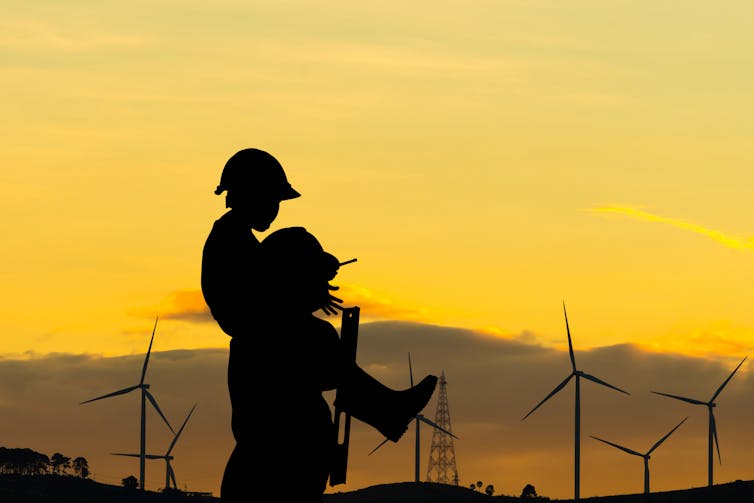
Even more important for public acceptance is how fair a policy is seen to be, as revealed both by our research and other studies. Indeed, fairness was a key topic in the Ulez debate during the Uxbridge byelection, where drivers of older vehicles were seen by some as being unfairly penalised and inadequately supported, for instance through scrappage schemes.
The fact that fairness can mean different things to different people highlights the need for the government to engage with the public when designing climate policies. Deliberative processes such as climate assemblies can help with this.
There are other important factors. Workshops we held across the UK showed that public support for net zero policies remains high as long as people feel they still have personal choice, their freedoms are protected, and they trust those who are implementing the policies. We found only very restrictive policies are opposed, such as mandating meat-free diets, no flying or a car-free lifestyle.
Win-Win Policies
The fluidity of public support for climate action highlights the importance of a clear vision and consistent leadership from the government. Instead of rolling over at the first hint of controversy, political leaders should present a vision of a sustainable future that everyone can work towards, involving a stable climate, cleaner air, and healthier lifestyles. Licensing new oil and gas drilling obviously runs counter to this.
While the UK government may shy away from promoting climate-friendly behaviour changes because they equate them with sacrifice, in fact, people with low-carbon lifestyles tend to be happier than those who consume more. And at a time of economic hardship, the UK government could focus efforts on measures that at once reduce energy bills and also cut emissions – for example, through support for home insulation.
Making behaviour change policies convenient and affordable requires governments to intervene with regulations and incentives. A clearly communicated vision to keep the public on board, and a programme of public engagement that creates an honest, society-wide dialogue on net zero and a sense of collective effort, is essential to their success.

Don’t have time to read about climate change as much as you’d like?
Get a weekly roundup in your inbox instead. Every Wednesday, The Conversation’s environment editor writes Imagine, a short email that goes a little deeper into just one climate issue. Join the 20,000+ readers who’ve subscribed so far.![]()
Lorraine Whitmarsh, Professor of Environmental Psychology, University of Bath; Caroline Verfuerth, Research Associate, Centre for Climate Change and Social Transformations, Cardiff University, and Steve Westlake, Research Associate, Climate Leadership, Cardiff University
This article is republished from The Conversation under a Creative Commons license. Read the original article.
I’ve spent 50 years studying one seabird colony fight its way back from near extinction – now it faces new threats
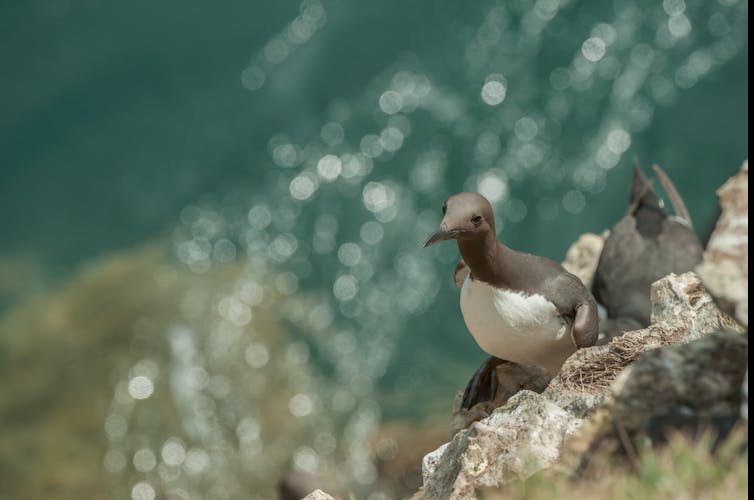
Over the past few decades, Skomer Island off the south coast of Wales has witnessed a remarkable resurgence in its guillemot population. Before 1930, Skomer was home to over 100,000 common guillemots. But by the end of the second world war, this number had plummeted by about 95% and continued to decline for the next few decades.
This population decline was probably caused by chronic oil pollution during the second world war and several major oil tanker incidents in the subsequent years. In 1967, for example, the supertanker SS Torrey Canyon spilled over 100,000 tonnes of crude oil into the English channel.
However, counts conducted by the Wildlife Trust of South and West Wales show that Skomer’s guillemot population has consistently grown at an annual rate of about 5% since the 1980s. In 1972, there were around 2,000 guillemots breeding on Skomer. Fast forward to 2023 and that number has skyrocketed to around 30,000.
This resurgence has been the subject of a long-term study conducted by myself and my colleagues over past 50 years. The increase in Skomer’s guillemot population is remarkable considering that populations in northern regions of the country have declined over the same period.
But our study also reveals that seabirds, including Skomer’s guillemots, now face several pressing threats – with climate change emerging as one of the most significant challenges.
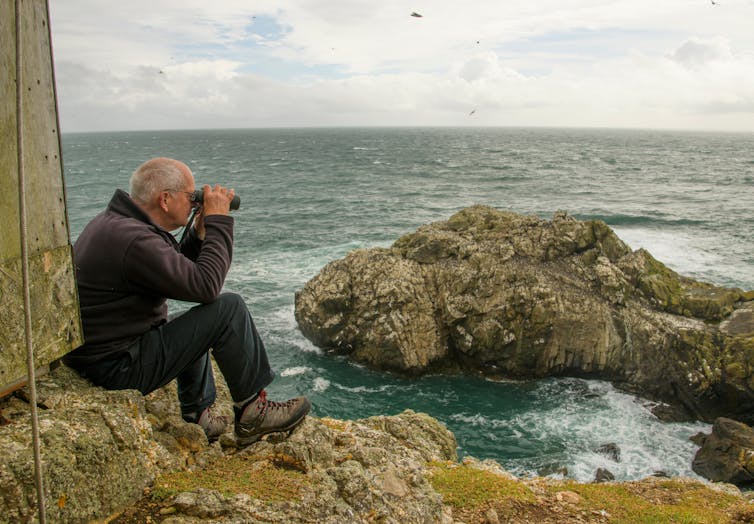
Guillemots On The Rise
We have been monitoring the survival and breeding success of guillemots on Skomer. Our aim was to establish whether chick production, breeding age and adult and chick survival rates could explain the observed increase in their numbers. It took 30 years until we had a sufficient sample size to address these questions.
Our results showed that the population increase since 1980 is entirely due to the productivity and survival of the Skomer birds themselves. In fact, there’s relatively little immigration or emigration affecting the colony’s numbers.
There has, however, been a marked reduction in oil pollution in waters surrounding the UK in recent years. In the 1970s, around 90% of the dead guillemots found on beaches surrounding the North Sea were contaminated with oil. By 2020, this proportion had fallen to 10%.
This decline in oil pollution may be what has allowed the guillemot population on Skomer and other southern regions of the UK to bounce back towards the levels seen before 1930.
Breeding Earlier
However, seabirds, including Skomer’s guillemots, continue to face a multitude of threats. Oil pollution has declined, but it has been superseded by the even more insidious and far-reaching effects of climate change. Together with persistent overfishing and the recent emergence of avian flu, climate change has further contributed to the increasing fragility of seabird populations.
One of our most striking results is that the timing of guillemot breeding has advanced by more than two weeks on average since the 1970s. The cause of this advance, which has also been noted in many bird species on land, is probably climate change.
We believe the early breeding season might be linked to the seasonal availability of their fish prey. There is increasing evidence that warmer seas are having a marked effect on both the distribution and abundance of marine fish in the UK.
Dealing With Extreme Weather
Climate change is also causing an increase in the frequency and intensity of winter storms. Sustained bad winter weather makes it difficult for guillemots and puffins (another member of the bird family known as auks) to find food. This can lead to devastating “wrecks” where large numbers of dead seabirds wash up on the shore.
In early 2014, a series of storms resulted in the deaths of over 55,000 seabirds around European coastlines, including 15,000 guillemots. In that year, the mortality rate of Skomer’s adult guillemots doubled to 12%.
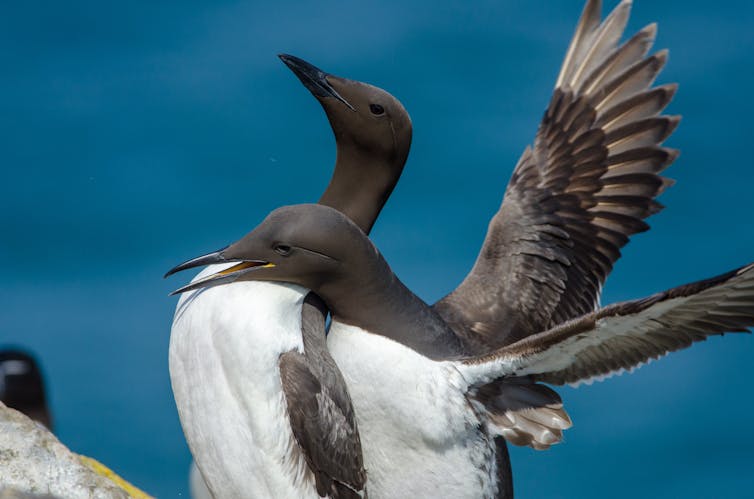
More worrying is the increasing incidence of extreme weather during the guillemots’ breeding season. Summers are witnessing stronger winds, rougher seas, torrential rain and extreme heat – all of which can reduce guillemot breeding success.
In May 2022, for example, two unseasonal storms resulted in many guillemots losing their eggs from breeding ledges, leading to the lowest breeding success we have seen on Skomer for several decades.
Long-term studies like mine provide the information that allows us to identify and measure the effects of different threats. In a few cases, they may also allow us to take action to minimise their effects. Yet these studies are few and far between.
As I see it, long-term studies on Skomer provide the ammunition that can help us fight the war against climate change and environmental degradation. Now more than ever, it is important that such studies continue.

Don’t have time to read about climate change as much as you’d like?
Get a weekly roundup in your inbox instead. Every Wednesday, The Conversation’s environment editor writes Imagine, a short email that goes a little deeper into just one climate issue. Join the 20,000+ readers who’ve subscribed so far.![]()
Tim Birkhead, Emeritus Professor of Zoology, University of Sheffield
This article is republished from The Conversation under a Creative Commons license. Read the original article.
Rishi Sunak’s green backtracking contrasts strongly with previous prime ministers’ efforts
Marc Hudson, University of SussexUK prime minister Rishi Sunak appears to be wavering on “net zero by 2050” that Theresa May successfully passed through parliament with barely a cough of disapproval in 2019. Sunak is now talking about more “proportionate and pragmatic” government climate policies, while also announcing plans to issue at least 100 licenses for new oil and gas projects in the North Sea.
This shift comes at a time when British holidaymakers are fleeing wildfires in Rhodes and Corfu, and so many climate records are tumbling that it’s hard to keep up.
The Conservative Environment Network, an independent forum for conservatives who support net zero, and others including Greenpeace, are trying to stiffen his spine. But Sunak appears minded to appease those on the “right” who are opposed to anything green.
This stance might seem surprising. But taking a global and historical perspective provides some context to the situation.
The UK Story
The UK’s modern environment movement can be dated back to 1969 when the then prime minister, Harold Wilson, gave the first ever speech to a party congress that mentioned “the environment”. Visiting the US the following year, Wilson proposed a new special relationship based on environmental protection.
Far from decrying this, Conservative opposition leader Edward Heath accused Wilson of being too slow. When Heath became prime minister in 1970, he created a huge Department of the Environment.
While “the environment” faded from the headlines thanks to the oil price spike of 1973, high inflation and other issues, neither the Tories nor Labour backtracked. In 1979, new prime minister Margaret Thatcher even mentioned the greenhouse effect while in Tokyo for a G7 meeting.
However, Thatcher took an obstructive line on acid rain. This was something Sweden was especially exercised about, since sulphur from British coal stations was altering its lakes and rivers.
It was only in 1988, after persistent lobbying from scientists and diplomats that the lady was for turning. Her speech to the Royal Society (a fellowship of eminent scientists) about the “experiment” humanity was conducting in tipping so much carbon dioxide into the atmosphere is regarded as the starting point for modern climate politics.

Thanks to switching from coal to gas in the 1990s, and moving industry offshore, the UK could for a long-time boast of reducing its emissions and speak nobly of sustainable development. In 1997, Tony Blair said the UK would go further in cutting emissions than whatever target was set at the UN conference in Kyoto, the first agreement by rich nations to cut greenhouse gases. This was met with few grumbles from the Tories.
In the late 2000s there was a fierce “competitive consensus” (where politicians try to outbid the their competitor’s bid for votes and virtue) around passing a Climate Change Act. The then new Conservative leader, David Cameron, had taken a trip to the Arctic and was now saying “can we have the bill please”.
Very few Conservative MPs voted against the 2008 Climate Change Act, which set an 80% reduction in emissions by 2050 and placed restrictions on the amount of greenhouse gases the UK could emit over five-year periods.
Once in power, Cameron supported fracking, opposed onshore wind, and scrapped climate policies in a self-defeating effort to reduce costs (allegedly ordering aides to “get rid of all the green crap”). But he did not, at least not directly, attack the Climate Change Act.
After the Paris agreement in 2015, which the UK signed, it became clear that 80% would not be enough of a target to have the UK meet its obligations to do its part to keep global warming under 2℃. And pressure built for a net zero emissions by 2050 target. This was one of Theresa May’s final acts, and was enthusiastically endorsed by all parties.
So What’s Gone Wrong?
Politicians tend to like targets that are distant, round numbers like 2050. They get the glow, without the pain of upsetting either vested interests or demanding that ordinary people change their behaviour. What we are seeing now, I believe, is a collision between what the promises were and what the immediate action has to be.
This is not unique to the UK. There have been periods, albeit brief, of bipartisan consensus around environmental issues in both Australia and the US.
But once in power, Conservative governments have tended to prioritise “free markets” over what they label as irksome or socialistic environmental regulation. The main motor of climate denial, and framing green concerns as like a “watermelon” (green on the outside, red on the inside) has historically been the United States.
One way of looking at what is happening in the UK Conservative Party now is that the same imported “culture war” tropes that gave the UK an unevidenced “voter registration” panic in May 2023, is now turning to climate policy. This phenomenon is what was behind the recent Just Stop Oil action at Policy Exchange, a right-wing think tank that helped draft controversial new laws cracking down on climate protesters.
The recent Uxbridge by-election result, where the Conservatives’ narrow victory was driven by anger against London’s ultra-low emissions zone (an area where drivers of the highest-polluting vehicles must pay a fee), is likely to have whetted the appetite of right-wing Tory strategists.
They may see this as a way of dividing Labour and either winning the next election by weaponising climate policy, or at the very least, reducing their losses to “manageable proportions”.
Meanwhile, the emissions climb, the ice melts and the waters warm. And everyone will be holding their breath for every food harvest from here onwards.

Don’t have time to read about climate change as much as you’d like?
Get a weekly roundup in your inbox instead. Every Wednesday, The Conversation’s environment editor writes Imagine, a short email that goes a little deeper into just one climate issue. Join the 20,000+ readers who’ve subscribed so far.![]()
Marc Hudson, Visiting Fellow, Science Policy, University of Sussex
This article is republished from The Conversation under a Creative Commons license. Read the original article.
Commonwealth Youth Games 2023: Local Athletes Set To Shine In Trinbago - Trinidad

The Trinbago 2023 Commonwealth Youth Games, officially known as the VII Commonwealth Youth Games and commonly known as Trinbago 2023, will take place from 4-11 August 2023 US Time/dates. The Opening Ceremony in Trinidad on 4 August 2023 (5 August AEDT) marked the commencement of seven days of competition at Trinbago 2023.
The Commonwealth Youth Games (CYG) are an international multi-sport event organised by the Commonwealth Games Federation (CGF). The Games bring nations together in a colourful celebration of sport and human performance, giving young athletes aged between 14-18 a platform to develop their skills and gain valuable experience on the international stage.
The event was first held in 2000 in Edinburgh, Scotland and since then, have been held an additional five times. The Trinbago 2023 Commonwealth Youth Games will be the seventh time the event is held, with more than 1000 athletes expected to compete across seven sports.
Seven local athletes are part of the Trinbago 2023 Commonwealth Youth Games:
Athletics: Jackson Love (Sydney Pacific Athletics - Warriewood resident) – Men’s 100m T38, Long Jump; Fleur Cooper (UTS Norths - Allambie resident) – Women’s 800m, 1500m
Rugby 7's: Piper Simons (Manly Mermaids Rugby Union), Anaia Cruickshank (Manly Mermaids)
Swimming: Lillie McPherson (Manly Swimming Club), Samuel Higgs (Warringah Aquatic Swim)
Volleyball: Jett Rocker-Graham (Northern Beaches Volleyball)
The Australian team is being led by Paralympic champion Ellie Cole OAM with support from Birmingham 2022 representative Greg Hire. Our team features 74 athletes, supported by 39 officials, across the seven participating sports of athletics, beach volleyball, cycling, FAST5 netball, swimming, rugby 7s, and triathlon, with FAST5 Netball and both Individual and Mixed Triathlon events debuting at this games.
For the first time, para-athletics has been included in the Youth Games program. Trinbago 2023 will also see the debut of
The Trinbago Games will feature seven sports and over 1000 athletes. There will be 94 different medal events.
The uniform that Australian Team Members will don at the Games features a range of competition wear and training gear to be worn throughout the Games and includes more than 80 unique apparel items that will be worn by the team. The ‘Unity’ symbol, designed by Gulumerridjin (Larrakia), Wardaman and KarraJarri Saltwater woman Jenna Lee, a legacy of the Gold Coast Games Reconciliation Action Plan that represents a team that is unified and ‘Greater Together’, also features across many of the uniform items.
The sports will take place across Trinidad and Tobago, bringing a diverse perspective of the twin island country to the nations of the Commonwealth, as well as showcasing a festival of the country’s activities.
The Australian Team as a whole will look to showcase dominant performances in the pool, building on the success of previous Commonwealth Youth Games outings.
In the last Commonwealth Youth Games in the Bahamas in 2017, Australia won one gold, two silver and five bronze medals as they finished sixth on the medal table after all the action in the pool wrapped up.
Australia has selected a team of 76 athletes, supported by 39 officials.
Jackson Love competes in athletics and currently represents Sydney Pacific Athletics Club, having started when he was 8 years old. His recent sporting achievements include being selected for the Trinbago 2023 Commonwealth Youth Games, equalling the Australian T35 100m all-comers record, and breaking the Oceanian T35 Open 100m record. His future aspirations include representing Australia at the World Paralympic Championships and Paralympic Games.
Fleur Cooper competes in athletics and currently represents UTS Norths, having started when she was 8 years old. Her most recent sporting achievements include being the 800m U18 National Champion, and she aspires to compete at a Commonwealth Games, World Athletics Championships and Olympic Games.
Jett Rocker-Graham competes in beach volleyball and currently represents the Northern Beaches Volleyball Association, having started when he was 4 years old. His most recent achievements include winning the Mikasa Cup, placing 5th at the Australian Championships, and three-peating the U17, U18 and U19 Divisions of the Australian Youth and Junior Beach Volleyball Championships. His aspirations include winning the Youth Commonwealth Games, Commonwealth Games and Olympic Games.
Anaia Cruickshank competes in rugby 7s and currently represents Manly Mermaids, having started when she was 12 years old. Her recent achievements include making the 2022 Australian Youth Rugby 7s team and placing 2nd at World Schools, as well as being part of the 2023 NSW All School Champion Team. Her aspirations include winning gold at this year’s Trinbago 2023 Commonwealth Youth Games and making the Australian Women’s 7s team, competing at the Olympic Games.
Piper Simons competes in rugby 7s and currently represents Manly Mermaids Rugby, having started when she was 15 years old. Her recent sporting achievements include being named to both the Australia A 7s and Australia Youth 7s for 2022-2023, and the Australia Schoolgirls Rugby League 2022 Team. Her aspirations include being named to the Australian Women’s 7s Team and competing at an Olympic Games.
Samuel Higgs competes in swimming and currently represents Warringah Aquatic Swim Club, having started when he was only 6 months old. His recent achievements include claiming 4 medals at the recent 2023 National Age Championships and being selected onto two junior national squads, and his future aspirations include making a senior national team and being selected to an Olympic Team.
Lillie McPherson competes in swimming and currently represents Manly Swimming Club, having started when she was 8 years old. Her recent achievements include winning 5 gold medals at the 2023 Age National Championships and competing in the World Championship Trials, while her aspirations include being selected onto the Dolphins Team and breaking an Australian record.
Australia is preparing to defend its gold medal in rugby 7s, one of the sports being contested at the upcoming Youth Games – here’s what you need to know.
How to stay across the action
Sports which will be livestreamed: Athletics, Beach Volleyball, Cycling (Track), FAST5 Netball, Rugby 7s, and Swimming will all be livestreamed.
Cycling (Road) and Triathlon will not be livestreamed, with highlights instead available at the end of their competition days.
Access the livestream: LIVE streams will be available from the Organising Committee’s YouTube channel: Trinidad and Tobago Olympic Committee, which can be accessed here:
LIVE COVERAGE OF TRINBAGO 2023
In March 2023 Trinidad and Tobago’s Minister of Sport and Community Development, Shamfa Cudjoe, and representatives of the Local Organising Committee, unveiled the mascot design for the Trinbago 2023 Commonwealth Youth Games, at a celebration to mark Commonwealth Day.
The mascot, Cocoyea the leatherback turtle, is based on a design by local, young artist Djibril Annisette, from Port of Spain, who was the winner of a competition run for schoolchildren in Trinidad and Tobago. Inspired by eight-year-old Djibril’s winning entry, designers created the final artwork, which will now be brought to life, becoming one of the most recognisable faces of the Games.

The concept behind Djibril’s design is that, just like the tough, flexible spine of the coconut frond, Cocoyea, represents resilience in the face of difficulty. Its strong flippers serve to sweep away divisive elements, while simultaneously enveloping all citizens in a warm and unifying space. The leatherback turtle is important to Trinidad and Tobago for its ecological, economic, and cultural significance. What’s more, the mascot’s back, or shell, depicts elements of the national instrument, the pan, another important part of the country’s DNA.
Representing Australia
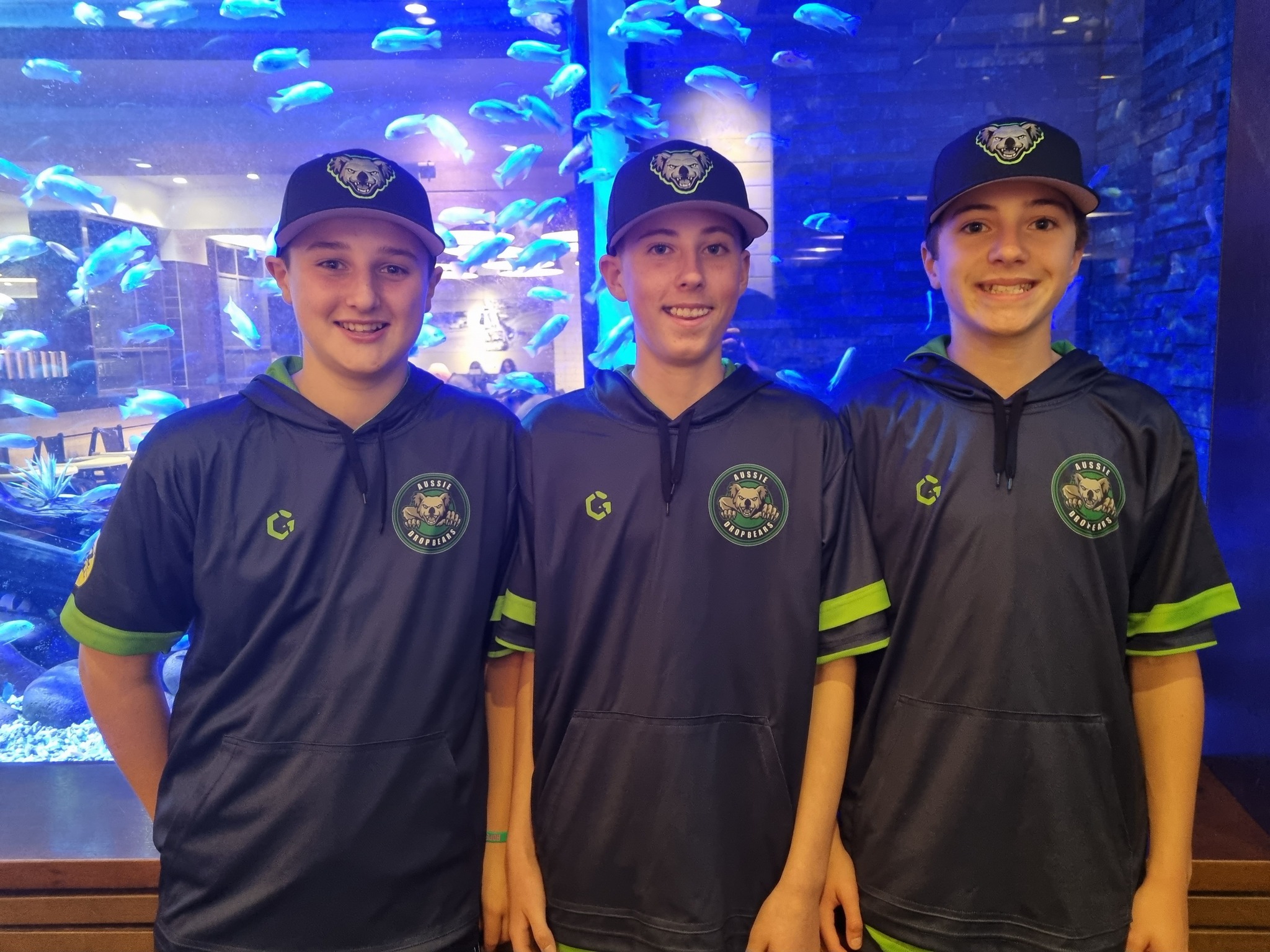
Ah Honey – Local Band With Sweet Sounds

Turimetta Moods
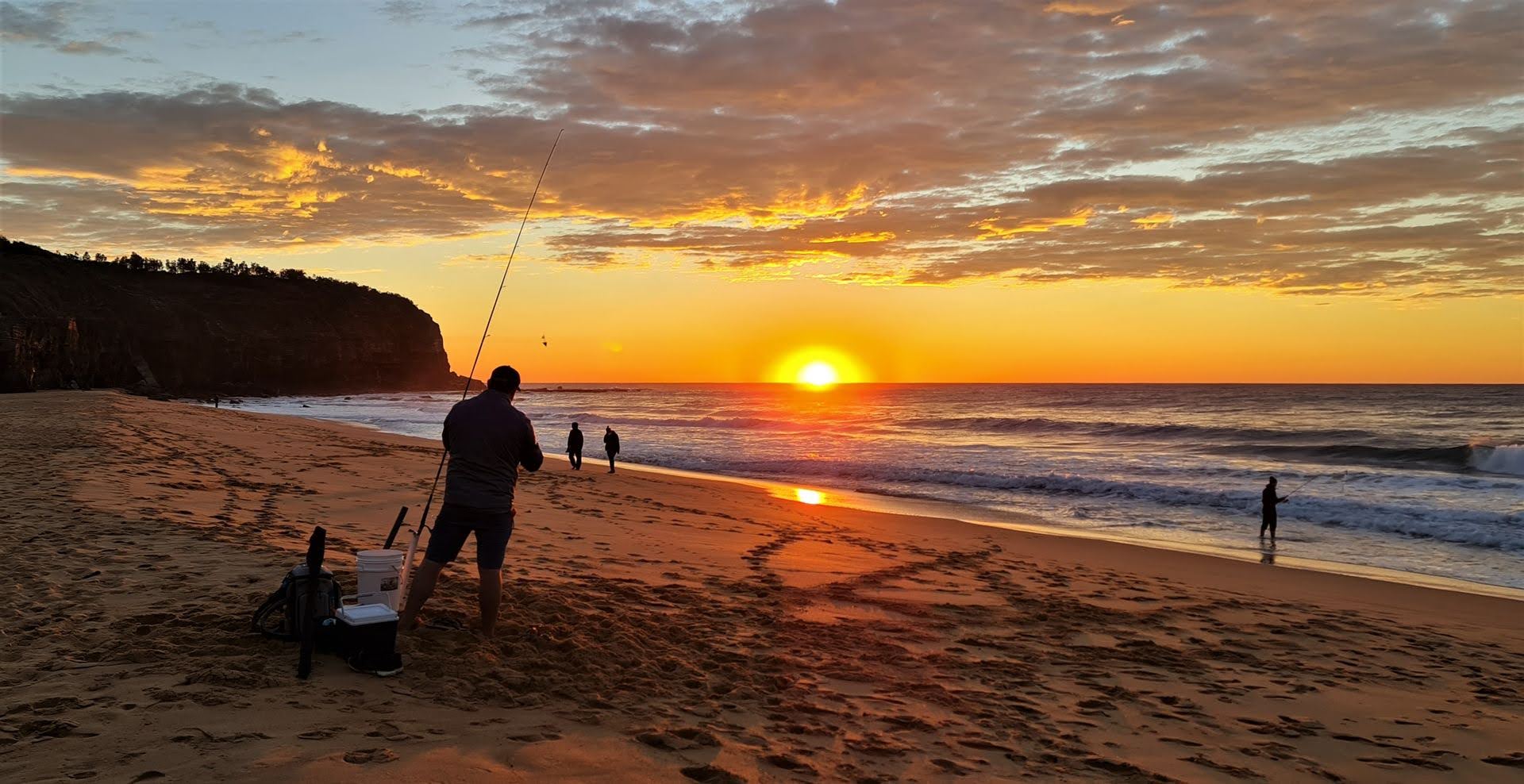
South Av. On A Sunday Afternoon
Pittwater's Aquatic Birds
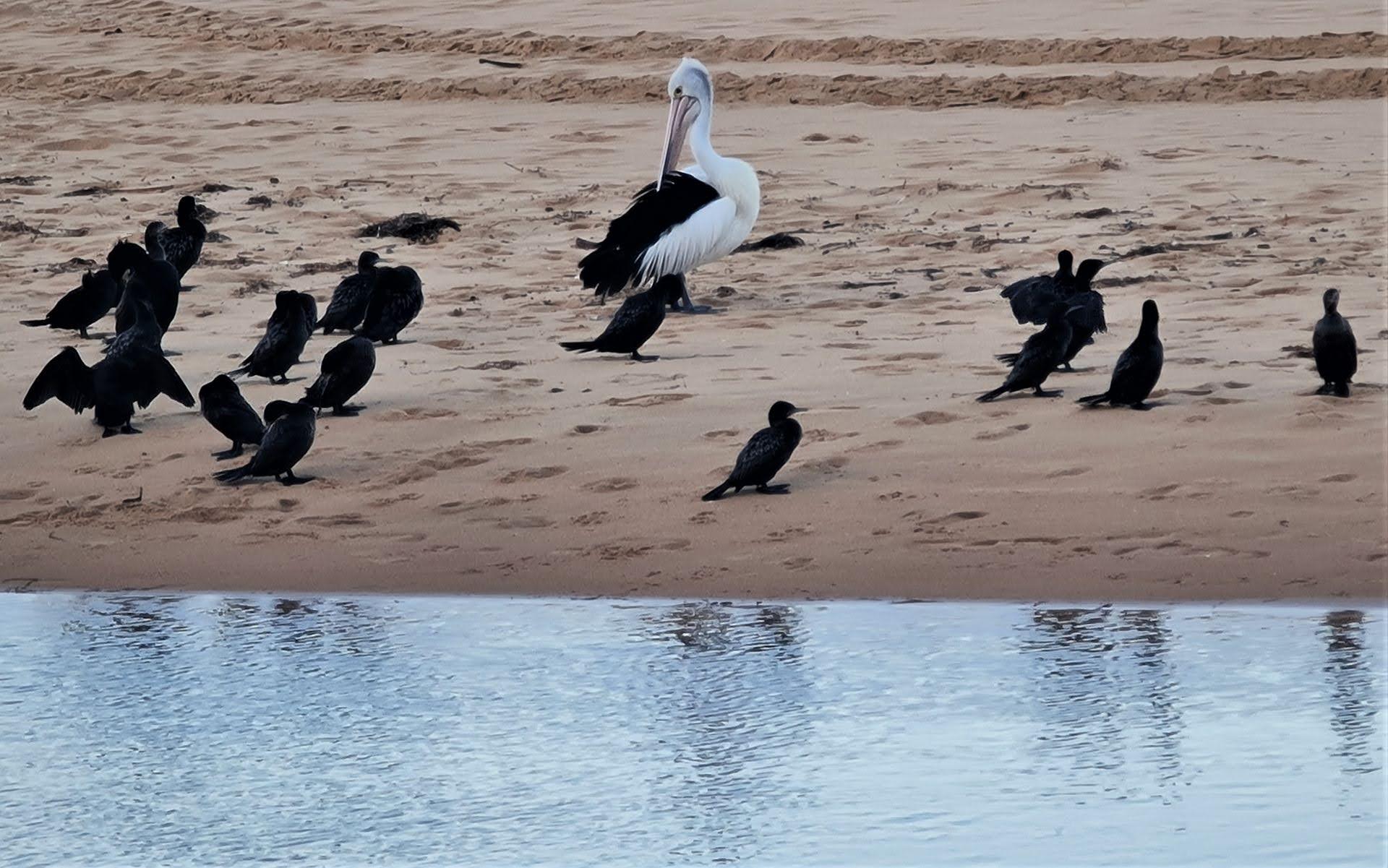
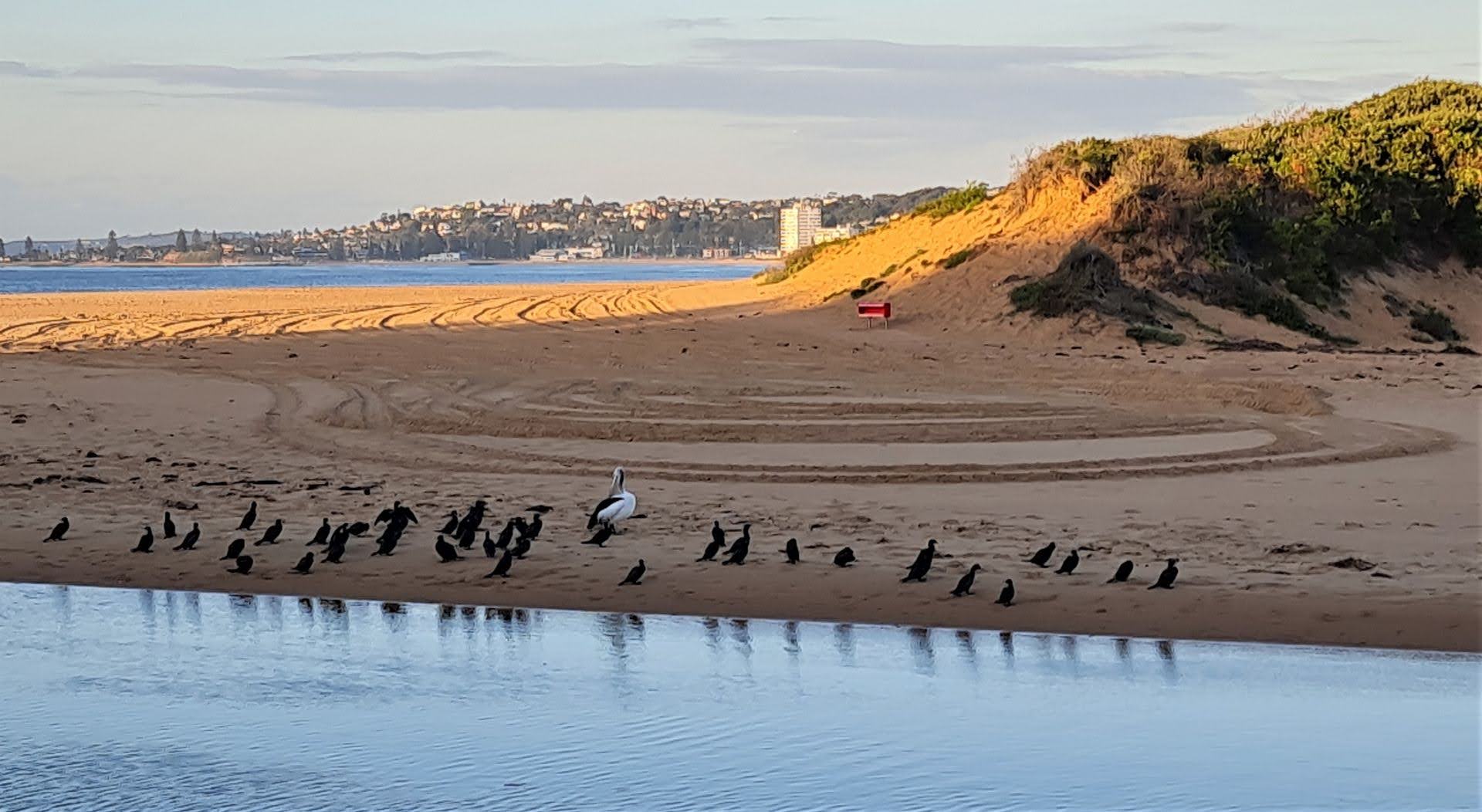
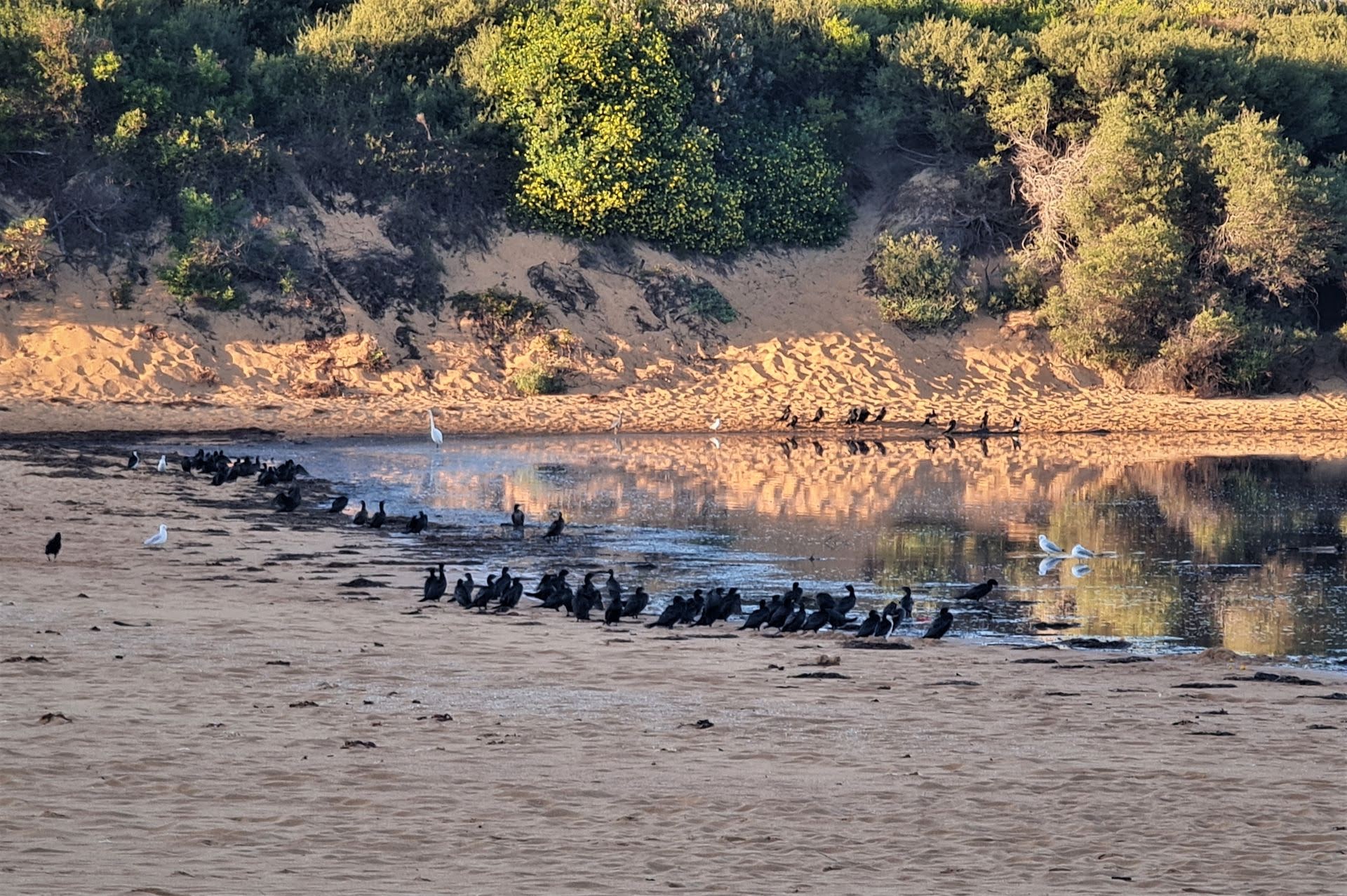
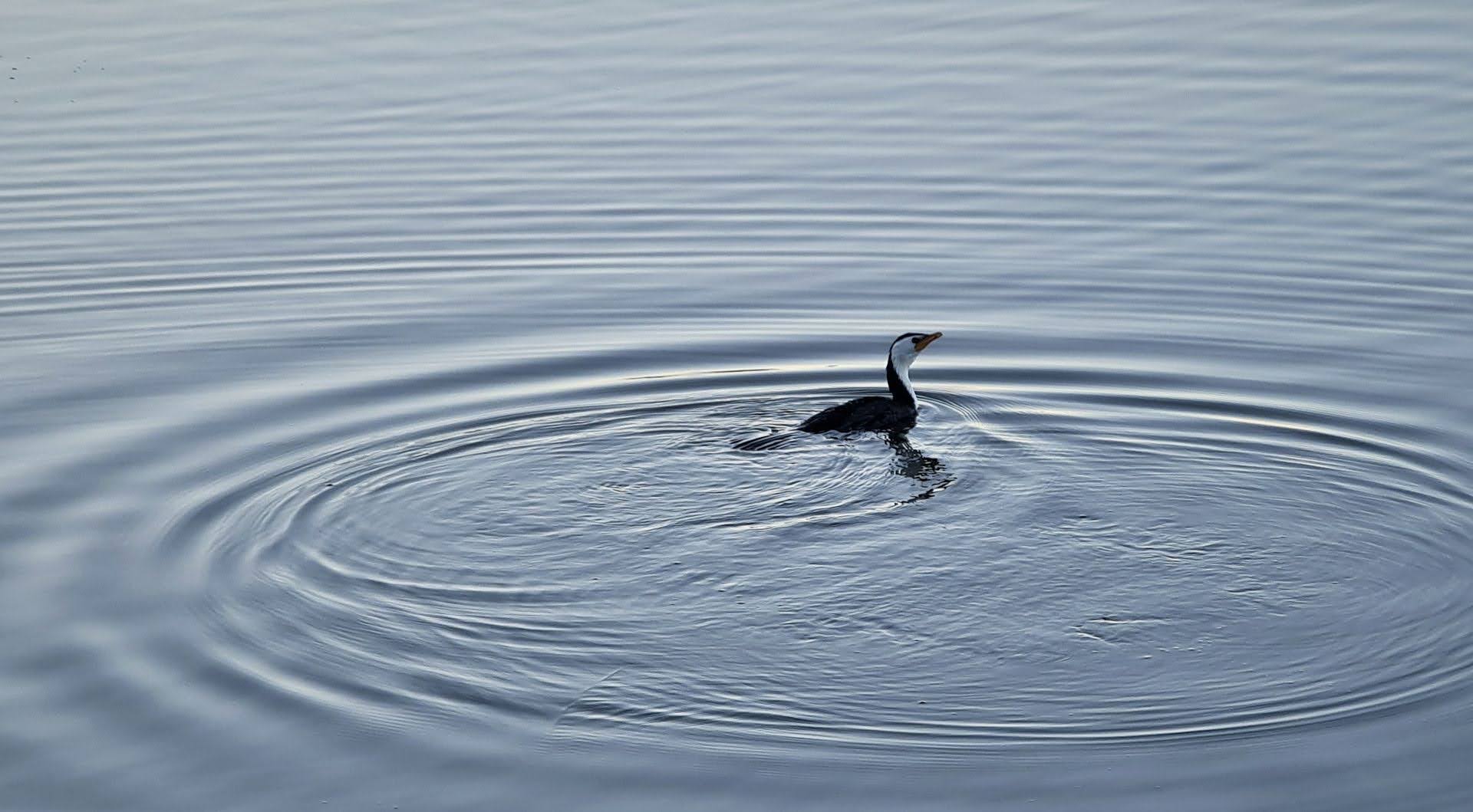
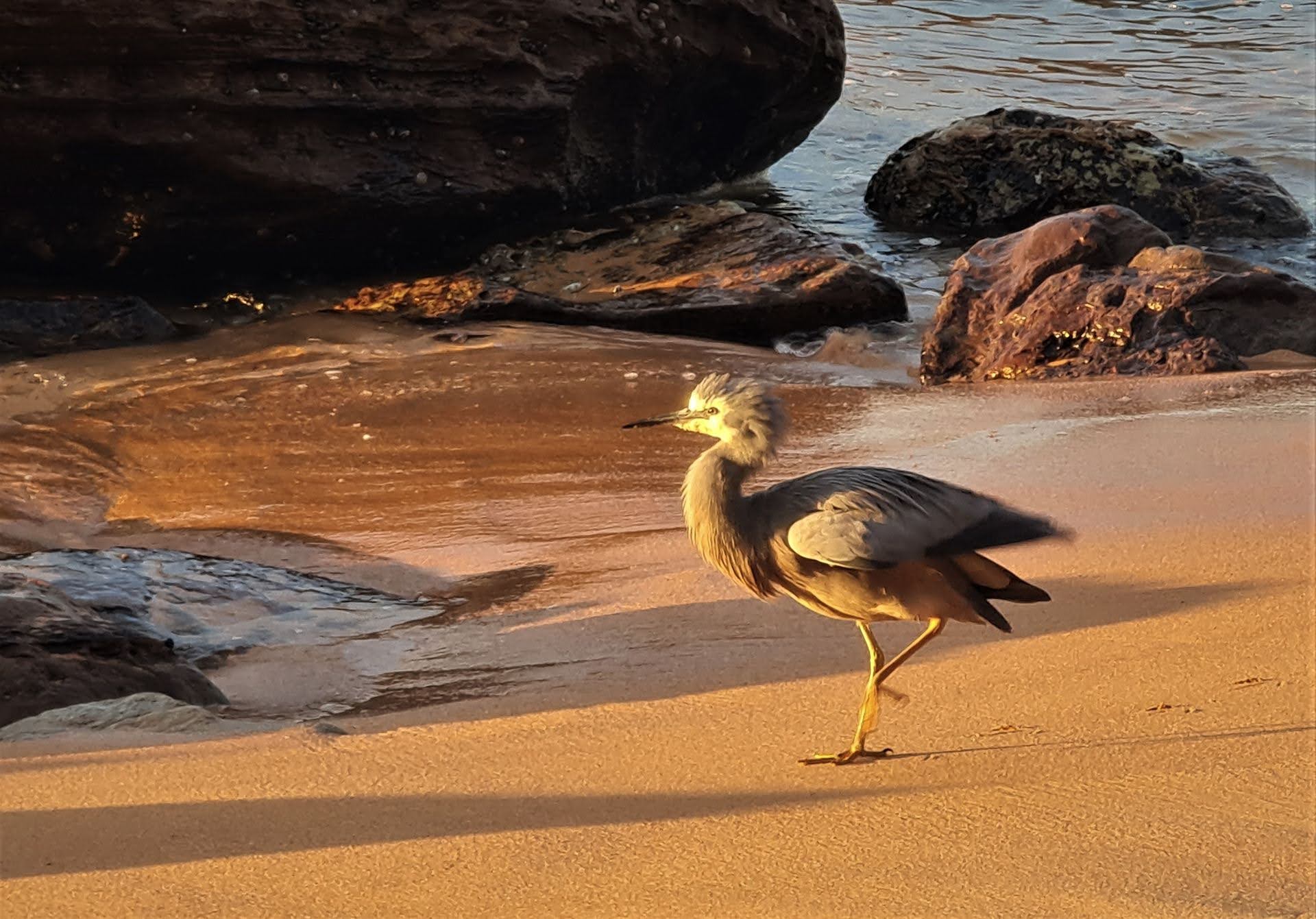
ACCC: Record Penalties Of $438m Ordered Against Phoenix Institute And CTI For Acting Unconscionably And Misleading Students
Young TAFE NSW Graduate Wins Sydney Cook-Off
 TAFE NSW Commercial Cooking graduate Ethan Annesley has won the New South Wales Metro Nestlé Golden Chef’s Hat Award competition against the top young chefs in the region, earning him a place in the National Grand Final Cook-Off.
TAFE NSW Commercial Cooking graduate Ethan Annesley has won the New South Wales Metro Nestlé Golden Chef’s Hat Award competition against the top young chefs in the region, earning him a place in the National Grand Final Cook-Off.Parli-Flicks Short Film Award 2023
Lights, camera, action!
NSW high school students, it’s time to shoot your shot for the 2023 Parli-Flicks Short Film Award.
The brief? Create a one-minute short film that takes a stand on whether the voting age should be lowered or kept at 18 in NSW.
Animation, music, comedy, drama, what’s your angle? This is your chance to be creative!
The winner will take home a $250 cash prize, with the finalists invited to an exclusive awards night at the Parliament of NSW.
Entries are open to Year 7 – 12 NSW high school students and close Friday August 11th 2023.
Want your school to participate? Visit our Education website for entry details and more information to share with your school administration.

Your First Speech To The Australian Parliament
Your first speech is a great way to speak about issues you are passionate about. You could enter as an individual or get your whole school involved!
Australian students enrolled in years 10 to 12 are invited to enter the 'My First Speech' competition.
You can enter as a school or as an individual.
Imagine yourself as a newly elected Member of the House of Representatives. Your task is to write a 90 second speech about issues you are passionate about then record yourself presenting the speech on video.
The video should be in MPG, MPEG, M4V, MPEG 4, AVI, WMV or MOV format with a resolution of 640 x 480 pixels or above and no longer than 90 seconds in length. Opening titles or end credits are not required.
A winner from each year, 10, 11 and 12, will be invited to Canberra to deliver their speeches live and undertake a program of meetings at Parliament House.
To enter the competition, submit your video via email, along with a written transcript of your speech and completed competition forms. The scanned forms can be pdf or jpg format.
If your video is too large to be emailed (over 30mb) send it via Dropbox, Google Drive or even a USB along with a transcript of your speech and completed competition forms.
For mailed entries send to:
My First Speech competition
House of Representatives
PO Box 6021
Parliament House
Canberra ACT 2601
Entries must be received by Friday, 11 August 2023
Competition forms and more here: https://www.aph.gov.au/myfirstspeech/enter
Spring Netball Competition: Registration Opens July 31st

Unveiling Of The Manly Memorial, 16/10/1916 Australian Gazette. No.312.
School Leavers Support
- Download or explore the SLIK here to help guide Your Career.
- School Leavers Information Kit (PDF 5.2MB).
- School Leavers Information Kit (DOCX 0.9MB).
- The SLIK has also been translated into additional languages.
- Download our information booklets if you are rural, regional and remote, Aboriginal or Torres Strait Islander, or living with disability.
- Support for Regional, Rural and Remote School Leavers (PDF 2MB).
- Support for Regional, Rural and Remote School Leavers (DOCX 0.9MB).
- Support for Aboriginal and/or Torres Strait Islander School Leavers (PDF 2MB).
- Support for Aboriginal and/or Torres Strait Islander School Leavers (DOCX 1.1MB).
- Support for School Leavers with Disability (PDF 2MB).
- Support for School Leavers with Disability (DOCX 0.9MB).
- Download the Parents and Guardian’s Guide for School Leavers, which summarises the resources and information available to help you explore all the education, training, and work options available to your young person.
School Leavers Information Service
- navigate the School Leavers Information Kit (SLIK),
- access and use the Your Career website and tools; and
- find relevant support services if needed.
Word Of The Week: Trope
Noun
1. a figurative or metaphorical use of a word or expression. 2. a significant or recurrent theme; a motif. 3. something such as an idea, phrase, or image that is often used in a particular artist's work, in a particular type of art, in the media, etc. 4. in rhetoric (= the study of the ways of using language effectively), a way of using words that means something different from their ordinary meaning: 'For those unfamiliar with poetic tropes, synecdoche is a figure of speech by which the part stands for the whole, such as "wheels" to mean "a car". ' Rhetorical tropes of antithesis and opposition recur throughout Shakespeare's writing.' 5. a common or overused theme or device : cliché. 6. a phrase or verse added as an embellishment or interpolation to the sung parts of the Mass in the Middle Ages
A literary trope is the use of figurative language, via word, phrase or an image, for artistic effect such as using a figure of speech. When Romeo asks “What light through yonder window breaks?” and then answers “It is the east, and Juliet is the sun,” he’s using a type of trope called a metaphor.
The word trope has also undergone a semantic change and now also describes commonly recurring or overused literary and rhetorical devices, motifs or clichés in creative works. Literary tropes span almost every category of writing, such as poetry, film, plays, and video games.
The term trope derives from the Greek τρόπος (tropos), "turn, direction, way", derived from the verb τρέπειν (trepein), "to turn, to direct, to alter, to change". Tropes and their classification were an important field in classical rhetoric. Old English Old English tropes (genitive), via Latin 1530s, from Latin tropus "a figure of speech," from Greek tropos ‘turn, way, trope’, from trepein ‘to turn’.
Compare: Epitome
noun
1. a person or thing that is a perfect example of a particular quality or type. 2. a summary of a written work; an abstract.
From 1520s, "an abstract; brief statement of the chief points of some writing," from French épitomé (16c.), from Latin epitome "an abridgment," from Greek epitome "an abridgment, a cutting on the surface; brief summary," from epitemnein "cut short, abridge," from epi "into" + temnein "to cut" (from PIE root *tem- "to cut"). Sense of "person or thing that typifies something" is first recorded c. 1600. Related: Epitomical.

Leslie Howard as Romeo and Norma Shearer as Juliet, in the 1936 MGM film directed by George Cukor. Photo from Folger Shakespeare Library Digital Image Collection http://luna.folger.edu/luna/servlet/s/05ho7r
Shared horse and human burials show how deeply the vikings cared for their animal companions
Keith Ruiter, University of Suffolk and Harriet Evans Tang, Durham UniversityIs your pet part of the family? That’s nothing new. Archeological evidence exists to suggest that the vikings held their own animals in high – even intimate – regard, taking them with them on voyages. Earlier this year, scientific evidence found for the first time that – as early as the ninth century – vikings brought horses, dogs and other animals with them across the North Sea.
The prevailing assumption had been that enterprising viking armies had simply acquired horses (along with other items of plunder) in their raids on the British Isles. But these findings suggest that the depth of the relationships viking-age people had with animals have been dramatically underrepresented.
But why? After all, the vast majority of people – Scandinavian or otherwise – living through the viking age relied on farming to survive. Why has it taken so long for researchers to realise that these humans and animals sustained deep, complex, emotional and mutually enriching relationships?
Past societies cared about humans, animals and things differently. Some humans could be owned, even viewed as objects and valued far less than some animals. In our research, we use both archaeology and texts to show that some horses in communities such as those of viking-age Scandinavia and Iceland could be seen as “people” themselves, capable of agency and worthy of careful and deliberate treatment.
Horses In Human Graves
Horses in the viking age were seen as liminal creatures, meaning they were capable of crossing physical and conceptual boundaries, travelling over different terrains, and even between worlds. They also held cosmological significance.
Norse poetry depicts the god Odin riding to the land of the dead on his eight-legged horse Sleipnir. A newly-discovered bracteate – or pendant – bearing a runic inscription from Denmark might also suggest an association between Odin (or at least someone who identifies himself as “Odin’s man”) and a horse companion as far back as the early fifth century AD.
Historically, horse bodies in viking-age burials have been interpreted as symbolic of the journey to the afterlife, part of the possessions of the deceased in the afterlife, or as status symbols. But these interpretations miss something vital – the bond between horse and rider.
Horses have special relationships with their riders, as both have to learn to work with each other. In Norse poetry (some of which links to the viking age) horses were a vital part of warrior identities. Legendary poems about the heroes Helgi and Sigurd depict heroes who are almost inseparable from their horse companions. Grani, the horse of Sigurd the dragon-slayer for example, is depicted mourning Sigurd after his death.
Evidence of partnerships between humans and horses has been found in burials from across northern Europe, from the grand ship burials of Ladby and Gokstad, to the equestrian burials of tenth-century Denmark, to the more modest human-horse burials in viking-age Iceland. But horses weren’t just buried with men.
At Trekroner-Grydehøj in Sjælland, Denmark, a woman was buried with a horse next to her, one leg partially overlapping with the human body (above). Something about this human and this horse meant such an intimate arrangement was appropriate.
The woman is thought to have been a ritual specialist, possibly a sorceress, buried with an iron-tipped copper rod and a range of other objects including some knives, a bucket and a small wooden box. A large flat stone, a dog which had been cut in half and some sheep bones, as well as some iron pins (possibly for fastening baggage to a saddle) and a dog chain completed the burial.
At Løve in Vestfold, Norway, a tenth-century burial also has a horse laid next to a woman. Like the woman at Trekroner-Grydehøj, they are thought to have been a ritual specialist. But the woman wasn’t the only one buried with the tools of her trade. An iron rangle (a metal ring with smaller rings attached to it) was laid on the chest of the horse buried alongside her. When attached to wagon harnesses or bridles, the metal rings would jingle. It is thought that it may have played a role in viking-age rituals.
Were these women buried with these horses because they had special relationships? Or because they were sorceresses? Or did being a sorceress entail close relationships with these animals? We believe that, among other rituals, horses appear to have been vital participants in the processes and practices of funerals.
Good To Die With, Good To Live With
Research shows that relationships with horses have a host of benefits, especially for young people. It’s interesting then, that there is a repeated insistence in Norse poetry and medieval sagas that young men should practise horse grooming and training. Horses are considered partners in farming and often even members of families in these texts.
The 13th-century saga Bjarnar Saga Hítdœlakappa even depicts a woman who appears to benefit from a medieval form of equine-assisted therapy, finding relief from her ailment by sitting on her horse as it is led around a field:
The most relief was offered to her by sitting on horseback, as Þórðr led her horse back and forth, and he did so, even though it was a great pain to him, as he wanted to try to comfort her.
In a time of ecological upheaval, looking to the past to understand the relationships humans have had with animals can inspire different approaches to the present and the future. Given a recent victory by Māori activists granting legal personhood and rights to a river, looking for historical analogies, such as the vikings and their horses, can encourage us all to continue to push for more responsible relationships with the non-human world.

Looking for something good? Cut through the noise with a carefully curated selection of the latest releases, live events and exhibitions, straight to your inbox every fortnight, on Fridays. Sign up here.![]()
Keith Ruiter, Senior Lecturer in History, University of Suffolk and Harriet Evans Tang, Post Doctoral Research Associate, Durham University
This article is republished from The Conversation under a Creative Commons license. Read the original article.
Ingleside Rider's Group

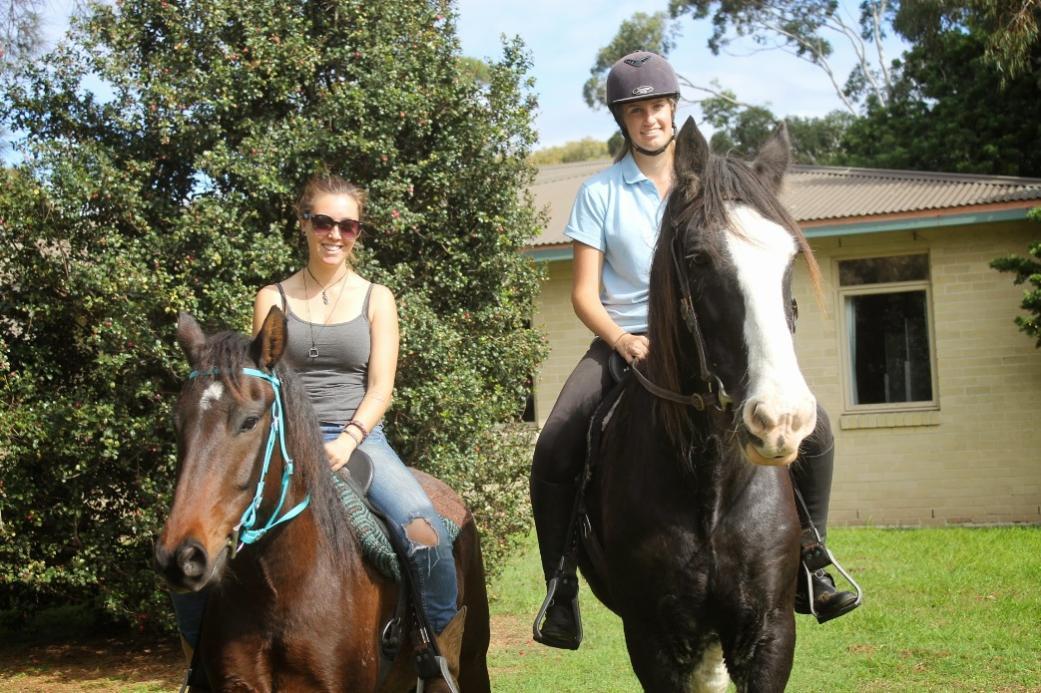

Oppenheimer the actor: the curious 1946 film Atomic Power featuring the scientist as himself
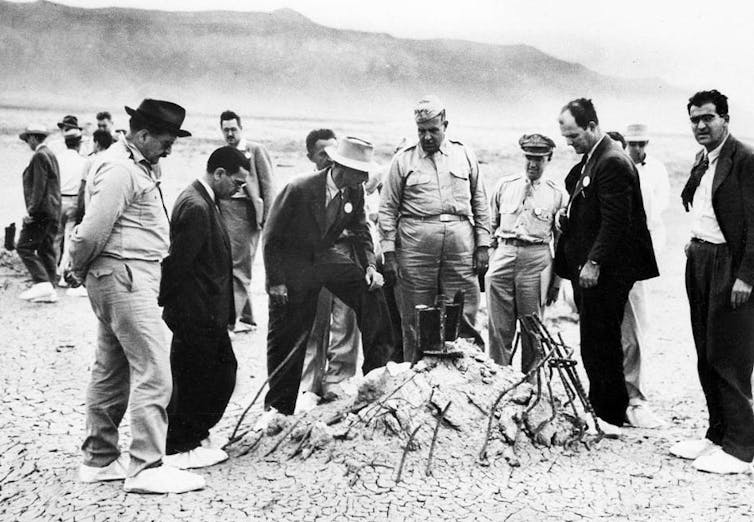
Atomic Power, a groundbreaking 18-minute black-and-white film about the Manhattan Project which created the world’s first atomic bomb, may not be as famous as Christopher Nolan’s 2023 epic, Oppenheimer. However, this largely overlooked 1946 cinematic experience was pioneering in communicating the history behind the nuclear detonation in the New Mexico desert on July 16 1945.
Particularly striking in Atomic Power is that leading figures play themselves, including Robert Oppenheimer, Leslie Groves and even Albert Einstein. This film, which offers a unique window on the dawn of the Atomic Age, resonates with its 2023 counterpart.
Atomic Power was released when only 44,000 US households had television, so millions saw it in cinemas. It was part of a major American newsreel series, The March of Time (1935-1951), created by Time magazine’s co-founder Henry Luce and produced by Louis de Rochemont.
These films were “a unique combination of newsreel and documentary formats”. They involved dramatised recreations and commentary on significant current events, and are regarded as having a profound impact on contemporary filmmaking. Even the narration by Cornelius Westbrook Van Voorhis – whose “voice epitomised 20th-century announcer speak” – was genre-defining.
However, telling this story comes with many problems. Both films struggle to juggle depicting genius and technological advance with the reality of nuclear power.
Nuclear Messages On Film
The message of 2023’s Oppenheimer blockbuster has been variously interpreted. Some critics have focused on how the atomic bomb represents a fundamental change in global technology its portrayal of Oppenheimer and other figures grappling with the moral dilemmas around this.
Other critics, however, have suggested the film “skirts around the human suffering caused by the bomb”. Oppenheimer’s grandson Charles summarised the film’s central question as: “Are we going to destroy ourselves as a species?” But in the same Time interview, he added that “the movie, while really good, had less emphasis than I would have put” on the crucial period of 1945 to 1947, during which Atomic Power was made.
That film’s poignant release date, August 9 1946, was exactly a year after the atomic bombing of Nagasaki in Japan. In contrast to 2023, the world did not yet have nuclear-armed rockets, nuclear-powered submarines, nor even commercial nuclear power stations.
At that time, the US was the only country with nuclear weapons – only 11 bombs in 1946, deliverable by propeller-driven B-29 bombers. And there were even US proposals being discussed at the UN for the (unsuccessful) Baruch Plan. Named after Bernard Baruch, the US representative to the UN’s Atomic Energy Commission, this plan sought to dismantle all US nuclear weapons and place atomic technology under international control.
The plan failed largely on account of the Soviet Union’s abstention and pursuit of a counter proposal. Russia believed the UN to be insufficiently independent, and that the plan would simply protect the US’s atomic monopoly.
These negotiations were not helped by the US’s Operation Crossroads nuclear tests in the Pacific during July 1946, nor by the Soviet Union engaging in its own secret atomic bomb programme.
Atomic Power’s message is similarly complicated. Having initially echoed concerns about the new technology, it ends up hoping for peace and responsible use while featuring news footage and a reference to the ill-fated Baruch Plan.
But the film largely focuses on communicating the technological triumph of creating an atomic bomb. It opens with images of buildings in a devastated Hiroshima, then cuts to a staged grocery store conversation with an unnamed American woman who is lamenting the loss of life. A similarly anonymous pastor offers a one-sentence morality injection:
It’s overstepped the bounds of moral law by producing this diabolical weapon.
While featuring such perspectives appears thought-provoking, these are in fact brushed aside almost immediately, replaced with scientific explanations and the project’s story. Potential dangers are revisited later, but purely through the hypothetical threats to US cities.
Surreal Moments

Oppenheimer is noted for its sometimes surreal and “artful” depictions. Atomic Power’s dramatisation, though seemingly more conventional, offers equally surreal takes.
Most striking is a scene involving Vannevar Bush and James B. Conant, who both played significant government oversight roles in the Manhattan Project. Real nuclear detonation footage is interspersed with the two “witnessing” the blast by lying on the desert sand – facing away, shielding their eyes when turning round, then casually shaking hands. There’s not even a breath of wind to ruffle their hair.
This unbelievably detached re-enactment was filmed in a Boston garage – and the scene reflects wider disparities between the reality and the cinematic recreation. Conant’s own account, written the day after the real event, conveyed a great sense of fear when facing the bomb.
Oddly, Atomic Power barely features Oppenheimer, who is reduced to a single scene with two lines. In a desert control room, just before detonation, he speaks with his close friend and Manhattan Project consultant, Isidor Isaac Rabi:
Oppenheimer: “The automatic control’s got it now. Rabi, this time the stakes are really high.”
Rabi: “It’s going to work alright Robert, and I’m sure we’ll never be sorry for it.”
Oppenheimer: “Well, in 40 seconds we’ll know.”
This subconscious hinting at Oppenheimer’s inner doubts, and of his being at the mercy of a mechanical process, foreshadow his later public challenging of US nuclear policy and being sidelined through “political machinations” – both powerful themes that are central to the 2023 biopic.
In contrast to Oppenheimer, Einstein is given greater accolades in Atomic Power – reified for his “genius” discoveries and letter to US president Franklin D. Roosevelt that made nuclear weapons possible. Yet his only words near the film’s end are “I agree,” which he says in response to a statement by the Emergency Committee of Atomic Scientists (of which Einstein was Chairman) appealing for support for funding to educate the public.
Even military figures have surprisingly limited profiles in the film. Groves’s only line, having led the project, is cautioning an unnamed scientist to be careful with a $50m plutonium test-tube. Ironically, this portrayal hints at the very real military-scientific tensions during and after the project.
Atomic Power’s final words are the catchphrase that the series was by then well-known for: “Time … marches on!” Indeed it did, yet we continue to be drawn to this complex and murky story and what it tells us about humanity. I’m sure Oppenheimer won’t be the last time filmmakers attempt to tell it.
Atomic Power can be watched for free through the BFI player

Looking for something good? Cut through the noise with a carefully curated selection of the latest releases, live events and exhibitions, straight to your inbox every fortnight, on Fridays. Sign up here.![]()
Timothy Noël Peacock, Lecturer in History, University of Glasgow
This article is republished from The Conversation under a Creative Commons license. Read the original article.
How swarming animals can help humans and AI make better decisions
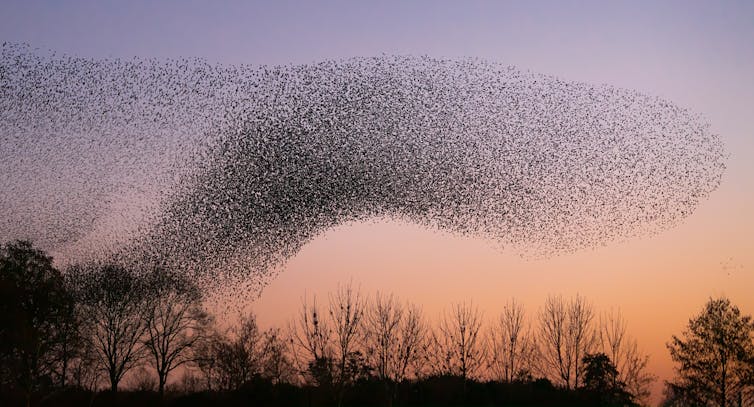
The word swarm often carries negative connotations – think biblical plagues of locusts or high streets full of last-minute shoppers during the Christmas rush. However, swarming is essential for the survival of many animal collectives. And now research into swarming has the potential to change things for humans too.
Bees swarm to make their search for new colonies more effective. Flocks of starlings use dazzling murmurations to evade and confuse predators. These are just two examples from nature but swarming can be seen in almost every corner of the animal kingdom.
Research from mathematicians, biologists and social scientists is helping us understand swarming and harness its power. It’s already being used for crowd control, traffic management and to understand the spread of infectious diseases. More recently, it’s starting to shape how we use data for healthcare, operate drones in military conflicts and has been used to beat near-insurmountable betting odds in sporting events.
A swarm is a system that is greater than the sum of its parts. Just as many neurons form a brain capable of thought, memory and emotion, groups of animals can act in unison to form a “super brain”, displaying highly complex behaviour not seen in individual animals.
Artificial life expert Craig Reynolds revolutionised the study of swarming in 1986 with the publication of the Boids model computer simulation. The Boids model breaks down swarming into a simple set of rules.
The Boids (bird-oids) in the simulation, like avatars or characters in a video game, are instructed to move in the same direction as their neighbours, move towards the average position of their neighbours, and avoid collisions with other boids.
Boids simulations are strikingly accurate when compared with real swarms.
The Boids model suggests that swarming does not need leaders to coordinate behaviour – like pedestrians in a town centre rather than a guided museum tour. The complex behaviour we see in swarms arises from interactions between individuals following the same simple rules in parallel. In the language of physics, this phenomenon is known as emergence.
The Hive Mind
In 2016, US technology company Unanimous AI used the power of swarm intelligence to win the Kentucky Derby “superfecta” bet, successfully predicting the first, second, third and fourth-placed riders in the famous US horse race.
Industry experts and conventional machine learning algorithms made swathes of incorrect predictions. However, amateur racing enthusiasts recruited by Unanimous AI pooled their knowledge to beat the 541/1 odds.
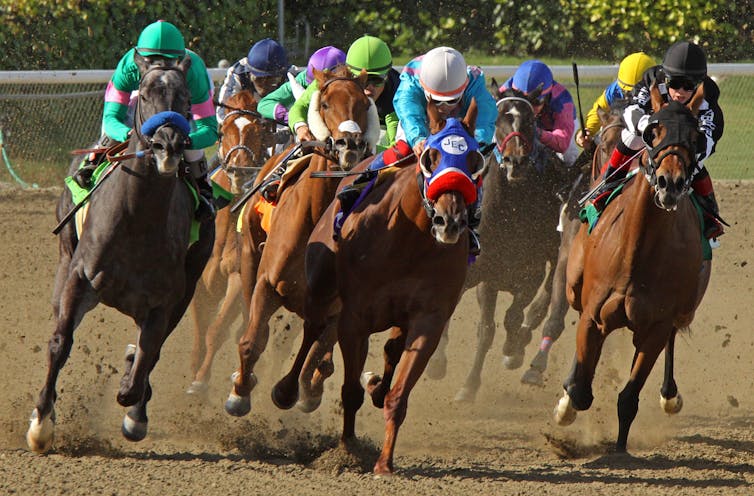
The volunteers’ success lay in the way in which their predictions were generated. Instead of voting on riders and aggregating their choices, the volunteers used Unanimous AI’s swarm intelligence platform to participate in a real-time digital tug of war, inspired by swarms of birds and bees.
All volunteers simultaneously pulled a dial towards their respective choices. This allowed people to change their preferences in response to the actions of others (for example, a person may have switched to pulling towards their second choice, B, rather than their first choice, C, if they saw A and B were the clear favourites).
Responding to one another in real time allowed Unanimous AI’s volunteers to collectively outperform highly-informed individuals.
What’s more, had the most frequent individual picks of the volunteers determined the ordering, only the 2016 winner and bookies’ favourite, Nyquist, would have been placed correctly.
Health Concerns
Similar swarming technologies are also of increasing interest in the healthcare sector, where talk of an AI revolution is prompting increasing concerns around patient privacy.
As the reliance on data-driven techniques in healthcare increases, so too does the demand for extensive patient datasets. One way to meet these demands is to pool information between institutions and in some cases, countries.
However, the transfer of patient data is often subject to stringent data protection regulations. A solution to this problem is to use only in-house data, though this often comes at the expense of diagnostic accuracy.
An alternative lies in swarming. Researchers believe swarm intelligence can preserve diagnostic accuracy without the need for raw data exchange between institutions.
Preliminary studies have shown decentralising data storage into a network of interacting nodes can give institutions the benefit of shared wisdom. This means there isn’t a central hub coordinating the flow of information, and institutions can’t access the private patient data of each other.
Centralised machine learning uses data uploaded to a shared hub where machine learning takes place using all available data. In decentralised systems, each institution separately stores its data in its own node. The machine learning happens locally at each node (using only in-house data), but the results of machine learning are shared between the network, to the benefit of all nodes. This process ensures that raw patient data is not exchanged between institutions, preserving patient privacy.

Swarms And Warfare
Drone technology is increasingly used in front-line combat, in recent times most notably by Ukrainian forces in the ongoing Russia-Ukraine conflict. However, as it stands, conventional drone technology requires one-to-one supervision.
Current defence research aims to facilitate communication between drones, allowing one controller to operate swarms of drones. The development of such technology promises to vastly improve the scalability, reconnaissance and striking capabilities of combat drones by allowing for continuous information relay within groups of drones.
As research delves deeper into swarming, we find a world where collective action creates complexity, adaptability, and efficiency. As technology evolves, the role of swarm intelligence is set to grow, intertwining our world with the fascinating dynamics of swarms.![]()
Samuel Johnson, DPhil Candidate in Mathematical Biology, University of Oxford
This article is republished from The Conversation under a Creative Commons license. Read the original article.
Meg 2: the truth about the extinct mega shark – and why even this ridiculous film could inspire future palaeontologists
Jack Cooper, Swansea UniversityOtodus megalodon, the biggest shark of all time, has long captured the imaginations of palaeontologists and the public alike. Scientific fascination spawns from the sheer enormity of their fossilised teeth. As big as human hands and serrated like kitchen knives, they were used for cutting down whales unlucky enough to encounter these sharks.
This gigantic predator has been further propelled into the limelight through popular culture. Nowhere has the megalodon made a bigger splash than its starring role in 2018’s The Meg, which will be followed by a sequel this year, Meg 2: The Trench.
Adapted from the bestselling novel Meg: A Novel of Deep Terror by Steve Alten, The Meg tells the story of a group of scientists discovering megalodon living in the Mariana Trench in the western Pacific Ocean.
The film is undeniably riddled with scientific inaccuracies. However, I can’t help but appreciate The Meg. A ridiculous film? Yes. But everyone involved seems very aware of this, making for highly entertaining viewing.
In my professional opinion, if a future palaeontologist becomes inspired and makes new megalodon discoveries because they saw this unserious film, then its existence has surely been a good thing.
I feel this way because it is ultimately my own story.
The very reason I discovered megalodon was because I watched a media depiction of it – specifically the BBC documentary series Sea Monsters (2003) in which zoologist Nigel Marven visits prehistoric seas in his time-travelling boat to dive with ancient beasts.
I was just six at the time. I am now, 20 years later, a practising palaeobiologist specialising in fossil sharks and my most well-known work revolves around none other than megalodon.
Megalodon Biology And Cinematic Representation
The Meg does take artistic licence with available scientific knowledge. For example, the sharks are portrayed at exaggerated sizes of 27 metres (88 feet). The most recent scientific extrapolations from tooth size, however, estimate a maximum size of 20 metres (65 feet) long, still making it one of the largest predators that have ever existed.
Some dismiss megalodon’s appeal as beginning and ending with its humongous size. Nothing could be further from the truth.
For starters, this shark was everywhere. Its fossil teeth occur in geological formations on six continents dating across 20 million years during the Miocene and Pliocene epochs (23 million years ago to around 3 million years ago).
Intriguingly, some of those formations were shallow habitats with lots of small megalodon teeth: telltale signs of nurseries where the babies were left to grow with plenty of food and protection from predators. One such site is Panama’s Gatun Formation, which is referenced in The Meg.
Unravelling megalodon’s predatory ecology from fossils is even more interesting.
Its enormous teeth have left behind nasty injuries on whales that fell victim to its massive bite force, including baleen whales and even sperm whales. Using 3D modelling around a 140-vertebrae spinal column, researchers have made stomach volume calculations that suggest megalodon could eat predators the size of today’s killer whales in just a few bites.
Recent chemical analyses from teeth have also produced compelling findings. Nitrogen isotope values from megalodon are exceptionally high, indicating it was higher up the food chain than any living marine predator. In short, the megalodon was the most apex of ocean predators.
Oxygen isotopes in fossils demonstrate higher body temperatures than the surrounding environment. This indicates mesothermy – an ability to maintain high body temperatures seen in only a few species such as great whites, mako sharks and basking sharks.
Mesothermy enhances swimming speeds, allowing a megalodon to travel faster and further, increasing its chances of finding prey. This active lifestyle would have forced megalodon to eat more food – around 98,000 kcal every day – to justify its size. As such, the loss of its coastal habitats and associated prey would have limited food intake and possibly starved it into extinction 3 million years ago.
The upcoming Meg 2 will feature a slightly different ecology. It is due to depict a megalodon devouring a Tyrannosaurus rex. The shark first evolved more than 40 million years after non-avian dinosaurs went extinct so, unfortunately, this clash of the iconic beasts would never have happened in reality. It is, however, a nod to Steve Alten’s original novel that also featured such a fantastical scene. And it should make for a very cool moment of cinematic absurdity.
A Better Story For Sharks
Notably, The Meg portrays megalodon as surviving into the present day. This is impossible because the fossil record shows the disappearance of the apex super-predator megalodon had a cascading effect on the ecosystem. It caused the spread of great white sharks, for example, and allowed whales to get even bigger because there were no more giant sharks to fear.
Unfortunately, media depictions like this can drive bizarre conspiracy theories that megalodons are somehow still alive. This is, of course, nonsense but isn’t necessarily the fault of The Meg. Fake documentaries using actors as scientists are far more guilty than a silly Hollywood movie.
Would I like to see films that accurately use all available science to depict such a remarkable shark? Of course. But entertainment is what it is.
Sharks continue to be portrayed negatively in the wider media, despite up to a third of today’s sharks being threatened with extinction.
So if Hollywood is going to continue portraying living megalodons, then I feel the most interesting aspect of this fictional scenario has yet to be properly explored: would we be far more dangerous to megalodons than they would be to us? I think the answer is a resounding “yes”.
We kill as many as 100 million sharks every year and the largest ones are at particular risk. This could be a powerful story to help explain the importance and vulnerability of today’s sharks to modern audiences, the same way The Meg brings attention to the biggest shark of all.

Looking for something good? Cut through the noise with a carefully curated selection of the latest releases, live events and exhibitions, straight to your inbox every fortnight, on Fridays. Sign up here.![]()
Jack Cooper, Doctoral researcher in Palaeobiology, Swansea University
This article is republished from The Conversation under a Creative Commons license. Read the original article.
We need more than a definition change to fix Australia’s culture of permanent ‘casual’ work

The surprising thing about the Albanese government’s announced reforms to “casual” employment is not that they’re happening. It’s that employer advocates are getting so excited about them, despite the small number of people they will affect and the small impact they will have.
That’s not to say the changes aren’t needed. Rather, true reform of the “casual” employment system, of which this is just a first but important step, has a lot further to go to resolve the “casual problem”.
What Is The ‘Casual Problem’?
This problem is that most “casual” workers aren’t really casual at all — as shown by analysis that I and colleague Robyn May did, using unpublished data from the Australian Bureau of Statistics (ABS).
The premise for hiring them is that the work is intermittent, short-term and unpredictable. But, as you can see from the chart, the last time the ABS collected these data, a majority of “casuals” worked regular hours.
Almost 60% of “casuals” had been in the job for more than a year. About 80% expected to still be there in a year’s time.
Only 6% of “casuals” (1.5% of employees) worked varying hours (or were on standby), had been with their employer for a short time, and expected to be there for a short time.
Even now, some “casuals” have been doing the same “casual” work for over 20 years.
Permanent ‘Casuals’
All this has led to a class of “permanent casuals” – a nonsense term. They should more accurately be called “permanently insecure”.
The one thing “casuals” have in common is they’re not entitled to sick leave or annual leave, and they are in a precarious employment situation. Their contract of employment only lasts till the end of their work day.
That means they have much less power than other workers. So little power, in fact, that barely half of them even get the casual loading they are meant to be paid in compensation for not receiving other entitlements.
On average, low-paid “casuals” get less pay than equivalent permanent workers, despite the loading.
Changing Legal Definitions
Not many “casuals” have been brave enough to challenge this exploitative relationship. But when they did a few years ago, Australia’s courts agreed permanent casual work was nonsensical.
To be a “casual worker”, there had to be no promise of ongoing employment. A court would judge this not just by what was in the formal contract of employment but also by what the employer actually did. If they kept hiring you, week after week, on a predictable roster, you weren’t casual.
In 2018, mine worker Paul Skene challenged his classification as a casual worker, arguing he had done pretty much the same work, with a few changes along the way, for five years.
The Federal Court agreed he wasn’t a casual employee and should be back-paid annual leave. Another mine worker, Robert Rossato, had a similar victory in 2020.
Employer organisations were “outraged” by the “billions” in back pay they could be forced to pay for having misclassified ongoing workers as casuals. They lobbied the Morrison government to amend the law, and challenged the rulings in the High Court.
The Morrison government changed the law in early 2021, to give primacy to the written contract, ignore employer behaviour, and protect employers from back-pay claims.
Later that year the High Court overturned the Federal Court decisions, ruling it was the written employment contract that mattered. If that was worded a certain way, you couldn’t test whether a worker was “casual” by whether the employer treated them that way afterwards.
Labor promised to overturn these interpretations, and that’s what this proposal does.
What Will The Legislation Change?
The details of the government’s plan is still not clear, but it is likely it will seek to amend the Fair Work Act to revert to something close to the pre-2020 definition of casual work, with a procedural twist.
It will again be possible to judge whether an employee is “casual” based on employer behaviour. And an employee who repeatedly works a similar roster can, after six months, demand “permanency” – meaning rights to sick leave, annual leave, and better protection against arbitrary sacking.
The twist: until they demanded “permanency” they won’t be entitled to any leave. So employers will be protected against claims for back pay.
Theoretically this could affect hundreds of thousands of “casual” workers. In reality, it will likely help far fewer.
Suppose you’re a “casual” labour hire worker in mining. You can tell what time you’ll start work on the first Friday next June. You go to your employer — the labour hire company — and say: “Make me permanent.” The labour hire company says: “We can’t. You might not have a job tomorrow.”
And indeed, now that you’ve asked, maybe you won’t have a job. So would you really ask?
It will depend critically on the protections offered to workers who ask to convert, and how credible they are to workers.
Most people only expect a few people to make the demand. Workplace relations minister Tony Burke says he believes only a “very small proportion” of “casuals” working regular shifts will do so.
Part of that reluctance will be fear of the consequences, and part of it will be that many casuals rely on their casual loading. About half of “casuals” are on the award minimum rate, compared with 15% of “permanent” full-time workers. Most cannot afford to “choose” to trade the money for holidays and other entitlements.
If you’re not getting the casual loading, you’ve got nothing to lose — except your job. If the power imbalance means you don’t get the loading, you won’t fancy your chances.
So, it will just work for a small number or workers – though it’s likely to be very important to them.
More Needs To Be Done
In short, this is a good step but more needs to be done.
In most other wealthy countries all workers – including temporary workers – are entitled to annual leave. That’s not the case in Australia, because of the “casual” ruse. These laws will not change that.
There should be universal leave entitlements. Sure, there needs to be a loading where work is unpredictable, and hence so short-term that leave entitlements would not be practical.
But everyone else should get annual and sick leave, and minimum award wages should be high enough that low-wage workers don’t have to rely on the casual loading to get by.
The challenge should be about how we transition to that situation.![]()
David Peetz, Laurie Carmichael Distinguished Research Fellow at the Centre for Future Work, and Professor Emeritus, Griffith Business School, Griffith University
This article is republished from The Conversation under a Creative Commons license. Read the original article.
Australia is about to set its first full employment target – and it will define people’s lives for decades

Stand by for one of the most important decisions Treasurer Jim Chalmers and the Albanese government will make.
That decision is to commit future governments and the Reserve Bank to full employment, and, more importantly, spell out what that means.
The Australian government hasn’t wholeheartedly and publicly committed itself to full employment since the 1945 Full Employment White Paper, released as the second world war was drawing to a close and Australia was gearing up for peace.
The definition Chalmers chooses – whether it specifies an unemployment rate of 3.5%, 4.5%, or the more ambitious target of 3% I would most like – could reverberate for as many decades as the white paper did in 1945.
Tuesday’s Reserve Bank decision not to increase interest rates further makes it more likely we could end up with a more ambitious target.
Australia’s Daunting Post-War Challenge
The 1945 white paper was prepared for Prime Minister John Curtin by a committee led by the head of post-war reconstruction HC “Nugget” Coombs.
In the 20 years leading up to the war, more than 10% of workforce had been out of work, climbing to 25% during the depression. The committee wanted the all-out mobilisation necessitated by war to be continued into the peace.
Their challenge was to find jobs for the 1 million defence staff who would be returning to civilian life.

Achieving that would require governments to actively stimulate private spending, through their own spending and through monetary and other policies “to the extent necessary to avoid unemployment and the consequent waste of resources”.
That was an idea accepted by both Labor and Coalition governments right through to the 1970s, where unemployment remained as low as 2%. It was also one Coombs himself adopted as the first head of the Reserve Bank of Australia from 1960.
But the employment target Coombs helped write in to the Reserve Bank Act was fuzzy: it simply committed the bank to “the maintenance of full employment in Australia”.
Finally Setting A Jobs Target
Fast forward to March 2023, when the treasurer was handed the review of the Reserve Bank, An RBA fit for the future.
That final report pointed out the bank’s target for inflation is specific – defined in a written agreement with the treasurer as “2-3% on average, over time”.
In contrast, the bank’s target for employment has no numbers attached – resulting in inflation getting prioritised.
While it is true that putting a number on a target doesn’t guarantee an outcome, the number put on the inflation target does seem to have helped bring it down.
The RBA review recommended the treasurer’s agreement with the bank be updated, requiring it to adopt an explicit target for “full employment”. That would most likely be expressed via a range of indicators, including the unemployment rate, the underemployment rate, and the tenure of employment.
Chalmers says he will update the agreement and issue the direction by the end of the year. Before then, next month he will make public his own target for full employment via his employment white paper, now being prepared by the treasury.
Moving Unofficial Targets Of The Past
The numbers that the treasurer and the Reserve Bank adopt will matter enormously. And it’s worth clarifying that the target can’t be an unemployment rate of zero.
There will always be some temporary unemployment as people move between jobs. That’s also the case when people leave industries that are no longer needed – such as thermal coal mining in the years ahead, as our energy mix changes – and go on to retrain for jobs in emerging industries.
For a while in the 1990s, the Reserve Bank acted as if full employment meant an unemployment rate of 7%. That was its estimate of the “non-accelerating inflation rate of unemployment” (also known as NAIRU), the rate needed to stop shortages of useful workers pushing up inflation.
In 2017, the bank cut that estimate to 5% and then 4.5% in 2019. Then, about a year after COVID hit, it appeared to cut it further when Governor Philip Lowe said in 2021 there was a chance Australia could achieve and sustain an unemployment rate in the “low fours”, although only time would tell.
The Lower Our Target, The More Secure We Will Be
The unemployment rate is now 3.5% – a near five-decade low.
If the government and the bank choose to adopt 3.5% as a target, it would put 150,000 more Australians into work than would a higher unambitious target of 4.5% – in perpetuity.
A lower target of 3% (not too far above the 2% Australia achieved from 1940 to 1974) would do much more than put people into jobs and better use our resources.
It would also help us adapt to change in the way we are going to need to.
Creating Confidence To Face Change
The 1945 white paper was on to this, at another time of massive transition when the wartime industries were dying and the peacetime industries emerging.
It said an assurance of full employment would
assure workers that the community has need of their services somewhere, and will restore the basic sense of security without which new risks will not readily be undertaken.
It’s a point echoed by Prime Minister Bob Hawke’s former economic advisor, Ross Garnaut, in an address to the Australian Conference of Economists last month.
He said unless there was confidence in high employment, every time an industry or employer was threatened with closure, there would be a cry of “jobs, jobs, jobs” as workers fought to protect what they had.
Garnaut told me it was a lesson he learned from Hawke when he signed on with the prime minister in 1983. Hawke agreed with him that the economy would have to change and some industries would have to die. But Hawke told him he wasn’t going to bring on those changes until unemployment was clearly coming down.
When people knew they could get another job, they would accept change.
Now, as in the 1940s and 1980s, we need that confidence. If Chalmers and the Reserve Bank adopt an ambitious target, they’ll create it and set us up for the challenges ahead.![]()
Peter Martin, Visiting Fellow, Crawford School of Public Policy, Australian National University
This article is republished from The Conversation under a Creative Commons license. Read the original article.
Australia has had school nurses for more than 100 years – but we don’t use them enough

Teachers are not always equipped to deal with the growing health needs of their students, from mental health challenges to complex medical needs.
Federal and state governments are currently looking at “key targets” as part of the next National School Reform Agreement, which starts in 2025.
A consultation paper, which looks at many aspects of teaching and learning, hones in on how to improve student mental health and wellbeing. It specifically asks:
What can be done to establish stronger partnerships between schools, local health networks and primary health networks?
Paying more attention to the role school nurses can play in school communities is a great place to start.
School Nurses Are Real Nurses
It’s a common misconception among students and staff that school nurses are not “real nurses”.
I come across this in my work with school nurses – people think nurses are only trained to work in hospitals, even though a large group specialise in working outside them.
School nurses are qualified and registered health professionals. School nursing is also one of the oldest nursing specialities. Australia has had school nurses for more than 100 years.
What Do They Do?
School nurses are located all over Australia, in urban, regional and remote areas. They can be employed by state or territories’ public health services or employed directly by their schools.
What nurses do varies from school to school. This can be confusing for education staff, parents and even school nurses themselves.
There are no hard-and-fast rules. The hours school nurses work and the work they do (even the job title they have) often depends on their employer.
Some school nurses primarily care for students with acute health issues such as illness or injury. They can also give prescribed medications for seizures, ADHD or diabetes, and help students with chronic or complex health needs such as a tracheostomy or gastrostomy, where students need help with their breathing or nutrition.
Beyond this, nurses can coordinate health care for boarding school students, or attend school camps and sporting events.

Health Promotion And Screening
Some school nurses focus on health promotion and early interventions.
This can includes screening for speech, vision or hearing problems.
It can also include working with teachers to deliver health education about topics such as vaping and respectful relationships.
Nurses As A Bridge Between Two Worlds
School nurses are the bridge between health and education: while well informed about the health system, they also have insight into how complex schools and classrooms can be.
School nurses can help young people be - and stay - at school. They can manage student health directly as well as working with complex student health needs to inform individual education plans and support inclusion.
School nurses can also be advocates for children, and help them beyond the school gates.
They can help young people experiencing family, sexual health, stress, or drug use problems and refer them to other services.
They can engage with and support families, helping them access community resources and navigate the health system.
A 2021 review of Australian and international studies of school nurses found they had significant impact in facilitating access to health care, chronic disease management, coordinating care and reducing absenteeism.
But nurses also facilitated early intervention, access to social care, and reduced emergency department visits and hospitalisations.
We Need More Information
Despite the many benefits, we don’t know exactly how many school nurses there are, or even how many students they provide care to as this information isn’t publicly available.
Some sources suggest there are approximately 1,500 school nurses in Australia but this is likely to be an underestimate.
The school nurses are also not equitably distributed. Some students have a full-time nurse at their school, some have a part-time nurse while other children don’t have access to a school nurse at all.
A recent workforce survey indicates many nurses working in community settings such as schools are underutilised and not being able to use all their skills on the job.
With the school reform agreement there is a major opportunity to improve health services to students by improving their access to school nurses.
In the meantime, if you’re lucky enough to have a school nurse, take the time to talk with them. You may be surprised what they can do for you. You can usually contact the nurse through the school office. ![]()
Anita Moyes, Lecturer, Edith Cowan University
This article is republished from The Conversation under a Creative Commons license. Read the original article.
Voyager 2 has lost track of Earth. Only one antenna in the world can help it ‘phone home’

In 1977, five years before ET asked to “phone home”, two robotic spacecraft began their own journey into space.
Almost 46 years later, after exploring the Solar System and beyond, one of those spacecraft – Voyager 2 – has lost contact with Earth.
All communication with Voyager 2 goes through NASA’s Deep Space Station 43, a 70-metre radio dish at the Canberra Deep Space Communication Complex operated by CSIRO.
Contact was lost more than a week ago. After intense efforts at NASA and here in Canberra, we have detected a faint “heartbeat” signal from the craft – and we’re confident of re-establishing full contact.
Through The Solar System And Beyond
NASA’s twin Voyager spacecraft – Voyager 1 and Voyager 2 – were designed to complete a “grand tour” of the Solar System, visiting the giant planets Jupiter, Saturn, Uranus and Neptune.
Throughout the billions of kilometres of their journeys, the Voyagers stayed in touch with Earth through the three antennas of the Deep Space Network. One is in Madrid, Spain; a second in Goldstone, California; and the third in Canberra.
Having completed their tasks in 1989, both Voyager 1 and 2 have long since left our Solar System behind. They are now exploring interstellar space – the space between the stars.
Voyager 1 is currently 24 billion kilometres from home, with Voyager 2 not far behind at 20 billion kilometres.
Whispers From Space
On July 21, a series of planned commands sent to Voyager 2 inadvertently caused the spacecraft’s antenna to point two degrees away from Earth. As a result, the spacecraft is currently unable to receive commands or transmit any data back to Earth.
Mishaps like this are not uncommon in space exploration. The NASA team is expert at problem solving, and has a good track record of keeping spacecraft flying long after their prime mission has ended.
NASA’s science and engineering teams have dealt with communication drop-outs before, with both Voyagers. Their efforts have already quadrupled the planned 12-year life of the craft, so they don’t think we’ve heard the last from Voyager 2.
It’s an enormous achievement that we still have contact with these spacecraft at all, given their enormous distance from Earth and the relative weakness of the signal received through the big antenna dishes in Canberra. Even when Voyager 2 is pointing at Earth, its signal is already a whisper from space, billions of times weaker than the power generated by a tiny watch battery.
A Heartbeat 20 Billion Kilometres From Home
The last time Voyager 2 was out of contact was in March 2020, when the dish at the Canberra Deep Space Communication Complex was shut down for a scheduled 11-month upgrade project. Ahead of the shutdown, commands were sent to Voyager 2 to program the spacecraft to maintain operations without needing to hear from Earth for an extended period.
Canberra’s Deep Space Station 43 is the only antenna in the world that can communicate directly with both Voyagers. Its sister stations in the northern hemisphere are unable to “see” Voyager 2, because Earth is in the way.
Since Voyager 2’s antenna was tweaked off target, we have been using Deep Space Station 43 to listen intently for any signal. Eventually this effort paid off, with the detection of the craft’s carrier tone – a “heartbeat” indicating Voyager 2 is still transmitting.
Now attempts will be made to relay commands to Voyager 2 and tell it to re-orient its antenna towards Earth.
If those attempts fail, Voyager 2 is already programmed to use the Sun and the bright star Canopus to re-orient itself several times each year. The next scheduled reset will occur on October 15, which should automatically enable communications to resume.
Into Interstellar Space
The Canberra team feels a very close connection to this distant traveller. We have been with it on every step of its journey so far, and plan to continue to provide mission support for however long the mission lasts.
Voyager 2 was launched on August 20 1977 and reached Jupiter in July 1979, a few months after Voyager 1. It proceeded to Saturn for a flyby of the ringed planet in 1981, and then had encounters with Uranus in 1986 and Neptune in August 1989, ending the so-called “grand tour”.
As both spacecraft were in good health, they were given an extended mission to reach the edge of our Solar System, where the influence of the Sun’s energy ends. The Voyagers are now in the “clear air” of interstellar space and can, for the first time, make direct measurements of this environment.
The data they have returned are changing our understanding of the Universe. The teams at NASA and here in Canberra are confident there is more science and discoveries to come, when Voyager 2 once again phones home.![]()
Glen Nagle, Outreach Manager, Canberra Deep Space Communication Complex, CSIRO
This article is republished from The Conversation under a Creative Commons license. Read the original article.
Ned Kelly’s descendants claim cultural heritage rights over the site of his last stand. The Supreme Court disagrees

The Victorian Supreme Court has determined the descendants of Ned Kelly’s family are not a distinctive cultural group with the right to protections of their “intangible cultural heritage”.
The Kelly clan’s bid for recognition was provoked by a proposed tourist development at Glenrowan, the site of the outlaw’s last stand in 1880. The new centre will look at the story of the Kelly gang in the context of Glenrowan’s broader history.
Kelly’s grand-niece, Joanne Griffiths, argues the new structure and landscaping will “disrespect” her family’s “human rights” as cultural “custodians”.
Justice Melinda Richards found Griffiths and the family could not prove practices that would distinguish them as a cultural group. The redevelopment continues as proposed.
Griffiths has claimed the court’s decision is a continuation of the “persecution” meted out to the Kelly family:
If we were Indigenous this wouldn’t be happening.
The case raises fascinating questions about the definition and evidence of White cultural heritage in Australia – and the way we treat sites of colonial history.
What Is White Cultural History?
Glenrowan is tucked inside the south-eastern boundary of Yorta Yorta Country, where the Ovens River floodplains meet the rising foothills of the Victorian Alps.
In 1998, the Yorta Yorta were denied native title because, according to Justice Howard Olney, “the tide of history has undoubtedly washed away any traditional rights” to their lands and waters.
The Kelly descendants made no claim to native title. But by invoking their cultural heritage they tasked themselves with the same burden of proof required of First Nations people in fighting for land rights.
The Kelly descendants were not claiming the site as one of public significance. They were instead claiming a familial connection.
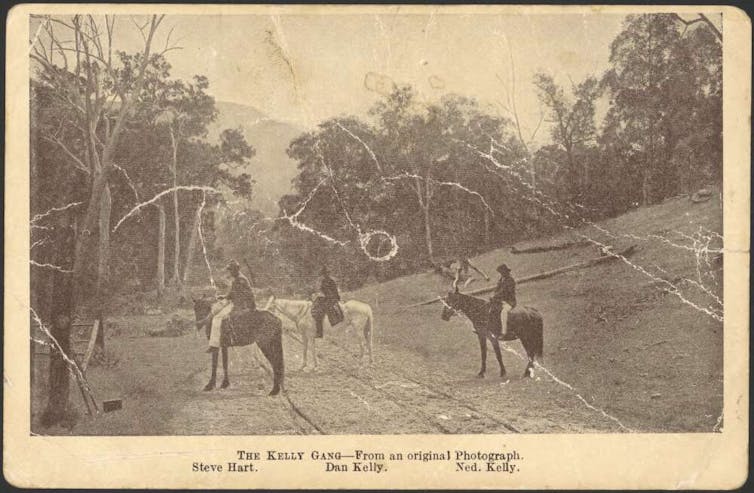
There is no doubt Ned Kelly’s descendants share a unique emotional relationship with Glenrowan. That needs no justification or proof.
Many non-Indigenous people like myself feel close to certain places in Australia.
Historian James E Young coined the term “collected memory” rather than “collective memory”.
“A society’s memory,” he says, “might be regarded as an aggregate collection of its members’ many, often competing memories.”
Several Australian authors have explored this collected memory. Luke Stegemann’s Amnesia Road investigates the entanglement of Stegemann’s life and work in the colonial histories of Queensland and Andalusia. Dean Ashenden’s Telling Tennant’s Story examines how the place of his upbringing embodies the impacts of settler colonial legislation.
Collected memory is also enacted in memorials – the statue of politician William Crowther in nipaluna/Hobart is being removed so only the plinth will remain, with signage explaining his contentious history – and in public rituals like Survival Day Dawn Services.
As well as lacking recognition of the Yorta Yorta struggle, the Kelly family’s bid overlooks the ongoing critique by historians like David Dufty of Ned Kelly’s story as a tale of “persecution”.
Anti-Irish racism notwithstanding, Dufty highlights Kelly’s ruthless violence, use of terror in taking hostages and incoherent politics.

By asking what is distinctive about the Kelly descendants’ right to cultural protections, we are echoing a question posed by Gunditjmara artist Paola Balla:
Tell me what it means to be a white person […] beyond a notion of racial superiority.
White cultural heritage in Australia is made of many memories and histories that intersect with one another, with settlers of colour and with First Nations people.
How We Commemorate Colonial History
Cases like these raise interesting questions about how we identify – and memorialise – shared heritage.
If the Kelly family took a more nuanced position, they could have opened a public conversation about how we commemorate colonial history, the nuances of historical Irish-Blak solidarities, and a deeper sense of White allyship to First Nations people’s human rights.
With its Big Ned, bark hut museum and janky animatronic diorama, Glenrowan is currently a prime example of what writer and artist Melody Paloma defines as “settler kitsch”.
In Australia, the development of monuments to colonial history continues to be a work in progress.
The proposed development is a chance for a more complex presentation of colonial heritage. The Sovereign Hill living museum is working to illuminate the culturally diverse stories of Ballarat. The Tasmanian Museum and Art Gallery has also sought to face its past by recentering its public program and exhibition spaces around First Nations and particularly Palawa art and culture.
Photographer Jon Rhodes has spent decades documenting the curious histories of municipal and community treatment of sites of First Nations’ cultural heritage, and colonial violence.
An outlier, the Myall Creek Massacre Memorial offers a deeply affective model of how such sites of shared cultural heritage can be rebuilt and maintained by White and Blak communities together.
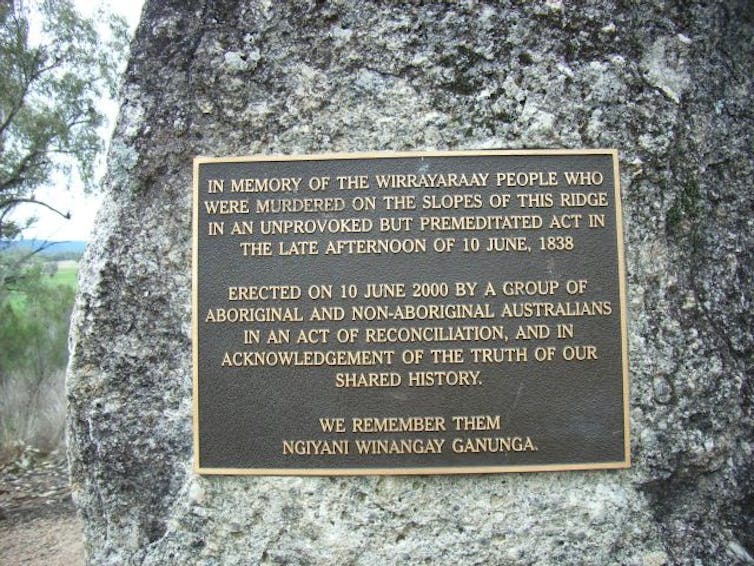
Perhaps Glenrowan will come to be understood as one such place: always Yorta Yorta; for a moment a place of complicated anti-colonial, White-on-White rebellion; later, a carnival of settler kitsch; and eventually, maybe, a thoughtful site of ongoing history-telling, embedded in Country.
Developments like the one coming to Glenrowan could create tangible answers to the question of what an inclusive and informed experience of White cultural heritage might look like.![]()
Bonny Cassidy, Senior Lecturer in Creative Writing, RMIT University
This article is republished from The Conversation under a Creative Commons license. Read the original article.
In Restless Dolly Maunder, Kate Grenville recreates the enterprising life of an obscure historical figure

Dolly Maunder, born in 1881, is the sixth of seven children of a sheep-farming family outside Tamworth in northern New South Wales. Their lives are a relentless round of hard work, indoors and out, relieved only a by few brief years at the local one-teacher school.
Dolly thrives there – “you’re a quick study”, approves the teacher. She also takes note of Miss Murray, the teacher’s daughter, who runs her own school in a nearby village: “the only woman Dolly knew who wasn’t just at home all day, banging the stove door open and closed, heaving the wet sheets around on washday, milking the cow, and always a baby wailing from the crib in the corner”.
Dolly determines that she will escape the farm, become a teacher, and earn her own way. But her father has different ideas. “Over my dead body!” is his response when she asks his permission to sit the necessary exam: “no daughter of mine goes out to work.”
So Dolly must resign herself to years of labouring in the kitchen, the wash house and the dairy with her mother and sisters, while checking out the local talent with a view to the inevitable marriage, “those iron rails”.
But the men in whom she is interested have their own commitments, and Dolly’s desires are thwarted by barriers of class and religion. She must make do and marry Bert Russell, one of her father’s employees and her mother’s choice – a simple, good-looking, hardworking man, who is quietly intent on leaving behind the small-town shame of coming from a disreputable family.
And so a pattern is set – of frustrated attempts to shape and expand her own life, and making do with what she can get.
Review: Restless Dolly Maunder – Kate Grenville (Text Publishing)
Restless Dolly Maunder extends Kate Grenville’s longstanding fascination with the lives of obscure historical figures, most of them women. Across her career, she has been driven to imagine their lives in all their possibilities, in books ranging from her bicentennial tour de force Joan Makes History (1988), to the controversial The Secret River (2005), to her recent historical project on Elizabeth Macarthur, consisting of the novel A Room Made of Leaves (2020) and an edited collection of Macarthur’s letters.

The life of Dolly Maunder is depicted as one of persistent struggle in the face of adversity. Her disappointment sharpens to fury early in her marriage after the birth of her first son, when she discovers Bert has fathered a child with a girl who worked in her mother’s house, and that her mother connived to cover it up and marry Dolly off to him anyway.
She feels humiliated, and drives Bert away – but then realises there is no way she can manage alone.
They resume married life, two more children are born – a daughter and a son – but Dolly resolves to cut ties with her parents altogether. She will not be beholden to her father for land to farm, so she persuades Bert to move to Sydney, where they will run a shop in the outer suburbs.
A new pattern emerges, which will dominate their lives for the next 20 years: “restless” Dolly Maunder moves the family from one business venture to another – a shop, a boarding house, then a number of pubs, most of them in country towns.
She thrives on her capacity to organise, to make a dream happen, yet each time they reach a point of stability, there is some fly in the ointment that drives her to move on elsewhere. Protests from the children or Bert are brushed off – they will move on when she says so, and the children will go as unwilling boarders to private schools.

There is more of her father in Dolly than she would like to admit. “Over my dead body,” she declares, opposing daughter Nance’s desire to become a teacher (because she would have to resign on marriage). Nance is to leave home and study pharmacy in Sydney instead.
The family’s upward progress is halted by the onset of the Great Depression. In 1929, Dolly and Bert have, for the first time in their lives, borrowed money to take on the luxurious Caledonia Hotel in Tamworth. Now they must sell at a loss and move to a bleak farm near Mittagong.
The family returns to farming, in a series of hardscrabble ventures – with their sons until the outbreak of World War II, and then Bert carrying on alone. When the boys enlist, Dolly is plunged yet again into that familiar state of “rage and regret and helplessness” that has punctuated her life. Leaving Bert to his own devices, she moves around alone now, in and out of a series of wartime jobs, helping Nance, on and off, to juggle her new family and pharmacy business.
Dolly is at last a free agent, of sorts. But with the end of the war comes the news that Frank, her eldest, has died in a Japanese prisoner of war camp. She is filled with bitter regret that she nagged him to join up in the first place.
Ten years later she finally comes to rest, in an apartment at the side of Nance’s family home. Looking back on her life, she reflects that previous generations of women, like her mother, had been “locked into a place where they couldn’t move”:
My generation was the hinge, she thought. The door had been shut tight, and when it started to swing open, my generation was the hinge that it had to be forced around on, one surface grinding over another. No wonder it was painful.
Her little granddaughter, by contrast, is growing up in a world where she is not required to pretend, but can tell the truth about her feelings.
A Hinge Generation
That child was Kate Grenville. Dolly Maunder was her maternal grandmother, whose life story she has imagined here, reconstructing it from a mix of memories, family stories and a few photographs.
Grenville’s most potent memory, the one that suggests where the impulse to write this story came from, is of her five-year-old self, interrupted at her play in the garden by cranky old grandma asking, “Do you love me, Cathy?”
What kind of question was this? Her answer was, simply, “No”.
For years, Grenville told this story as a joke, but now, she writes, “I see the memory differently”. This unlovable old woman
longed to be loved and was unsure enough to have to ask. She was looking back over her life and – as surely we all do – feeling the pain of regret.
The author, now in her seventies, looks back with regret herself: “I wish I’d thought of a kinder answer.”

Yet the perception Grenville attributes to Dolly – that her granddaughter “had been taught that it was all right to say the truth” – shows why there was no kinder answer available. “Kindness” is beside the point as far as the storyteller, the truth-teller, is concerned. Restless Dolly Maunder is a grim tale in many ways, a book as plain and harsh as Dolly herself.
She is no feminist heroine, despite her resilience. Her restlessness is driven by “rage, regret and helplessness – the poisons that tainted her life”. And while this enables her to survive and even thrive in a harsh world, it exacts a cost from her family as well as herself.
Dolly is a harsh woman, and her treatment of her daughter – Grenville’s mother – is combative from the beginning. Indeed, the successive generations of women evoked here are marked not only by the “locked doors”, the patriarchal restrictions imposed upon them, but by the restraints they believe they must of necessity place upon themselves and their daughters.
These were my reflections on reading the story of an exact contemporary of my own grandmother – a woman who resembled Dolly in some ways. She too was unhappy and aloof, formed by a harsh life, though she never spoke of her desires or ambitions thwarted the way Dolly does. Nor did she strike out on her own, or take risks like Dolly, preferring to blame her husband – my grandfather – for emigrating to Australia, taking her away from her people.
But it is intriguing to think of her as part of a “hinge” generation of settler Australian women, living through changes that had more to do with class mobility than feminist advances.
Restless Dolly Maunder is not a reflective, analytical, book. As it follows the constant movement of Dolly’s life, it stays close to her consciousness. The narrative does not stop to dwell on people or places. Dolly’s relationship to others is mostly instrumental, and she is devoid of the kind of curiosity about them that would drive her granddaughter to become a novelist of such range and distinction.
Nor does Grenville allow herself flights of language and imagination; she stays within Dolly’s boundaries. Metaphors are all the more powerful for their rarity, for example when Dolly hears herself “sliding the pointed tip of sharp remarks” at Frank, reproaching him to disguise her deeper fear for the younger son, who has already joined the army.
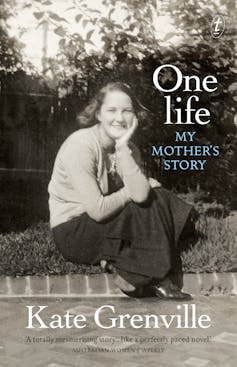
Only at the end of the book does Grenville hint at the complex of feelings that may have driven her own interest, as a novelist, in this subject, this story.
Family memoir and reimagined history dovetail beautifully in Restless Dolly Maunder. In some ways, the book is a continuation of One Life: My Mother’s Story, which Grenville published in 2015. Both narratives are told in the intimate third person, though One Life is more expansive – in the sense that the author attributes to her mother a rich range of desires and experiences, but also in the sense that the book is suffused with love and admiration, rather than regret.
In One Life, Grenville tells of having drawn upon diaries and many fragments of memoir left by Nance, as well as on her own lifetime of memories. Dolly Maunder’s story is representative of a more remote generation: “those mostly silent, unrecorded women”, who represent “where we come from”, but about whose lives we know so little.![]()
Susan Sheridan, Emeritus Professor, Flinders University
This article is republished from The Conversation under a Creative Commons license. Read the original article.
Book Of The Month - August + September 2023: Australia Circumnavigated : The Voyage Of Matthew Flinders In HMS Investigator, 1801-1803
by Flinders, Matthew, 1774-1814, author of Volumes I and II
As this is actually two books it will stay up for the first month of Spring 2023 too - enjoy!
This two-volume work provides the first edited publication of Matthew Flinders' journals from the circumnavigation of Australia in 1801-1803 in HMS Investigator, and of the ’Memoir’ he wrote to accompany his journals and charts. These are among the most important primary texts in Australian maritime history and European voyaging in the Pacific. Flinders was the first explorer to circumnavigate Australia. He was also largely responsible for giving Australia its name.
His voyage was supported by the Admiralty, the Navy Board, the East India Company and the patronage of Sir Joseph Banks, President of the Royal Society. Banks ensured that the Investigator expedition included scientific gentlemen to document Australia’s flora, fauna, geology and landscape features. The botanist Robert Brown, botanical painter Ferdinand Bauer, landscape artist William Westall, Pittwater and Broken Bay indigenous man Bungaree and the gardener Peter Good were all members of the voyage.
On this long voyage Bungaree used his knowledge of Aboriginal protocol to negotiate peaceful meetings with local Indigenous people.
Years later, in A Voyage to Terra Australis (1814), Flinders wrote that Bungaree's "good disposition and open and manly conduct had attracted my esteem". Flinders described the affectionate relationship between Bungaree and the cat Trim who sailed on Flinder’s ships: ‘If he [Trim] had occasion to drink, he mewed to Bongaree and leapt up onto the water cask; if to eat he called him down below and went straight to his kid, where there was generally a remnant of a black swan. In short, Bongaree was his great resource, and his kindness was repaid with caresses.’
After landfall at Cape Leeuwin, Flinders sailed anti-clockwise round the whole continent, returning to Port Jackson when the ship became unseaworthy.
After a series of misfortunes, including a shipwreck and a long detention at the Ile de France (now Mauritius), Flinders returned to England in 1810. He devoted the last four years of his life to preparing A Voyage to Terra Australis, published in two volumes, and an atlas. Flinders died on 19 July 1814 at the age of forty. The journals, edited, comprise a daily log with full nautical information and ’remarks’ on the coastal landscape, the achievements of previous navigators in Australian waters, encounters with Aborigines and Macassan trepangers, naval routines, scientific findings, and Flinders' surveying and charting. The journals also include instructions for the voyage and some additional correspondence. The ’Memoir’ explains Flinders’ methodology in compiling his journals and charts and the purpose and content of his surveys.
A Few Extras From The Pages Of The Past
SHIP NEWS.
On Thursday arrived His Majesty's Ship INVESTIGATOR, Captain MATTHEW FLINDERS; she sailed from hence in July last, to continue the survey of the coasts of New Holland. After being entangled among the reefs, and having grounded, owing to Capt. Flinders's anxiety not to leave any material part unexamined: He surveyed the East coast, as far as Cape Palmerston, and found two harbours, which the distance that Capt. Cook passed along that part did not allow him to observe.
The Investigator afterwards found a practicable and expeditious passage through the Strait between New Holland and New Guinea (for an account of which see the preceding Column); and then surveyed the Gulph of Carpentaria very minutely, finding many Islands and good harbours there. The decayed state of the ship obliged the Commander to return to this Port sooner than he otherwise intended; and after an unsuccessful search for the Trial Rocks, he passed on the South side of King's Island, through Bass's Straits, on the 1st instant.
The Officers and Ship's Company have generally been very healthy, until a short time before their arrival, when getting into cold weather, after being so many months in the Torrid Zone, they were generally attacked with a Dysentery, which we are sorry to say carried off Mr. Charles Douglass, Boatswain, a very good Officer; Serjeant James Greenhugh of the Royal Marine Forces, a very valuable Non-Commissioned Officer; W. Hilner and John Draper, Quartermasters; and C. Smith, a seaman; the loss of whom is much lamented by Capt. Flinders. Twelve sick seamen were landed on her arrival, of whose recovery there is every hope.
Capt. Flinders having thus far ascertained the existence of a safe passage for Ships through Torris' Straits, (which he performed in three days), will greatly facilitate and shorten the intercourse between this Colony and our Possessions in India: He is very particular in his cautions respecting the war-like disposition of the inhabitants of the Islands lying in these Straits, which will require vessels going this passage, to be in some measure armed and prepared for any hostile attacks.
We are sorry to add, that the future advantages expected from Capt. Flinders's Perseverance and Activity in his pursuits, are likely to suffer a delay, owing to the state of the Investigator's hull, which will be surveyed as soon as possible. His Excellency having given Captain Flinders Permission to take Eleven Seamen, Prisoners, on a Provisional Emancipation, we are happy to state, from Captain Flinders's authority, that their conduct has given him and his Officers great satisfaction; especially that of Francis Smith, who received a Free Pardon on the ship's anchoring in the Cove.
At day-light yesterday morning sailed His Majesty's armed Tender Lady Nelson, Lieut. Courtoys Commander, for Risdon Cove, Van Diemen's Land. On board that Vessel were embarked, John Bowen, Esq. appointed to command and superintend the settlement in-tended to be formed at that place; also, Mr. Jacob Mountgarrett, appointed Surgeon, with Three Privates, Ten Male, and Six Female Prisoners. The Porpoise was also to sail on the same service, with the remainder of the Soldiers, Settlers, Prison-ers, Provisions, and Stores; but the decayed state of the Investigator requires the Commander of the Porpoise being on the survey of that ship, which, when completed, the Porpoise will sail for the above destination.
SHIP NEWS. (1803, June 12 - Sunday). The Sydney Gazette and New South Wales Advertiser (NSW : 1803 - 1842), p. 4. Retrieved from http://nla.gov.au/nla.news-article625626

HM Sloop Investigator: etching by Geoffrey Ingleton, 1937, courtesy State Library of New South Wales
COPY of a LETTER FROM MATTHEW FLINDERS, ESQ
COMMANDER OF HIS MAJESTY'S SLOOP INVESTIGATOR, TO HIS EXCELLENCY THE GOVERNOR.
" H. M. S. INVESTIGATOR,
June 10, 1803.
" SIR,
"Judging that it may be very useful to Ships bound to India from this Port to know that the TORRES' STRAIT is both practicable, and may be expeditiously made, I have to inform Your EXCELLENCY, that in His Majesty's Sloop under my Command I safely passed from the South Sea to the Indian Ocean by it in Three days, lying at anchor each night, in Tolerable safety. It is not in my power at present to furnish Your Excellency with a Survey, or with so much Information concerning this important Passage as I hope hereafter to do; but judging that such Information as we have collected may be of some immediate advantage, I inclose the heads of it under the form of Directions to a Vessel wishing to try the Passage and I have the honour to be
"Your Excellency's most obedient Servant,
" MATTHEW FLINDERS."
HIS EXCELLENCY GOVERNOR KING, &c. &c,
SOME DIRECTIONS FOR SAILING THROUGH TORRES' STRAITS.
Small reefs having been seen and many others probably lying some distance to the eastward of the Strait, it is necessary to run cautiously from the eastward for a day or two, before making the body of the reefs. Enter them by a Passage in latitude 9° 18' South, and longitude 145° 6' East; and which, according to the Pandora's Chart, is 3 leagues wide. Steer for Murray's Island, which lies in 9° 53' South, and 144° 18' East, and may be seen at from 6 to 10 leagues distance ; but as there is a Reef to the East-ward of the Island, it will be necessary to go round this. The Investigator passed to the North side, approaching the island from the North-East ; but it would be more direct to pass on the south side of the Reef, should it be equally free from danger. Pass on the North side of Murray's Island, and steer as straight for the North-eastern most of the Prince of Wales Islands in 10° 31' South, as the Reefs will allow ; a ship will, however, be obliged to run four or five leagues on a more Westerly course before this can be done, sometimes over strong ripplings of tide, and through Passages of not more than a mile in width. We were at first very cautious of these ripplings, but afterwards paid them little attention when the water was not dis-coloured. On making the Prince of Wales Islands, pass close to their North ends in 10° 31' leaving a Reef which is dry at low water, on the starboard hand ; Booby Isle, which is low and white will then be seen to the W. S. W. ; and except the two Reefs in Captain Cook's Chart, lying to the North-westward, I know of nothing afterwards to prevent a ship from steering directly towards Timor.
During the passage through the Strait, a trusty Officer at the mast-head should direct the ship's course ; the lead should be kept going, and in the first part of the passage a boat should go ahead with sounding signals, the ship following at an easy rate. At least two hours before dark, look out for an Island or Reef, under the lee of which the ship may be each night at anchor ; Murray's Island will usually be one of these, but it is necessary to be guarded against the Natives who appear to be numerous and warlike.
With these precautions I judge that a ship will pass from the South Sea, through Torres' Strait in Two, Three, or Four days, any time between the first of April and the end of October ; and it is likely she might pass the contrary way in as short a time, from the middle of November to the end February; but for this I know of precedent.
MATTHEW FLINDERS.
H.M.S. INVESTIGATOR,
JUNE 10, 1803.
SOME DIRECTIONS FOR SAILING THROUGH TORRES' STRAITS. (1803, June 12). The Sydney Gazette and New South Wales Advertiser (NSW : 1803 - 1842), p. 4. Retrieved from http://nla.gov.au/nla.news-article625625
On Wednesday last His Majesty's Ship Porpoise hauled along-side the Investigator at the New Moorings, when Mr. SCOTT was Superseded at his own Request in the Command of the Porpoise; and Lieut. FOWLER, of the Investigator, was appointed to command her. Captain MATTHEW FLINDERS put the Investigator out of Commission, by discharging most of that Ship's Crew into the Porpoise, for whom room was made by the greater part of the Porpoise's People being Discharged the Service at their own Request ; Seventeen of whom immediately shipped on board the Bridgewater ; and Five of those who come from England in the Porpoise were allowed to become Settlers, on the same Conditions as the Reduced Soldiers of the New South Wales Corps.
The Porpoise is now Fitting for her Voyage to England, and will probably sail about the 5th of next Month.
Dr. BROWN, Naturalist; Mr. BAUER, Natural History Painter; and Mr. ALLEN, Miner to the Voyage of Discovery the Investigator was employed on, remain in the Colony, until it is determined whether another Ship is sent to complete the Object of the Investigator's Voyage. SYDNEY. (1803, July 24). The Sydney Gazette and New South Wales Advertiser (NSW : 1803 - 1842), p. 2. Retrieved from http://nla.gov.au/nla.news-article625689
POSTSCRIPT.
CAPTAIN FLINDERS, late Commander of His Majesty's Sloop Investigator, and Mr. PARK, Commander of the Ship Cato, arrived at Government House at half past 3 in the Afternoon of the 8th Instant, with the following disgreeable Intelligence, as communicated in the following LETTER to His EXCELLENCY.
Sydney, New South Wales,
Sept. 9, 1803.
"SIR,
"I have to inform you of my arrival here yesterday, in a Six-oar'd Cutter belonging to His Majesty's Armed Vessel PORPOISE, commanded by Lieut. FOWLER; which Ship, I am sorry to state to Your Excellency, I left on shore upon a Coral Reef, without any prospect of her being saved, in Latitude 22° 11' South, and Longitude 155° 13' East, being 196 miles to the N. 38° E. from Sandy Cape, and 729 miles from this Port : The Ship CATO, which was in Company, is entirely lost upon the same Reef, and broken to pieces without any thing having been saved from her ; but the crew, with the exception of Three, are with the Whole of the Officers, Crew, and Passengers of the Porpoise, upon a small Sand bank near the Wrecks, with sufficient Provisions and Water saved from the Porpoise to subsist the whole, amounting to 80 Men, for Three Months.
"Accompanied by the Commander of the Cato, Mr. JOHN PARK, and Twelve Men, I left Wreck Reef in the Cutter with Three Weeks' Provisions, on Friday, August 26th, in the morning, and on the 28th in the evening made the Land near Indian Head ; from whence I kept the coast on board to this place.
I cannot state the Extent of Wreck Reef to the Eastward, but a Bank is visible in that direction six or seven miles from the Wrecks. In a West direction we rowed along the Reef twelve miles, but saw no other dangers in the Passage towards Sandy Cape.---There are several Passages through the Reef, and Anchorage in from 15 to 22 fathoms upon a sandy bottom, the Flag-staff upon Wreck-reef Bank bearing South-East to South-South-West, distant from three quarters to one-and-quarter mile.
"After the above Statement it is unnecessary for me to make Application to Your Excellency to furnish me with the means of Relieving the Crews of the two Ships from the precarious situation in which they are placed, since your Humanity and former un-remitting Attention to the Investigator and Porpoise are Sureties that the earliest and most effectual means will be taken, either to bring them back to this Port, or to send them and myself onward towards England.
"I inclose to Your Excellency a Letter from Lieut. Fowler upon the occasion ; and as he refers to me for the Particulars of the Wreck, an Account thereof is also inclosed.
I think it proper to notice to Your Excellency, that the great exertions of Lieut. Fowler and his Officers and Company, as well the Passengers belonging to the Investigator in saving His Majesty's Stores, have been very praiseworthy; and I judge that the precautions that were taken will exonerate the Commander of the Porpoise from the blame that might otherwise be attached to the Loss of His Majesty's Armed Vessel.
I have the honour to be
Your Excellency's Obedient humble Servant,
"MATTHEW FLINDERS."
*** We hope to state the Particulars of this untoward Event in our next Week's Paper.
POSTSCRIPT. (1803, September 11). The Sydney Gazette and New South Wales Advertiser (NSW : 1803 - 1842), p. 4. Retrieved from http://nla.gov.au/nla.news-article625779
Pittwater’s Warmest Welcome!

First Fuel Discount Helps Seniors Across NSW Fill Up For Less

- Woolworths: 5% off WISH e-gift cards
- IGA: 5% off gift cards
- AGL: up to $200 in sign up credits when switching to the AGL Seniors Saver plan. That’s $100 for electricity and $100 for gas. Offer available to new and moving customers only
- Energy Australia: exclusive guaranteed 12% off electricity and 10% off gas rates
- Insure and Go: 15% off Insure and Go travel insurance policies
- Norton: 56% off Norton 360 Deluxe (first year subscription)
- RSPCA: 50% senior pet adoption + 10% off RSPCA veterinary services
10,000 Older Patients To Avoid EDs: Urgent Care Services Expand Across Sydney: Northern Sydney Local Health District Included
 Around 10,000 older patients will have access to more tailored and timely healthcare in the comfort of their own home, to relieve pressure on hospitals and avoid unnecessary trips to the emergency department.
Around 10,000 older patients will have access to more tailored and timely healthcare in the comfort of their own home, to relieve pressure on hospitals and avoid unnecessary trips to the emergency department.Lump sum, daily payments or a combination? What to consider when paying for nursing home accommodation

Moving yourself or a loved one to a nursing home can be emotional and difficult. While some have their nursing home accommodation costs fully covered by the government (based on a means test), most will have to pay their own way.
The average lump sum room value is A$334,000. Choosing how to pay can make this time even more challenging, particularly for those with low financial literacy.
This is an important and complex decision. It can affect your income, wealth, means-tested aged care fee, and bequests. Here are some things to consider before you decide.

3 Ways To Pay
You can pay for a nursing home room in three ways.
You can pay the entire room price as a one-off, refundable lump sum (a “refundable accommodation deposit”, sometimes shortened to RAD). This lump sum is refunded to the resident or their estate when the person leaves the nursing home (if they move or pass away).
The refund is guaranteed by the government, even if a provider goes bankrupt.
People who don’t want to pay a lump sum can instead choose rent-style, “daily accommodation payments” (sometimes shortened to DAP).
These are fixed, daily interest-only payments calculated on the total room price. The rate at which they are calculated is known as the “maximum permissible interest rate” or MPIR.
The maximum permissible interest rate is set by the government and is currently 7.9% per annum. The formula for a daily accommodation payment is (RAD × MPIR) ÷ 365.
Unlike lump sums, daily accommodation payments are not refunded.
The third option is a combination payment. This means paying part of the room price as a lump sum, with daily payments calculated on the remaining room amount. On leaving the home, the part lump sum is refunded to the resident or their estate.
With a combination payment, the consumer can choose to pay whatever amount they like for the lump sum.
The table below shows three different ways someone could pay for a room priced at $400,000.
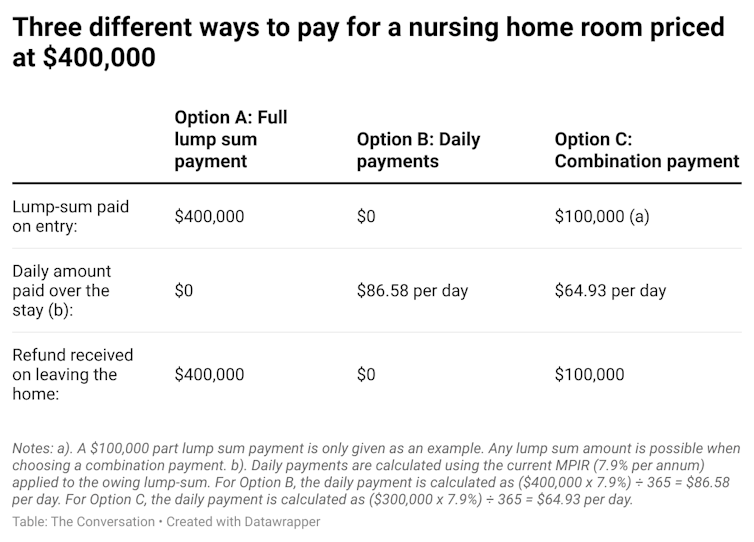
So which is best? It’s impossible to say. It depends on a person’s circumstances, family situation, finances, preferences and expected length of stay.
Why Do Some People Choose A Lump Sum?
One downside of a lump sum (or part lump sum) is that choosing this option means this money is not invested elsewhere.
By handing over the lump sum, for example, you forgo returns you could have made by investing this same money into property or stocks over the period of your nursing home stay.
On the other hand, paying lump sum means you get to avoid the daily interest payments (the 7.9% in the table above).
So you could potentially be better off paying a lump sum if you think there’s no way you could make investment returns on that money that are substantially higher than the interest you’d be charged through daily payments.
One advantage of choosing a lump sum is it’s considered an exempt asset for pension purposes; some people may get more pension if they pay the lump sum.
The lump sum, however, does count as an asset in determining the means-tested care fee.
And if you sell your house, remember any money leftover after you pay the lump sum will be counted as assets when you’re means-tested for the pension and means-tested care fee.
Why Might Some People Prefer Daily Payments?
Not everyone can can afford a lump sum. Some may not want to sell their home to pay one. Some may want to hold onto their house if they think property prices may increase in the future.
Daily payments have recently overtaken lump sums as the most popular payment option, with 43% of people paying this way. However, recent interest rate rises may slow or reverse this trend.
And if a spouse or “protected person” – such as a dependant or relative that meets certain criteria – is still living in the house, it’s also exempt from assets tests for the pension and other aged care fees.
If the home is vacated by a protected person, its value is still excluded from the pension means test for two years (although rental income is still assessed).
If you do not anticipate a lengthy nursing home stay, daily payments may potentially be the easiest option. But it’s best to consult a financial adviser.

What Does The Research Say?
My research with colleagues found many people choose the lump sum option simply because they can afford to.
Those owning residential property are more likely to pay a lump sum, mostly because they can sell a house to get the money.
People who consult financial advisers are also more likely to choose lump sums. This may be due to financial advice suggesting it’s tough to earn investment returns higher than what you’d save by avoiding the interest charged in the daily payment option.
Some aged care providers prefer lump sum payment since they use these to renovate or refurbish their facilities. But providers are not allowed to influence or control your decision on how to pay.
The recent Royal Commission into Aged Care recommended phasing out lump sums as a payment option, leaving only daily payments. While that would reduce the complexity of the payment decision and remove the incentive for providers to sway decisions, it would also reduce consumer choice.
Is There Anything Else I Should Know?
Some 60% of people we surveyed found the decision complex, while 54% said it was stressful.
It is best to seek professional financial advice before you decide.
Services Australia also runs a free Financial Information Service that can help you better understand your finances and the payment decision. But it does not give financial advice or prepare plans.
You have 28 days to choose a payment method after admission, and six months to pay if you choose a lump-sum payment.
In the interim, you will be charged daily interest payments on the room price.![]()
Anam Bilgrami, Research Fellow, Macquarie University Centre for the Health Economy, Macquarie University
This article is republished from The Conversation under a Creative Commons license. Read the original article.
Ketone drinks: why we’re testing the effects of this supplement used by elite athletes on older adults
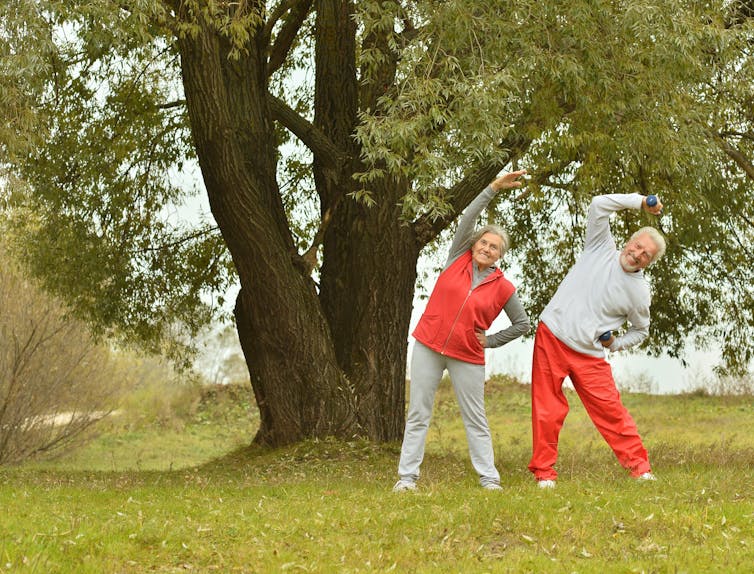
Ketone drinks are used by elite athletes to improve focus and enhance performance. But could they also help people to live healthier for longer?
Considered “super fuels” among some endurance athletes and health enthusiasts, ketone drinks are now being tested in clinical trials for a range of conditions including Parkinson’s disease, type 2 diabetes and heart failure.
Ketones are natural molecules that are produced by the body for energy. Research shows they have profound effects on our physiology, influencing metabolism, immunity and possibly even ageing.
Ketones are produced by the liver when the body faces a shortage of glucose (sugar). This happens during periods of fasting, prolonged exercise or when eating a very low-carbohydrate “ketogenic diet”. Under these conditions, the liver converts fats to ketones which are then used to provide a critical fuel for tissues such as the heart and the brain.
Following a ketogenic diet or fasting can be difficult. Keto diets are restrictive, allowing a maximum of 50g of carbs per day – about the amount you’d find in two bananas.
Ketone drinks offer a way to deliver ketones to the body without having to cut carbs. Research has shown that these drinks can enhance cognitive function, regulate blood sugar and improve blood vessel function in adults with obesity and type 2 diabetes.
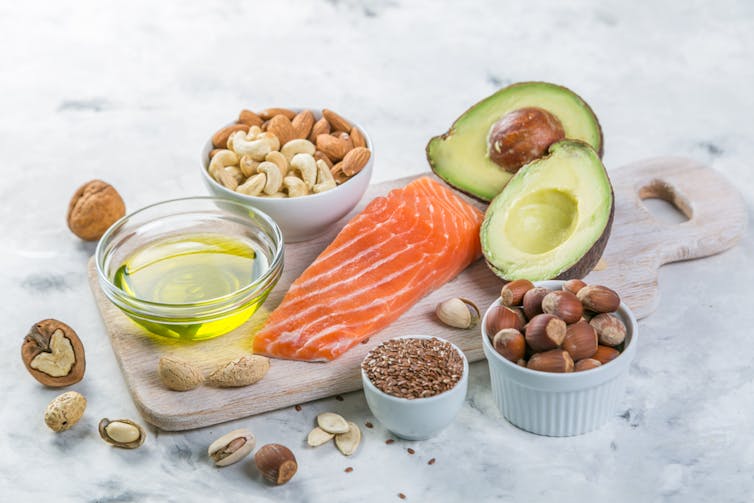
We’ll Know In 18 Months
In a new study being launched at the University of Bath, my colleagues and I now want to explore the effects of ketone drinks on health in older adults.
As we age, our immune, metabolic and cognitive systems naturally decline, leading to frailty and increased risk of disease. These changes can lower quality of life and reduce healthspan – the number of years we live in good health. This new study aims to investigate whether consuming a ketone drink three times a day for four weeks can improve physical and cognitive health in older adults.
During the experiment, participants will undergo tests over two weeks (to establish their baseline measurements) before starting the four-week supplementation period. During this time, they will consume either a ketone drink or a placebo three times a day, while their blood sugar control, physical activity and heart rate are monitored.
Before and after the supplementation period, we will collect blood, breath and fat tissue samples to measure markers of metabolic health, inflammation and immune function. Participants will also complete cognitive tests, physical function assessments and quality-of-life questionnaires.
The ketone drink we have chosen for this study uses a ketone monoester, which is widely used in human studies because of its ability to rapidly raise blood ketone levels. But it has some drawbacks. It has an unpleasant taste, which means people might drop out, and it’s expensive.
While two and four weeks of ketone supplementation has shown positive outcomes in adults with obesity and with type 2 diabetes, there is a lack of supplementation studies focused on older adults. Also, the effects of regular ketone supplementation on our fat tissue, a key contributor to low-level chronic inflammation in ageing, remain unexplored.
The results of this study, expected in 18 months, will shed light on these important areas.
With global populations increasingly ageing, finding ways to help people live healthier for longer is becoming ever more pressing. Ketone drinks could be part of the solution, allowing us to tap some of the benefits of fasting and ketogenic diets without enduring dietary restrictions.
As we continue to recruit participants for our study, we are excited to explore the potential for ketone drinks to help people age better. This study aims to offer a “proof of principle”, which we hope will contribute to the research in this exciting field.![]()
Anna Nicholas, PhD Candidate in Nutrition & Metabolism, University of Bath
This article is republished from The Conversation under a Creative Commons license. Read the original article.
Counting the wrong sheep: why trouble sleeping is about more than just individual lifestyles and habits
Mary Breheny, Te Herenga Waka — Victoria University of Wellington and Rosie Gibson, Massey UniversitySleep may seem straightforward – everyone does it, after all. But as many of us know, getting enough sleep is not necessarily a simple task, despite what you might read in the media.
How to sleep “properly” is a favourite topic of self-help articles, with headlines such as “Expert advice to get a good night’s sleep whatever your age” promising the answer to your nocturnal awakenings.
Older people are commonly the audience of these messages. Our analysis of articles published in the New Zealand media between 2018 and 2021 found sleep is presented as inevitably declining with age.
At the same time, sleep is portrayed as a cure for everything: a good night’s sleep is depicted as a way to maintain productivity, ward off illness and dementia, and ultimately live longer.
But most of these articles are aimed at the individual and what they can do to improve their sleep. Often missing is any reference to the external factors that can contribute to poor sleep.

Personal Choice And Sleep
A key message in many of the articles we examined is that sleep is a simple matter of making the right choices. So, if you’re not getting enough sleep it’s probably your own fault.
People are lectured about poor “sleep hygiene” – staying up too late looking at their phone, having too many cups of coffee, or not getting enough exercise during the day.
And it’s true, drinking too much caffeine or staring at a screen into the small hours might interfere with sleep. It’s also true that good sleep is important for good health.
But things are a bit more complicated than this. As anyone who has struggled to maintain good sleep knows, simple tips don’t always overcome the complex situations that contribute to these struggles.
Awake To Other Factors
Good sleep is not just a matter of “making the right choices”. Internationally, there’s a growing body of research showing sleep is affected by much more than individual behaviour: it’s often shaped by a person’s social and economic circumstances.
New Zealand research is adding to this pool of knowledge. One study, based on survey results from just over 4,000 people, found insufficient sleep was more common among Māori than non-Māori, partly due to higher rates of night work.
International research has also found women are more likely to experience insomnia due to their caregiving roles.
One US study found unpaid caregivers for children or parents (or both) reported shorter sleep quantity and poorer sleep quality than paid caregivers or people without such roles. A survey of 526 carers in New Zealand showed two-thirds reported mild or severe sleep disturbance.
We also know lack of sleep is linked to serious disease, including diabetes and heart disease. Sleep duration and quality have been identified as predictors of levels of haemoglobin A1c, an important marker of blood sugar control.
And hypertension, stroke, coronary heart disease and irregular heartbeats have been found to be more common among those with disordered sleep than those without sleep abnormalities.
Failure to acknowledge the social context of poor sleep means sleep messages in the media ignore the fundamental causes in favour of the illusion of a quick fix.
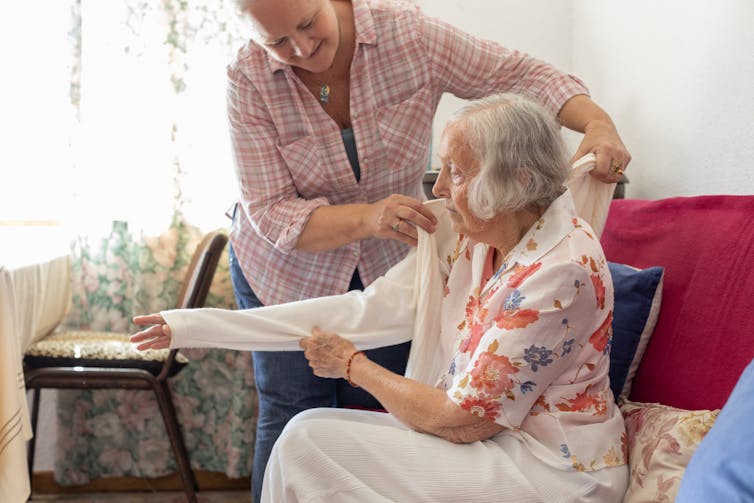
The Commodification Of Sleep
Sleep is also increasingly characterised as a commodity, with a growing market for products – such as sleep trackers – that claim to help improve sleep quality.
Sleep trackers promise to measure and enhance sleep performance. However, their reliability may be limited – one study found the tested tracker did not accurately detect sleep, particularly in older adults who had greater levels of nighttime movement.
Framing public health problems as matters of personal choice is common. Alcohol and fast-food consumption, for example, are regularly presented as matters of individual responsibility and poor personal choices. The role of marketing and access to healthy food gets a lot less attention.
Of course, simple tips for getting good sleep may be useful for some people. But ignoring the underlying social and economic factors that shape the possibilities for good sleep will not address the problem.
Health promotion messages that focus on individual behaviour miss the structural barriers to better health, including poverty, low levels of education, high rates of incarceration, substandard or crowded housing and racism.
We need to move beyond messages of individual behaviour change and start talking about inequities that contribute to the problem of who gets a decent night’s sleep and who doesn’t.![]()
Mary Breheny, Associate Professor of Health Psychology, Te Herenga Waka — Victoria University of Wellington and Rosie Gibson, Senior lecturer, School of Psychology, Massey University, Massey University
This article is republished from The Conversation under a Creative Commons license. Read the original article.
10,000 Older Patients To Avoid EDs: Urgent Care Services Expand Across Sydney: Northern Sydney Local Health District Included
 Around 10,000 older patients will have access to more tailored and timely healthcare in the comfort of their own home, to relieve pressure on hospitals and avoid unnecessary trips to the emergency department.
Around 10,000 older patients will have access to more tailored and timely healthcare in the comfort of their own home, to relieve pressure on hospitals and avoid unnecessary trips to the emergency department.Mapping The Future Of Cancer Care In NSW
NSW Finalists Of The Excellence In Nursing And Midwifery Awards Announced
From Down Under To Underground: Surprising Daddy Long-Legs Spiders Discovered In Australia And Réunion
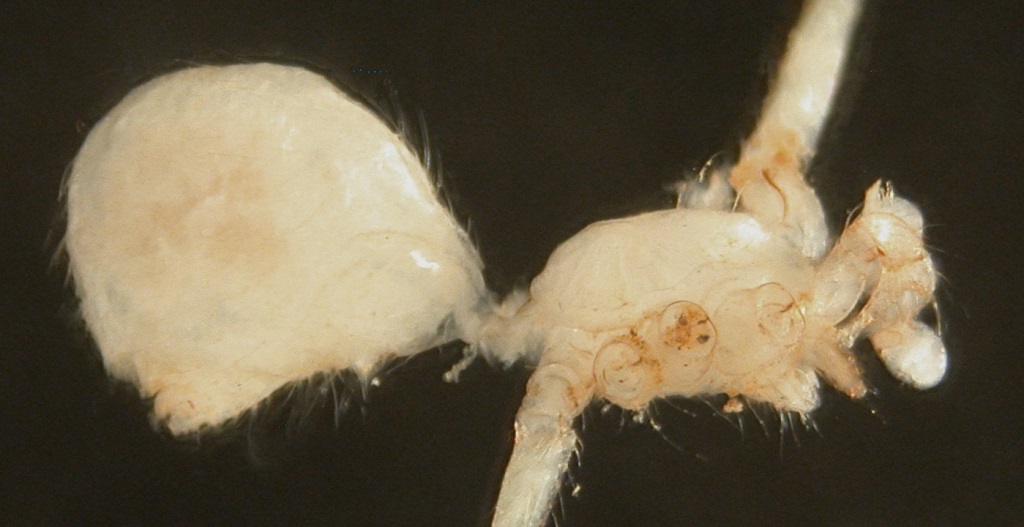
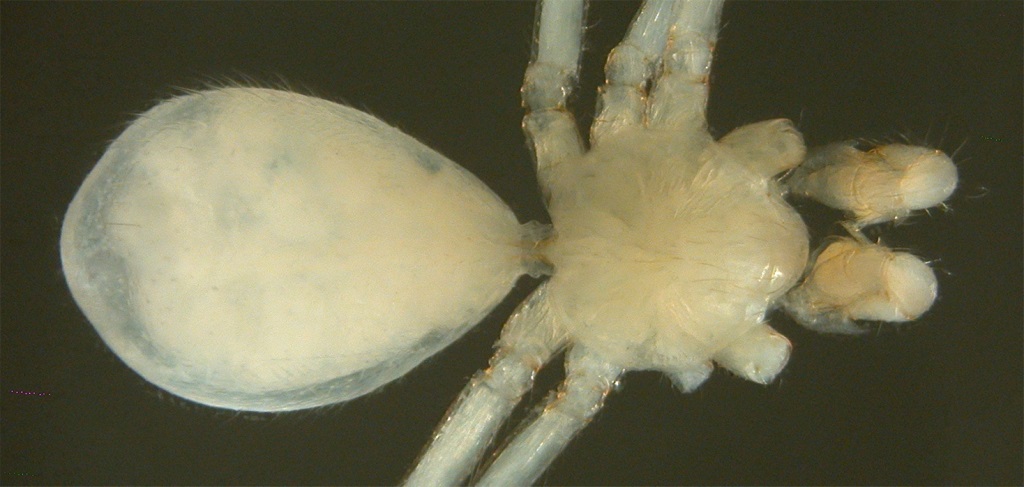
Monash's Immune Cell Discovery Could Lead To Improved Chronic Worm Treatment
AIDA And AMA Sign Agreement To Help Close Indigenous Health Gap
Breaking Down The Barriers To Achieving Gender Equity In Healthcare Leadership
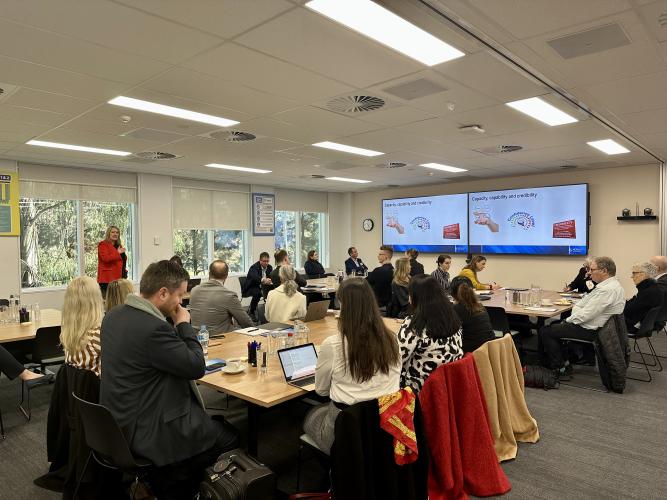 Australian Medical Association leaders meet today with Monash University’s Advancing Women in Healthcare Leadership (AWHL) team, to present progress on a national partnership in breaking down the barriers that prevent women taking on leadership roles.
Australian Medical Association leaders meet today with Monash University’s Advancing Women in Healthcare Leadership (AWHL) team, to present progress on a national partnership in breaking down the barriers that prevent women taking on leadership roles. AMA NSW: Pharmacy UTI Prescribing Clinical Trial Misses The Mark For Quality Care
- there is an increase in antibiotic use amongst patients
- patients accessing the trial would have otherwise accessed an emergency department
- patients would simply have managed the condition themselves
- a patient’s GP will receive notification regarding what has been prescribed by a pharmacist to ensure safe prescribing practices in future as well as an opportunity to investigate underlying health issues
- this is an appropriate use of resources
ACCC: $20m Penalty For Meta Companies For Conduct Liable To Mislead Consumers About Use Of Their Data
.jpg?timestamp=1691039011168)

ACCC: Record Penalties Of $438m Ordered Against Phoenix Institute And CTI For Acting Unconscionably And Misleading Students
ACCC: Australian Banks Allowed To Collaborate On Development Of Industry Standards To Combat Scams
Bid-rigging is rife in Australian construction, but the process itself is partly to blame

Earlier this year the Federal Court found ARM Architecture and its then managing director Tony Allen were guilty of attempting to rig bids for a tender relating to a $250 million building project at Charles Darwin University.
The Court ordered ARM Architecture to pay a penalty of $900,000 and Mr Allen to pay $75,000.
In a public statement, Mr Allen said he had made
a very serious mistake by attempting to induce the other firms to engage in bid-rigging, and this has had serious consequences for me. I have lost my position, my reputation, and my involvement in a profession that I love.
Allen had sent an email to at least eight other architecture firms that were members of the Australian Institute of Architects Victorian Branch Large Practice Forum prior to the close of bids:
Our request to you is simple. Please do not submit a tender as we are relying very heavily on continuing with this project to keep our practice alive throughout the remainder of this strange and difficult COVID time.
He had followed it up with this second email:
We have received very positive responses from Architectus and JWA. We would greatly appreciate a short note from you to let us know of your intentions either way.`
The Biggest Fine For Architects So Far
Although colluding in bidding for contracts is rife in the construction industry and materials supply industries, this is the biggest fine so far for an individual professional services firm.
In Australia, the Australian Competition and Consumer Commission managed to successfully prosecute Cement Australia Pty Ltd in 2017 for anti-competitive practices resulting in a fine of $20.6 million.
And in the United Kingdom, so many construction firms were involved in massive bid-rigging scandals uncovered in 2008 and 2020, that the UK government had to warn its agencies not to blacklist them because it would “limit choice”.
Fees Used To Be Fixed
In the supposedly more genteel design professions, submitting tenders for fees is relatively new. Until about 40 years ago, architects and engineers normally worked on a fixed-fee basis, and often made deals to divide work between them.
The Royal Institute of British Architects, founded in 1834, was set up primarily as a cartel to maintain a schedule of fees and prescribe educational standards for those who wanted to use the term “architect”.
Although fixed fees are likely to upset economists on principle, they have the advantage of not encouraging architects to shortcut their professional responsibilities in order to compete on price.
This might be why the law allows medical professionals, lawyers and pharmacists to set fees for their services. Few people would be tempted to select their surgeon on the basis of price.
Until about 1980, the Royal Australian Institute of Architects also attempted to fix fees. When the government gently pointed out that this was illegal under trade practices law, the Institute began a long, slow retreat and eventually stopped publishing a recommended fee scale, much to the chagrin of many members.
Competitive tendering is typically seen as the “gold standard” for getting value in construction, but tendering processes have become so onerous and convoluted that the costs of tendering in relation to the potential gains may now be reducing rather than enhancing competition.
This is especially significant for design consultants such as architects and engineers whose profitability is typically well below average for the industry.

Bidding Processes Convoluted
The Charles Darwin University project is a case in point. ARM was selected to design what was to be an “iconic” building, but documentation of the design was to be the subject of a second tender, which was the subject of ARM’s emails.
This two-stage process, devised by a project management firm, was self-defeating.
Charles Darwin University wanted a highly-awarded architect to deliver an iconic building, but much of the design ARM contributed has been lost.
The images of the new building, produced by another firm, do not resemble the original ARM design and are not the stuff architectural icons are made of.

ARM and Tony Allen have paid a very high price for their folly in asking other firms not to tender, but the project management firm that devised the expensive and ultimately unproductive double tender process has not been subject to any public scrutiny or criticism.
If we are going to have fee tenders, we need a transparent system with enforceable rules sufficient to stop public clients needlessly adding costs by wasteful convolutions, as happened with the Charles Darwin University double tender.
Maybe There’s A Better Way
Alternatives should to be considered. It ought to be possible for the client to nominate a reasonable fee, and then select consultants who will accept the nominated fee based purely on their merit.
Another possibility is a two-envelope system, where the fee and the quality of submission are assessed separately, with the fee envelope only opened when an evaluation of the quality of submissions has taken place.
Other than that, we could do worse than revert to a fixed percentage fee and reap a huge saving in the effort, time and money put into selection processes. Free-market economists might like to think about how much competitive tenders actually cost.![]()
Geoff Hanmer, Adjunct professor of architecture, University of Adelaide
This article is republished from The Conversation under a Creative Commons license. Read the original article.
What is food protein-induced enterocolitis syndrome or FPIES? And are more babies getting it?

Parents, carers and childcare settings are much more aware of food allergies than they once were. Precautions are taken and emergency plans can be developed for each child at risk of a reaction. But fewer people have heard of food protein-induced enterocolitis syndrome (FPIES).
FPIES is a poorly understood food allergy that mostly affects infants. It can be caused by a variety of foods including some not usually associated with food allergies like rice, oats and vegetables. Other causes are more typical of food allergies, like cow’s milk and egg. The most common symptom is profuse, repetitive vomiting one to four hours after eating the food.
Reactions can be dramatic and worrying for parents, with infants becoming pale, lethargic (sleepy) and floppy. In severe cases, infants develop dehydration and low blood pressure. The diagnosis is often not made the first time a reaction occurs, because of the wide range of diseases which can cause these symptoms and the time delay between when a trigger food is ingested and the onset of symptoms.
Until recently, FPIES was thought to be rare, but new evidence suggests it is more common than previously thought. The past decade has also seen significant research efforts trying to identify what part of the immune system is responsible for causing FPIES reactions, to identify better tests for diagnosis and management.
What Is It That Causes Symptoms?
We don’t currently know much about the immune dysregulation that causes FPIES.
FPIES is classified as a non-IgE mediated food allergy, differing from other types of more common food allergy like peanut allergy, where reactions are caused by allergy antibodies that can be detected in the blood.
That also means medications used for treatment of these types of allergies (such as EpiPens and antihistamine) do not work in FPIES. Recent studies suggest another part of the immune system, called the innate system might be involved. This system is the body’s first line of defence against potential invaders. It includes bacteria that fights off bugs or injuries, rather than cells that adapt to respond to threats.
Missed Cases?
Symptoms of FPIES can be mistaken for other conditions such as gastroenteritis (“gastro”), twisted bowel or serious blood infections. This can delay diagnosis.
Unlike most other types of food allergies, which have reactions caused by allergy antibodies, there is no blood test to diagnose FPIES. Diagnosis relies on careful clinical history and may require a specialised oral food challenge. This can involve removing foods suspected of causing a reaction from the diet and then reintroducing them one-by-one in planned stages under medical supervision.
How Common Is FPIES And Is It Becoming More Common?
Because it is under-recognised and difficult to diagnose, estimates of FPIES prevalence vary considerably – between 0.015% to 0.7% of infants.
Although data is sparse, some studies report an increase in rates of FPIES. A study of Australian and New Zealand hospital data reported hospital admissions had tripled for infants with symptoms consistent with potential FPIES between 1998 and 2014.
An increasing awareness of FPIES, as well as improvements in diagnosis, mean FPIES diagnoses may increase without a true increase in the condition. Different estimates of FPIES rates between countries (for example 0.15% in Australia and 0.7% in Spain) may be due to true differences or variations in diagnosis and reporting. More research is needed to understand these differences.

What Foods Trigger FPIES?
Different foods appear to commonly cause FPIES in different countries. In Australia, rice is the most reported FPIES trigger, with cow’s milk, soy and eggs also common. Cow’s milk is the most common reported trigger in the United States and Europe. Fish is a common trigger reported in Mediterranean countries, and increasingly reported as a cause of FPIES in older children and adults. It is unclear what causes these differences, which may only be partially explained by differences in infant feeding and weaning practices between countries.
Reactions often occur for the first time in infancy with the introduction of a new food, either on the first exposure or after the first few exposures. Most affected babies only react to a single food, although some foods cross-react. This means infants have a similar response to related foods such as with grains (rice and oats); cow’s milk and soy; fish and shellfish. Those with FPIES need to avoid the foods that trigger FPIES reactions, but there is often no need to avoid other non-related foods.
Most children will outgrow FPIES in their first few years of life. There appear to be differences in how quickly FPIES resolves depending on the trigger food, with cow’s milk and grains FPIES resolving more quickly than egg and seafood FPIES. Adults can also develop FPIES, however this is less common.
What To Do If You Suspect You Or Your Child Has FPIES
If you think that you or your child may have FPIES, talk to your doctor. They may recommend a referral to an allergist for assessment.
The next step may be developing an action plan for a FPIES reaction. For severe reactions, such as when an infant becomes dehydrated or floppy after vomiting or diarrhoea, seek specialist care at your closest hospital emergency department. ![]()
Jennifer Koplin, Group Leader, Childhood Allergy & Epidemiology, The University of Queensland; Dianne Campbell, Professor, Child and Adolescent Health, Faculty of Medicine and Health,, University of Sydney, and Eric Lee, Department of Allergy & Immunology at the Children's Hospital at Westmead, University of Sydney
This article is republished from The Conversation under a Creative Commons license. Read the original article.
A drink each day or just on the weekends? Here’s why alcohol-free days are important

In recent years, drinkers have become more aware of the health dangers of drinking alcohol, from disease to risky behaviour and poorer wellbeing. Events like the just-finished Dry July, Febfast and Hello Sunday Morning – when people voluntarily abstain from alcohol for periods of time – are growing in popularity and raise awareness about the risks involved in overindulgence.
Many people extend these alcohol-free periods throughout the year by incorporating alcohol-free days into their weekly routines, while still enjoying a drink on the weekends.
But does drinking the same amount spread over the week versus just on the weekends, make any difference health-wise?
How Much Is Too Much?
Australian alcohol guidelines and the World Health Organization state there is no safe level of alcohol use. For adults who do drink, the guidelines recommend a maximum of four drinks in one sitting or ten in a week. (A zero-alcohol approach is recommended for under-18s and during pregnancy.)
For some, this may not sound like much at all. One in four Australians exceed the recommendation of no more than four drinks in one session with men more likely to do so than women. This amount can result in alcohol poisoning, damage to brain cells and a higher likelihood of engaging in risky behaviours leading to violence, accidents and unprotected sex.

But What About A Wine Each Night?
Even abiding by the Australian alcohol guidelines and drinking in moderation – one or two drinks each day over the week – can be risky. Possible health outcomes of moderated drinking include increased risk of cancer, liver and heart disease, alcohol use disorder, and an increase in the symptoms of anxiety and depression.
Everyone processes alcohol at a different rate depending on age, gender, body shape and size. However, for most people, alcohol can still be detected in the blood 12 hours after consumption. When the body is constantly processing the toxins in alcohol, it can lead to a chronic state of inflammation which is linked to physical and mental health risks.
There are several biological mechanisms associated with alcohol’s impact on the brain. Alcohol destroys the fine balance of the bacteria in the gut microbiome, which has been linked to brain health.
Alcohol consumption disrupts the function of the amygdala – a part of the brain important for processing and regulating emotion, including our fear response. When this is impaired we are less likely to pay attention to our fears and more likely to engage in risk-taking behaviour.
Areas involved in language production and comprehension are also affected by alcohol, with too much leading to slurred speech and the inability to comprehend communication from others. When drinking dulls frontal lobe brain function, it can can lead to changes in personality for some people. Blackouts can occur from the influence of alcohol on the hippocampus.
So, No Drinking Then?
While sobriety may be the answer for optimal health, depriving ourselves of the things we enjoy can also lead to negative mental health and a higher likelihood we will binge in the future. This is why alcohol-free days are becoming so popular, to balance health risks while also giving us the chance to enjoy social activities.
Including alcohol-free days in your routine can give the body a chance to rehydrate, detoxify and repair itself from the toxic properties of alcohol. Detoxification can lead to improved liver function and sleep quality, less water retention and easier weight control, clearer thinking, improved memory, more energy, clearer skin, a strengthened immune system and decrease symptoms of anxiety and depression.
Alcohol-free days can also create a domino effect by encouraging other healthy behaviours like eating more fruits and vegetables, drinking more water, improved sleep patterns and getting up early to exercise.
6 Tips For Better Drinking Balance
If you’re looking to incorporate more alcohol-free days into your routine you could try to
- set realistic goals. Clarify how many and what days will be your alcohol-free days, mark them on a calendar and set reminders on your phone
- plan alcohol-free activities and find alcohol alternatives. List all the activities you like that do not include drinking and plan to do these at the times of the day you would normally drink
- make alcohol “invisible”. Keeping beer out of the fridge and wine and spirits in closed cupboards keeps them from the forefront of your mind
- seek support and encouragement from your partner and/or family
- incorporate stress management techniques like meditation and mindfulness. Observe how you feel on alcohol-free days and note positive changes in your physical and mental wellbeing
- reflect on your progress. Acknowledge and celebrate each alcohol-free day. Allow yourself non-alcoholic rewards for achieving your goals.
Finally, it’s important to know everyone slips up now and then. Practice self-forgiveness if you do have a drink on a planned alcohol-free day and don’t give up. ![]()
Megan Lee, Senior Teaching Fellow, Psychology, Bond University and Emily Roberts, PhD Candidate, Psychology, Bond University
This article is republished from The Conversation under a Creative Commons license. Read the original article.
Disclaimer: These articles are not intended to provide medical advice, diagnosis or treatment. Views expressed here do not necessarily reflect those of Pittwater Online News or its staff.